1 Volumes
Philadephia: America's Capital, 1774-1800
The Continental Congress met in Philadelphia from 1774 to 1788. Next, the new republic had its capital here from 1790 to 1800. Thoroughly Quaker Philadelphia was in the center of the founding twenty-five years when, and where, the enduring political institutions of America emerged.
Military Philadelphia
.
City Troop
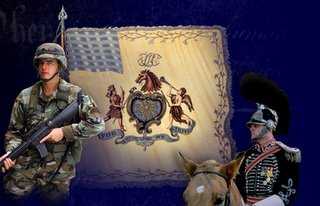
|
| First Troop, Philadelphia City Cavalry (FTPCC) |
On 23rd Street, just South of Market, stands a gloomy Victorian castle with big doors opening to the street. It's the armory, housing the First Troop, Philadelphia City Cavalry (FTPCC). The organization is a real fighting unit of the Pennsylvania National Guard, participating with distinction in every war America has fought. Originally a horse cavalry, the unit now drives tanks, except for recreation and on ceremonial occasions. It lays claim to being the oldest military unit in America, although there have been several minor name changes since the days when the City Troop accompanied General Washington to take command of the troops in Boston. Their dress uniforms are pretty splashy, especially on horseback, and they have to pay for them, themselves.
Furthermore, they are required to donate all of their military pay toward the upkeep of the unit and its activities. Although the first step in membership is to become a real member of the National Guard, election to the Troop itself is truly an election, carefully screened after prospective members have been observed and evaluated at invited Troop functions. These soldiers are wealthy, athletic, mostly pretty handsome, and almost invariably well-connected socially. You could almost make up the rest from these essential ingredients. This is the innermost core of Philadelphia society, and it is intensely and sincerely patriotic.
Others have noticed that National Guard duty itself takes up many weekends and much of summer vacation. Add to that the many Troop dinners, the horsemanship activities, the debutante balls, the Chesapeake sailing cruises, the national and local ceremonies, the weddings and funerals for members -- and actually fighting wars overseas. The members of the Troop spend so much of their time on Troop-related activities, that they become both intensely loyal to each other, and necessarily somewhat withdrawn from other people. They gravitate to polo, the Racquet Club, the Savoy, the Orpheus, and the financial world.
There may be an important insight into the generation turmoils to be derived from this. There was once a time when most professions likewise absorbed the lives of their members, with professional clubs and entertainments confining the social life of the member by leaving little time for anything else. But in recent years most occupational and professional societies are experiencing a loss of membership and enthusiasm, leading to the bewildering question of "Where are the younger members, any more?" The pre-fabricated answer is that younger people now want to devote their quality time to their families, but if you believe that, you will believe anything. Let's face it; when one activity absorbs all of your time, it confines you. There have to be some important benefits to being so confined, and even so, it chafes a little. Those of us who are not baby boomers can see that being a slave to intra-generational consensus is only to be a slave in a different way. The remarkable thing is that the baby boomers fail to see it, themselves.
Mrs. Meade's House
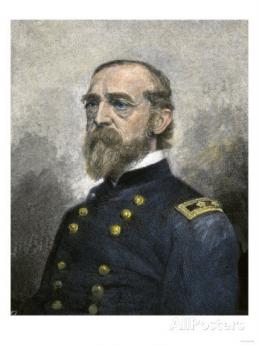
|
|
Union General George Gordon Meade |
General George Gordon Meade, the hero of Gettysburg, lived in quite an elegant house during the six years (1866-72) he was a Commissioner of Fairmount Park. The house (at 19th and Delancey) has "MEADE" carved over the stately entrance facing 19th Street, and while the neighborhood has run down somewhat, it was obviously once an imposing mansion. The house belonged to Mrs. Meade. From that, you might suppose that the General had married a rich woman, but that would be wrong.
When General Lee was advancing on Gettysburg, it was widely supposed that his goal was to conquer Philadelphia, the Arsenal of the North. The town was in a panic, built some forts on the Schuylkill to defend itself, and later lionized the hometown hero who had saved them. Mrs. Meade was living at the time in a modest little place, and the town fathers took up a collection to buy General Meade a proper house.
A delegation of officials traveled down to Virginia to present him with their gift of gratitude, but Meade would have none of it. He was only doing his duty, and could not consider for a moment accepting major gifts for his soldiering. No, he was very sorry, he had to decline.
So the delegation came home, all a fluster. Someone then had the idea of offering the house to Mrs. Meade. And when they visited her, she promptly said "Sure."
Tales of the Troop
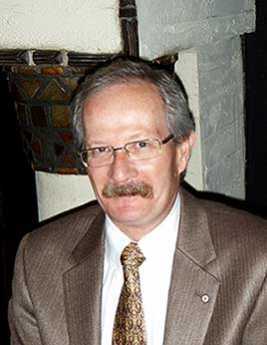 |
| Dennis Boylan |
Dennis Boylan, the former commander of the First Troop, Philadelphia City Cavalry, has been poking around in the archives up at the Armory, and was invited to tell the Right Angle Club about it. In all its history, there have only been 2500 members of the troop, but they have been a colorful lot, leaving lots of history in bits and pieces. The troop boasts that it has seen active duty in every armed conflict of America, and means to continue to fight as a unit of the Pennsylvania National Guard. However, we have lately had so many actions, the troop has had to split off units to be able to go to the Sinai Peninsula, Bosnia, Kosovo, Iraq, Afghanistan and whatever is going to come next. An eighteen month tour of active duty takes a lot out of a citizen soldier's life, but no one is complaining, and there is no fall-off in volunteers.
Although most troopers are polite and taciturn, it is probably hard to remain unaffected by association with people like A.J. Drexel Biddle, a pioneer of the bayonet and hand-to-hand fighting, much sought after for training other units of the military. Or George C.Thomas, who was a golf course architect, but also a seaplane expert, responsible for the seaplane ramps next to the Corinthian Yacht Club along Delaware. Or Rodman Wannamaker, responsible for aeronautic development, also down in the marshes where the Schuylkill joins Delaware. Robert Glendinning, who was notable for other adventures, was also an early pioneer in airplanes. As a matter of fact, Henry Watt had himself flown from Society Hill to Wall Street in a seaplane, when he was President of the New York Stock Exchange.
It's hard to believe, but a former trooper named Eadweard Muybridge distinguished himself in the art world, as a result of a bet with Leland Stopford, that a horse at a gallop reaches a point where all four feet are simultaneously off the ground. The consequence was a famous set of rapid-sequence photographs which are quite famous at the Pennsylvania Academy of Fine Arts. There are elephants, horses, people in various states of undress which remain as interesting artworks as well as scientific evidence that horses feet do indeed leave the ground. But in case anyone believes that Muybridge was some sort of sissy from the art world, there is the story that he caught his wife in an affair and shot the other man dead. As one might expect, the jury found him not guilty, on the grounds of justifiable homicide. With a name like Eadwaerd, it's probably necessary to demonstrate your manliness.
Robert Glendinning, class of 1888 at Penn, became Governor of the New York Stock Exchange, founded Chestnut Hill Hospital and the Philadelphia School for the Deaf. And Thomas Leiper makes a pretty good claim for starting the first railroad in America. It was only 2 miles long, in Swarthmore, and built because he was not permitted to extend his canal for the purpose of transporting stone from upstate quarries. The railroad developed into the Pennsylvania Railroad; Leiper's house, "Strathaven" is still an important Delaware County landmark.
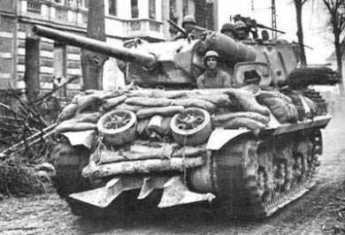 |
| Tank in Philadelphia |
And then, there's the story of the salute to the QE2. When the liner made a tour up the Delaware, a search was made for cannons to provide a proper salute, and the call came to the Troop. Well, they had a tank, and they could fit a simulator on the tank's gun. So, the tank rumbled down Broad street to do its duty. South Philadelphia responded in character, too. Instead of stopping to admire the novelty of a moving tank, the drivers just honked their horns and drove around it.
The Quaker Who Would Be King
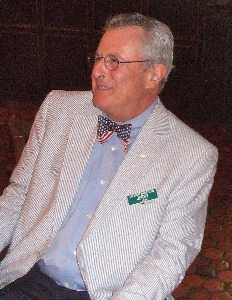
|
| Jerry Leon |
Once every year or two, a speaker at the Right Angle Club fails to show up. That happened recently, and as usually happens, one of the members stood right up to the microphone and gave an impromptu speech. The volunteer was Jerry Leon, who surprised us all by announcing he spent thirteen years in the Marines as a fighter pilot on aircraft carriers. You would never guess that from his behavior as a successful businessman, and to some extent that was his whole point.
In the first place, he volunteered as a Marine during the Korean War, and worked his way through boot camp and all that, until one day an officer brought them all to attention, asking for volunteers to fly airplanes. After flight training school, he might have flown air freight or eight-engine bombers, but he volunteered to fly fighter planes off the deck of an aircraft carrier. In those days, the carrier plane was fired by a steam driven catapult off the flight deck like a projectile. You go from zero speed to two hundred miles an hour in two or three seconds; the experience is arresting. After he recovers his wits, the pilot is expected to take sole control of the plane, fly around the carrier a few times, and then land the plane on the postage stamp flight deck. Fighter planes come in at a lower altitude than commercial aircraft, and steeper, and faster. The tailhook catches one of the three wires across the deck, and then the plane jolts to a stop. Or not, in which case the pilot must retake immediate control, take off at full speed, circle the carrier, and try it again. That's hard enough on a calm sea, but the Navy never stops for rough weather, so at night in rough seas, you have to do it in the dark with the ship rising, falling, pitching and yawing, right or left in three dimensions. That's somewhat harder. There are usually four planes in the air at any one time, all doing the same thing every ninety seconds, and if the plane runs off the end of the landing strip the pilot must remember to eject before he goes down with the plane. This whole process must be repeated six times in one day with only one aborted landing, in order to qualify for carrier duty. Saying nothing of the sudden bumps and jolts, the process of qualifying is pretty hard on the sphincters, it's pure terror no matter who you are. Like stage fright for an actor, crash landing does seem easier with practice but having done it seven hundred times, Jerry still wasn't able to do it calmly.
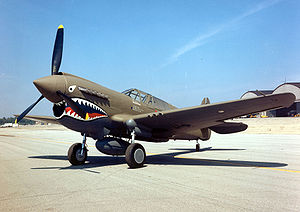
|
| P40 War Hawk |
Unusually good eye/hand coordination is something you are born with, and baseball seems to require the same ability. Ted Williams, the famous .400 hitter for the Boston Red Sox, was an outstanding fighter pilot, and many less famous professional baseball players have also gravitated to the role. To be called a fighter ace a pilot must have shot down five enemy planes, and one pilot became a fighter ace at the Battle of Midway on his first mission. Because of his lack of experience, this pilot was only detailed to hunt for the battleship Yamamoto, but he found it, radioed its location, and on the return flight ran into 30 enemy planes. Tearing into them alone, he shot down five, becoming an ace before he returned to the carrier deck from his first mission. Now there's the killer instinct with eye/hand coordination, the combination which seems to make you an ace. He wasn't alone in these qualities, although 30% of the pilots do seem to account for 90% of the victories. In those days "between W-2 and Korea" the American pilots were flying propeller planes, while the Chinese pilots were flying jets, and even the Germans were flying some jet-powered Messerschmidts. That's five hundred miles an hour versus seven hundred, and the enemy planes would often swoop past in a whoosh. So, the Americans developed a technique. When the jet came up on your tail, you pulled back as hard as you could with all flaps down. The enemy jet pilot had to pull up his nose, flew over the top of the propeller-driven American, and then was blasted out of the air by the prop plane now waiting for him from behind. They say it worked every time, but of course, it only worked for the pilots who came back to talk about it. A former pilot with Chenault once told the story of letting go with fifty-caliber machine guns into the tail of a Zero, causing the Zero and its pilot to vanish into a puff of smoke and debris. Of course, the prop plane then just flew through the cloud.
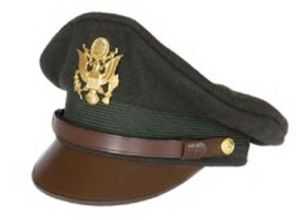
|
| Pilot's Hat |
The fly-boys were of course chased by hordes of women, particularly in the bars around the training school in Pensacola. They drank hard, at reckless heedless parties; it was reported that Australian pilots even had two or three drinks before taking off, but our Navy strictly policed going that far. Nobody saved any money, nobody cared one whit about being promoted or demoted. Getting to be an Admiral was something that attracted what were disdainfully referred to as "politicians". And nobody bragged about his exploits, even to friends and family. What mattered was that word of mouth had carried your exploits to your buddies. The senior George Bush flew a bomber not a fighter plane, but he played baseball like an angel, and you never heard him boast of his adventures; that's a fair approximation of the personality type, although George Bush was unusually tall for a pilot, and clearly better bred. If you can't guess what he thought of Bill Clinton and Ross Perot, it isn't necessary to relate it here.
Somehow, feminist women intruded themselves into this fraternity, and some who seemed well-qualified got hustled along through token promotions. But few women have the real killer instinct, and just getting equal opportunity won't get you through those six gut-wrenching flights in a carrier qualification. Thirteen women pilots were killed in qualification flights before the Secretary of the Navy intervened and put a stop to it. To new entrants from a previously shunned group, achieving the same status as men is a form of promotion, and lusting for promotion is despised by natural-born fighter pilots. It's sort of a Catch-22 situation. What killers want, is to excel at things that are viciously dangerous, getting the esteem of others who tried to do as much and maybe failed; like tournament golf, in this game, you are really playing against yourself. And so this Greek tragedy finally came to a confused pause with the famous Tailgate party incident. To preserve appearances and rescue The Service from the press corps, the Navy brass was shocked, shocked, to discover what was going on. Women weren't being respected if you can believe such a thing of fly-boys.
"Hey, fellas, c'mon. Do you want to win this war or don't you? Professional killers have been behaving like this for centuries. And because you come along, we've got to change and do things your way?"
Battle of the Clouds: September, Remember
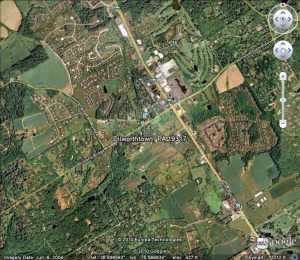
|
| Dilworthtown |
Weather satellites, television and so on have taught us much about hurricanes that was unknown in 1777. Benjamin Franklin, it should be noted, was the first to observe that Atlantic Coast "Nor'easters" actually begin in the South and work North, even though the wind seems to be blowing in the opposite way; what's moving toward the northeast is a low-pressure zone. We now know that hurricanes begin in Africa, travel West and then veer North when they reach Florida. A great deal is still to be learned about hurricanes, but the most important thing about their timing is contained in a maritime jingle:
June, too soon.
July, stand by.
And then: September, remember.
October, all over.
Along the Atlantic east coast, the end of August to the middle of September, is hurricane season. That's when houses blow down in Florida, and heavy rains hit Pennsylvania. Admiral Howe might have had some clue to this, since Franklin made his observation around 1750, and storms are important to Admirals. But very likely his brother the General just thought it was one of those things when the British landing at Elkton, Maryland in late August 1777 was greeted with an unusually severe downpour of rain. Howe had planned to surprise Philadelphia from the rear by hitting the ground running on horseback. However, he underestimated the debilitating effect on the horses of three weeks at sea on sailboats; to unload and forage horses during a hurricane was almost too much for the plan. For that purpose, he had given orders for the troops to disembark without waiting to pitch camp, or unpacking their gear. But the drenching rain gave Washington several extra days to organize a defense, although he has been given too little credit for the strenuous accomplishment of moving an army from Bucks County to the banks of the Brandywine in that weather. Howe, whose trademark was surprise, deception, outflanking, had anticipated a sudden cavalry thrust into the backyards of unprepared Philadelphia. What he got was 2000 casualties in the biggest battle of the Revolutionary War, against Washington's well-prepared defense along the steep-sided Brandywine Creek.
Howe won this battle, in the sense that Washington was forced to withdraw, because Howe employed another British military trademark, of driving his own troops beyond humane limits in a huge outflanking movement. The countryside around Kennett Square is hilly and broken almost to West Chester, and the American Army felt reasonably prepared along a front of ten or twelve miles. But Howe drove the main force of his army seventeen miles to the north, to Dillworthtown, before turning the unprepared American right flank. And, in the now hot August weather in full uniform and battle pack, the drive continued for twenty-four consecutive hours until Washington saw he had to withdraw. This was what the British meant when they boasted of seasoned regular troops; you win by enduring more than your opponent can endure.
One has to have equal admiration for Washington. Although he was dislodged from his position, losing the opportunity to catch the British in a hostile region without a reliable source of supplies once the fleet weighed anchor, he preserved his army of marksmen and deer hunters intact during the retreat. The two armies started at roughly the same size, and Washington had only about 1300 casualties; his men had more certain supply sources, and they were fighting for their homes. The British, somewhat outnumbered, had the prospect of fighting their way without resupply through an enemy's home territory, capturing the enemy's capital, but still facing the possibility that the British fleet might not get past the Delaware River defenses. If that happened, they could celebrate their victory by starving to death. Just about the only weakness of the Continental Army was its discomfort with bayonet warfare. They could hit a squirrel at a hundred yards, but those long bayonets on the end of very long muskets were designed to protect foot soldiers from cavalry charges. It takes training to put the butt of the musket against a stone on the ground, hold your ground against an oncoming gallop of horsemen, and trust that at the last moment the horses will rear back and throw the riders. But it also takes naked bravado to wave a sword and ride full tilt into a forest of pointing bayonets, trusting that at the last moment the defenders will break and run.
But Washington knew what he was doing. He pulled the troops back to Chester, then over the Schuylkill to the Germantown encampment at Fox and Queen Lane, then up the Schuylkill to Norristown, the first ford in the river that Howe must use when the boats and bridges were destroyed. The river would hold the British while the Americans came at them from the rear; this was essentially the same river strategy he used at the battle of Trenton. Washington picked his battlefield in Chester County and got ready to fight the second installment of the Battle of Brandywine. The campus of Immaculata University now occupies the site.
And then it rained, again. Hard. The gunpowder on both sides was soaked, useless. In what has come to be known as the "Battle of the Clouds", the fighting was called off by mutual agreement. The second hurricane of the year had arrived, and Washington more or less helplessly had to watch Howe take over Philadelphia unopposed. He lost the capital, provoking dismay among the colonists, but his masterful strategy taught the British to respect him. When the British were later considering whether to hold or abandon Philadelphia, this growing respect for their adversary helped tilt their thinking toward prudence.
But that was not before Howe once more showed he too was not the lazy slacker that others had called him. General "Mad Anthony" Wayne was dispatched with fifteen hundred troops to hassle the rear of Howe's army. Wayne was confident he could hide his troops in the Radnor area where he had been brought up, but the region in fact had many Torys to report his movements. Howe ordered Major General Lord Charles Grey to take the flints from his troops' muskets, attack the American camp near Paoli's tavern in the night, and use only bayonets. Waynes' troops were scattered and slaughtered, in what came to be known as the Paoli massacre.
Battleship New Jersey: Home is the Sailor

|
Home is the sailor, wrote A. E. Housman, Home from the sea. In this case, the sailor is the Battleship New Jersey. The U.S.S. New Jersey rides at permanent anchor in the Delaware River, tied to the Camden side. You can visit the ship almost any afternoon, and with reservations can even throw a nice cocktail party on the fantail. It's an entertaining thing to do under almost any circumstances, but the trip is more enjoyable if you spend a little time learning about the ship's history. The volunteer guides, many of them still grizzled veterans of the ship's voyages, will be happy to fill in the details.
In the first place, the ship's final bloody battle was whether to moor the ship in the Philadelphia harbor, or New York harbor, when the U.S. Navy had got through using it. You can accomplish that and remain in the state of New Jersey either way, but there's a big social difference between North Jersey and South Jersey, so the negotiations did get a little ugly. Because of the way politics go in Jersey, it wouldn't be surprising if a few bridges and dams had to be built north of Trenton to reconcile the grievance, or possibly a couple of dozen patronage jobs with big salaries but no work requirement. The struggle surely isn't over. Battleships are expensive to maintain, even at parade rest; if you don't paint them, they rust. Current revenues from tourists and souvenirs do not cover the costs, so the matter keeps coming up in corridors of the capitol in Trenton.

Home is the sailor, home from sea:
Home is the hunter from the hill:
'Tis evening on the moorland free, 
|
|
A. E. Housman
R.L.S. |
Battleship design gradually specialized into a transport vehicle for big cannon, ones that can shoot accurately for twenty miles while the platform bounces around on the ocean surface. Situated in turrets in the center of the vessel, they can shoot to both sides. That's also true of armored tanks in the cavalry, of course, with the history in the tank's case of the big guns migrating from the artillery to the cavalry, causing no end of a jurisdictional squabble between officers trained to be aggressive for their teams. Originally, the sort of battleship which John Paul Jones sailed was expected to attack and capture other vessels, shoot rifles down from the rigging, send boarders into the enemy ships with cutlasses in their teeth, and perform numerous other tasks. In time, the battleship got bigger and bigger so in order to blow up other battleships had to sacrifice everything else to sailing speed and size of cannon. Protection of the vessel was important, of course, but in the long run, if something had to be sacrificed for speed and gunpowder, it was self-protection. There's a strange principle at work, here. The longer the ship, the faster it can go. Almost all ocean speed records have been held by the gigantic ocean liners for that reason. If you apply the same idea to a battleship, the heavy armored protection gets necessarily bigger, and heavier as the ship gets longer, and ultimately slows the ship down. As a matter of fact, bigger and bigger engines also make the ship faster, until their weight begins to slow them down. Bigger engines require more fuel and carrying too much of that slows you down, too. Out of all this comes a need for a world empire, to provide fueling stations. Since the Germans didn't have an empire, they had to sacrifice armor for more fuel space and more speed, to compensate for which they had to build bigger guns but fewer of them. Although the British had more ships sunk, they won the battle of Jutland because more German ships were incapacitated. When you are a sailor on one of these ships, it's easy to see how you get interested in design issues which may affect your own future. An underlying principle was that you had to be faster than anything more powerful, and more powerful than anything faster.
The point here is that the New Jersey, as a member of the Iowa class of battleship, was arguably the absolutely best battleship in world history. At 33 knots, it wasn't quite the fastest, its guns weren't quite the biggest, its armor wasn't quite the thickest, but by multiplying the weight of the ship by the length of its guns and dividing by something else you get an index number for the biggest worst ship ever. The Yamamoto and the Bismarck were perhaps a little bigger, but the New Jersey was at least the fastest meanest un-sunk battleship. Air power and nuclear submarines put the battleship out of business so the New Jersey will hold the world battleship title for all time. Strange, when you see it from the Ben Franklin Bridge, it looks comparatively small, even though it could blow up Valley Forge without moving from anchor.
One story is told by Chuck Okamoto, a member of the Green Berets who was sent with a group of eight comrades into a Vietnamese army compound to "extract" an enemy officer for interrogation. When enemy flares lit up the area, it was clear they were facing thousands of agitated enemy soldiers, and Okamoto called for air support. He was told it would take thirty minutes; he replied he only had three minutes, and to his relief was told something could be arranged. Almost immediately the whole area just blew up, turned into a desert in sixty seconds. The guns of the New Jersey, twenty miles away, had picked off the target. The story got more than average attention because Okamoto's father was Lyndon Johnson's personal photographer, and Lyndon called up to congratulate.
A number of similar stories led to the idea that naval gunfire might have destroyed some bridges in Vietnam which cost the Air Force many lost planes vainly trying to bomb, but, as the stories go, the Air Force just wouldn't permit a naval infringement of its turf. This sort of second-guessing is sometimes put down to inter-service rivalry, but it seems more likely to be just another technology story of air power gradually supplanting naval artillery. Plenty of battleships were sunk by bombs and torpedo planes before the battleship just went away. If you sail the biggest, worst battleship in world history, naturally you regret its passing.
Tourists will forever be intrigued by the "all or nothing" construction of the New Jersey. Not only are the big guns surrounded by steel armor three feet thick, but the whole turret for five stories down into the hold is also similarly encased in a steel fortress. This design traces back to the battle of Jutland, where a number of battlecruisers were blown up because the ammunition was stored in areas of the hold not nearly so protected as the gun itself. Putting it all within a steel cocoon lessened that risk, and had the side benefit that when ammunition accidentally exploded, the damage was confined within the cocoon. It must have been pretty noisy inside the turret when it was hit, sort of like being inside the Liberty Bell when it clangs. But not so; stories have been told of turrets hit by 500-pound bombs which the occupants didn't even notice. The term "all or nothing" refers to the fact that the gun turrets are sort of passengers inside relatively unprotected steering and transportation balloon. In order to save weight, most of the armor protection is for the gun. That's a 16/50, by the way. Sixteen inches in diameter, and fifty times as long. With the weight distributed in this odd manner, the Iowa class of dreadnought was more likely to capsize than to sink. Accordingly, the interior of the hull is broken up into watertight compartments, serviced by an elaborate pumping system. Water could be pumped around to re-balance a flooded hull perforation, certainly a tricky problem under battle conditions.
Bergdoll the Rich Draft Dodger
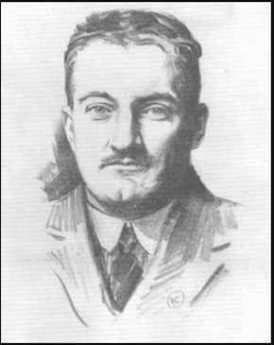
|
| Grover Cleveland Bergdoll |
Grover Cleveland Bergdoll was one of the great playboys during the era between the Spanish American War and World War I. Although the money came from his beer-baron father, he was in the newspapers as one of the early owners of an airplane, one of the dare-devils racing about in open cars, and of course successful with girls.
His father Louis (1825-94) had emigrated from Germany, bringing with him the new technique of making lager beer by brewing it in the cold, and quickly exploiting its popularity into thousands of barrels of beer a day. Although it is always hard to say just who invented a technique like that, there seems little doubt that Bergdoll & Schemm was responsible for transforming the area north of Spring Garden Street into a booming area of breweries, consuming huge amounts of ice and ice water, wood staves for beer barrels, horses to drag beer to the beer gardens, and energizing railroads to import raw materials and carry away the barrels of beer. The refrigeration industry flourished and spread out into air conditioning. Bergdoll was a mighty force in Philadelphia industry.
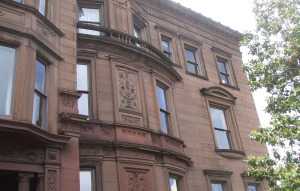
|
| Bergdoll Mansion |
The Bergdoll house was located on 21st Street, not far from the Eastern State Penitentiary, in the very upscale neighborhood called Fairmount. The neighborhood was isolated by the "Chinese Wall" of the Pennsylvania Railroad, and more importantly by the slashing through of the Benjamin Franklin Parkway. Eventually, the advent of Prohibition destroyed Philadelphia's brewery industry and its associated beer gardens. The Fairmount region declined into a slum, particularly after the 1929 Stock Market Crash, and upper crust Philadelphia fled blocks and blocks of huge mansions, too big to heat and clean, and also too big and substantial to tear down. So the Bergdoll mansion has been there all along, but there was just no one around to look at it. With the gentrification of the Fairmount region at the turn of the 21st Century, there it sits. a brownstone Pyramid, or Parthenon. A lot of wild stories circulate in the neighborhood, but very few of the new neighbors know very much about it.
It's just possible that the brownstone Widener mansion on North Broad Street is bigger, and certainly the Elkins, Stotesbury and Montgomery mansions in the far suburbs are a lot bigger. But this brownstone edifice in the center of town is impressively large enough to count for something, filling roughly half a square block if you include what look like stables of the same architectural style, and the double houses which suggest some members of the family lived next door. Even these smaller outbuildings are a great deal larger than the average city mansion.
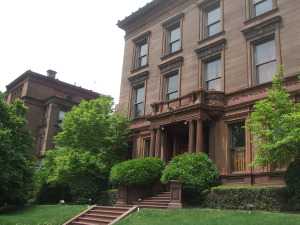
|
| Bergdoll Mansion |
The size of the place makes it easier to understand how Grover Cleveland Bergdoll could be hidden there as a draft dodger for years. In fact, local rumor often has it that he stayed there for thirty years, but it was really only about three. A book by Roberta E. Dell, called The United States Against Bergdoll supplies considerably more detail. One has to suppose that this strongly German family was opposed to American participation in World War I, and the government's violent reaction to his draft objection reflected concern that the very large German-American population might rise up and interfere with Woodrow Wilson's decision to enter the War on the Allied side. In any event, Grover's mother hid him away in the extensive mansion complex until that war seemed safe over, but he was immediately apprehended and put on trial when he emerged. Somehow or other, he managed to convince the authorities that he should be released under guard in order to go dig up an enormous fortune in gold that he had buried. The agents guarding him were put up as guests in the big mansion, apparently unable to resist the big treat. But it was a ruse, a getaway was waiting and off he sped, ending up in exile in a little town a few miles from Heidelberg, Germany. It was there that he married a local German girl and spent an apparently comfortable exile until after the Second World War. There were rumors and stories, however. A couple of kidnappers broke in on him in an apparent effort to take him over the French border, but Bergdoll killed one of them. Even after World War II, all was not forgiven; he came home, was immediately apprehended and tried, and spent a brief time in jail. He died in 1966.
Those who are sufficiently fascinated by his story, can even live in his house. It's been renovated, and rents out as Bergdoll Mansion Apartments.
Brandywine Museum
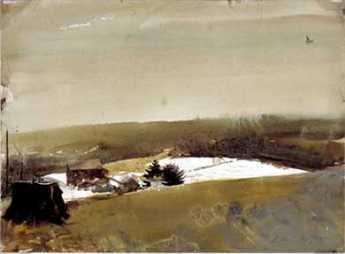 |
| Wyeth Ann's House |
Artistic talent must be inherited; some of us don't have any at all, while other families seem to have unusual talent in every member. Around Philadelphia, one notable example is the Peale family, and another is the Wyeth clan. Three generations of Wyeth's show their work as a group in a former Brandywine Creek grist mill which has been elaborately restored and enlarged for the purpose. Using large glass windows, part of the display is the Brandywine Creek itself, with the high banks that once made it seem like a perfect defense line for George Washington in the biggest battle of the Revolutionary War. Outside the museum entrance are several of those inevitable Delaware tip-offs, large millstones that may in this case have ground grist, but often were used to grind gunpowder.
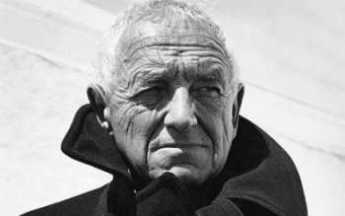 |
| Andrew Wyeth |
Andrew Wyeth spent much of his early career doing watercolors and then turned to tempera as re-popularized by N.C. Wyeth, his father. That's a fairly drastic change, since a watercolor must be completed in one sitting before it dries. Oil base paint dries slowly and allows the painter to work on a piece for a number of days. Tempera, using the protein in milk and eggs to hold the pigment, dries hard and fairly quickly. But another layer of tempera can be painted on top of the hardened base layers, making a glowing effect possible, a peculiar luminosity if the artist chooses to bring it out. Andrew Wyeth migrated to what he called dry-brush, where the paint on the brush is mostly squeezed out, so extremely detailed fine lines can be painted. Thus, he spent his early years with fast blurred watercolors, and the rest of his life with meticulous slow painting, where detail is everything. He chose to use this technique to produce a haunting silent scene, even if it contained people. His son, Jamie, tends to emphasize dancers so you can see the typical family rebellions alternating between generations, at the same time that the Wyeth's (and Howard Pyle, the artistic forefather) preserve strong family unity. From what the neighbors say, there were plenty of family clashes, but that's artists for you.
Canaris and Lahousen
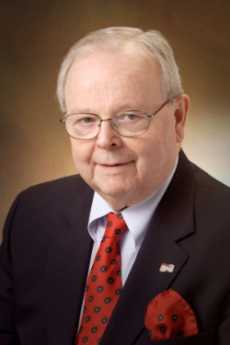
|
| Harry Carl Schaub |
Our member, Harry Carl Schaub, J.D. is the Austrian Consul-General in Philadelphia, was once a member of the American Intelligence Service and is now Of Counsel to the Montgomery, McCracken law firm. In recent years, he has taken an interest in the German Intelligence Service during World War II, and with sufficient prodding intends to write a book about the astonishing betrayal of the Nazi effort by the Chief of their Intelligence Service, Admiral Wilhelm Canaris. Canaris enlisted the top fifty officers of the Abwehr, the Intelligence Service, in his conspiracy to defeat and overthrow the Nazi leadership. All fifty -- except for one, Colonel Erwin Lahousen, Edler von Vermont -- were caught by the Nazis and executed in gruesome ways, after the plot was exposed by the failure of a bomb in Hitler's headquarters to eliminate the top Nazis. Lahousen was the first witness called by the Nuremberg Trials.
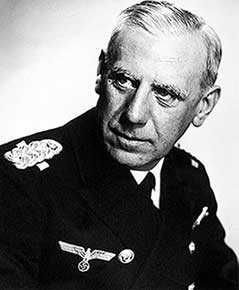
|
| Admiral Wilhelm Canaris |
Admiral Canaris, called the "most knowledgeable man in Germany" , reached his position of Intelligence Chief of the Third Reich as a result of distinguished naval service in World War I, much solidified internationally by his secret negotiations to persuade General Franco to bring the Spanish Moroccan Army to start and win the Spanish Civil War in Spain itself. (Several prominent Philadelphians were involved in these maneuvers, notably William Bullitt.) Canaris was an aristocrat and saw to it that at least the top fifty officers of the Abwehr were also aristocrats hostile to the Nazi regime, using professionalism as an excuse for the exclusion of any officer with Nazi sympathies in the service under his command. Canaris was slowly filling in the blanks in his plans, for years.
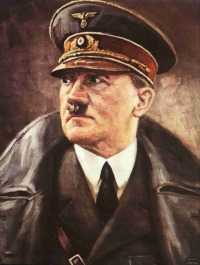
|
| Adolf Hitler |
The military aristocracy was convinced that by 1940, Germany had already won the war in Europe, with only Great Britain left standing unconquered, and an alliance with the Russians protected the Eastern Front. Canaris was close enough to Hitler to believe he was stark raving mad, and as a result of recklessness and blind ambition was about to embark on the two things which professional soldiers had been trained to fear most: a betrayal of the Russian allies and counter-invasion by them, and a land-sea invasion of England. Hitler, for no purpose they could imagine, was about to discard a complete victory in continental Europe and enter into a two-front war. Later on, Hitler committed another gross stupidity in their eyes, of declaring war on America after the Japanese bombed Pearl Harbor. This entirely unnecessary action by Hitler allowed America to follow an established principle of warfare, which is to attack the strongest of your enemies first. Added to what they saw as appalling blunders of getting into a two-front war while stirring up civilian disloyalty with their Jewish, Gypsy and homosexual extermination campaigns, the man they could personally see was mentally unstable was about to convert total German victory into total German defeat. Some of these things might prove to be successful, but sooner or later this madman was going to lead Germany into a catastrophic defeat, so he must be removed before that could happen. While it still remains almost unbelievable that such high-placed officers could risk their lives to betray their own leader, their analysis was absolutely accurate, and correctly predicted the decades of devastation Germany would endure if Hitler could not be overthrown.
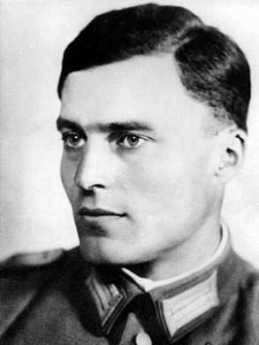
|
| Claus Schenk Graf von Stauffenberg |
And they were probably quite accurate in predicting their own punishments if they failed. Lahousen escaped because he had been assigned to a combat division and was lying severely wounded in a hospital before von Stauffenberg's bomb failed to go off properly in Hitler's staff room. The Gestapo rounded up every other member of the fifty conspirators and tortured them to death, mostly by impaling them on meat hooks. No doubt, they also exterminated a great many innocents, just to be sure they did not miss any conspirators. Canaris himself was strangled to death four times, by the process of reviving him just before he died, and then strangling him again.
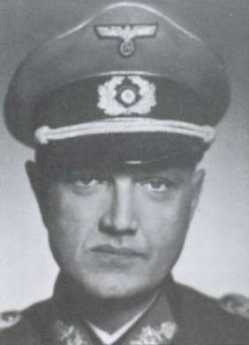
|
| Erwin von Lahousen |
And, indeed, Lahousen was apparently even mistreated as a prisoner by the British. During the war, one of Lahousen's projects was to stir up the Irish Republican Army in Great Britain, and indeed the guerrilla warfare between the IRA and the Protestant section of Northern Ireland lasted more than twenty years after the end of the war. The Brits were not amused.
Field Marshal William Joseph Slim, 1st Viscount, Order of the Garter
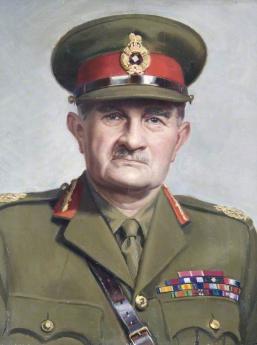
|
| Field Marshall William Joseph Slim |
It's impossible to be accurate about such rankings, but it must mean something when Field Marshall William Slim is the only officer of World War II to be ranked among the ten greatest generals of all time. The historian Ray Callahan recently described Slim's career to the Right Angle Club, with particular emphasis on how unlikely it was for a man of his humble beginnings even to be a Lieutenant in the British Army before World War I, how he endured pretty insufferable snubs along the way up the ladder of command, and how at the end of his career to be Chief of Staff he finally revealed that he had noticed those snubs, all right. Americans would be astonished at such class distinctions in their own army, and even raise the question how the British Army could possibly conquer the world for two hundred years with so little emphasis on merit selection of its generals.
First, the military story of Bill Slim. Before World War I, officer candidates were expected to pay for their own training, and he managed to get through a local college Officer Training course without enrolling in the college. Even that much training suddenly was in very short supply as Britain mobilized for the War, and he was commissioned with the limitation of "hostilities only" to emphasize that he was not in the "regular" Army. Working through the Mesopotamian campaign, he rose through the Indian Army, which Winston Churchill regarded as definitely second tier, with his permanent rank always lagging several levels below his "temporary", acting, rank. At one point, he received an official rebuke for advocating air power for ground support, since that was the turf of the Air Force, and on another occasion for irritating the Navy by using boats. When World War II suddenly sent Japanese forces plunging through Malaysia and Indo-China, Slim distinguished himself by keeping the defeated Indian Army intact through a 900 mile retreat into Burma, justifying his later memoir of turning Defeat Into Victory. During that demoralizing time, he had ample opportunity to observe the repeated Japanese tactic of launching lightning attacks without an established supply line, intending to live on the abandoned supplies of enemies as they were outflanked or surrounded by rapid advances. Slim developed the idea that if he's surrounded troops could be resupplied by air and hold out, the attacking Japanese would essentially starve to death in the jungle. One attacking Japanese army unit of 87,000 men was reduced to 13,000 survivors by the application of this strategy, and as long as the Japanese kept using their technique, Slim kept using his. One reverse variant of this use of air supply was employed by Slim in the recapture of Rangoon by himself attacking from the rear without the usual overland supply line, but resupplying by air as an approaching monsoon cut off the expected resupply by sea. After the war was over, Winston Churchill's history of the war's events contained only the briefest mention of these victories. When Slim finally met Churchill, a close election was taking place, and Churchill said he hoped the overseas ballots were cast for him. "Well, Prime Minister, I must say that no officer in my command voted for you," was the reply he got. When Churchill's successor Clement Attlee was told by Bernie Montgomery that the Chief of Staff position was promised to someone else, the terse order was, "Well, unpromise him." And Slim got the job.
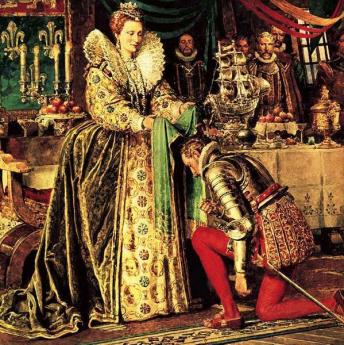
|
| Sir Francis Drake kneeling to Queen Elizabeth |
So, Ray Callahan the historian was asked the typically American question of however could the British Empire conquer Napoleon or plant the British flag over most of the world, using a system that would deliberately hold back an officer of Slim's talents, snubbing and intentionally humiliating most of the nation whenever one of the lesser orders was cheeky enough to aspire to military leadership. With great patience, Callahan replied that this system of placing aristocrats in charge of the military was designed to maintain civilian control against the military uprising. There might have been a time when King Arthur or King Henry V was personally in charge of the Army, but King Macbeth and General Cromwell both illustrate the disadvantages of a fully feudal system. Even before the Industrial Revolution, military skill did not translate well into the skills needed to run an industrialized country but nevertheless provided an easy route for a power-hungry military to seize the crown. It is true that America tends to elect prominent generals to be president after each of our major wars (Washington, Jackson, Harrison, Grant, and Eisenhower) and indeed most other presidents have had some military experience. But ever since George Washington made the principle clear, there has been a prevailing imperative about maintaining civilian control of the serving military, which even the American military seem to agree with. So it is not surprising that other nations with some more bitter experiences to recall insist on more than social pressure to maintain civilian control. Inherited wealth not only provides genetic advantages and a de-glamorized experience with power, but it tends to create its own local environment which regards power as scarcely worth striving for, power is what you have, not what you strive for, there's not a great deal to gain from overturning things. While not inordinately brilliant, hereditary aristocrats are not inordinately stupid, either; they produce their share of Wellingtons, Patton and Macarthurs.
In the first World War, however, the British discovered a serious flaw in the aristocratic system. Most defenders of that system will stress the high morale developed within the comradeship of a 1000-man regiment, carefully selected to choose individuals who "fit in". The British Army has been described as a "loose federation of regiments", collecting the history and traditions of the British Army in a way best understood in America by noting the special fervor of the U.S. Marine Corps. There is an undeniable disadvantage, however. In a mass mobilization, following a selective mass slaughter of volunteers (90% of British Regular Army officers were casualties in World War I), there simply may not be sufficient numbers in the historic regiments to run an effective mass army. That is the implied recognition behind the creation of officers for the duration of hostilities, only; get rid of that sort when the war is over because they can become a threat to cohesiveness. Some of that concern surely runs through the steady drumbeat to take guns away from the public, Second Amendment notwithstanding, repeal that damned thing if you have to. And the converse runs through the thinking of the Second Amendment supporters; you never know when some power freak might seize control of the military. The southern half of the country leans more strongly in that direction. They remember the experience of Reconstruction when official reins of power were in hostile hands. The Old South really likes the idea of its sons running all branches of the military at all levels. Makes a fellow more comfortable with having a strong government.
Frank Furness,(3) Rush's Lancer
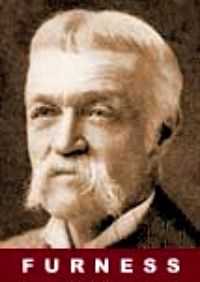
|
| Frank Furness |
Lunch at the Franklin Inn Club was recently enlivened by David Wieck, who not only does the sort of thing you get an MBA degree for but is also a noted authority on the Civil War. His topic was the wartime exploits of Frank Furness, whose name is often mispronounced but whose thumbprints are all over the architecture of 19th Century Philadelphia. Take a look at the Pennsylvania Academy of Fine Arts, Boathouse #13 of the Schuylkill Navy, the Fisher Building of the University of Pennsylvania, and many other surviving structures of the 600 buildings his firm built in 40 years. One of them is the Unitarian Church at 22nd and Chestnut, where his grandfather had been the fire-brand abolitionist minister.
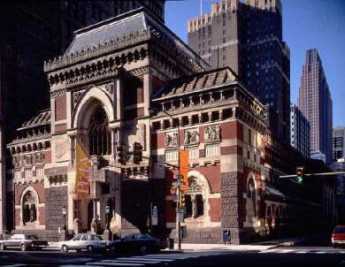
|
| PennsylvaniaAcademy of Fine Arts |
The Civil War seems to have transformed Frank Furness in a number of ways. He had been sort of in the shadow of his older brother Horace, a big man on the campus of Princeton, later the founder of the Shakspere Society, and the Variorum Shakespeare. Frank was quiet, and good at drawing. However, at age 22 he was socially eligible to join Rush's Lancers, the 6th Pennsylvania Cavalry, which contained among other socialites the great-grandson of Robert Morris, and a member of the Biddle Family who put up the money to equip the troop with 7-shot repeating rifles. Cavalry units like this were a vital weapon in the Civil War because they needed young well-equipped expert horsemen with a strong sense of group loyalty. Rifles were considered too expensive for infantry, who were equipped with muskets that took several minutes to reload, and were unwieldy because they were only accurate if they were very long. When bands of daredevils on horseback suddenly attacked with seven-shot repeating rifles, they could be devastating against massed infantry. A flavor of their bravado emerges from their rescue of General Custer's men from a tight spot, later known in the annals of the troop as "Custer's first last stand."
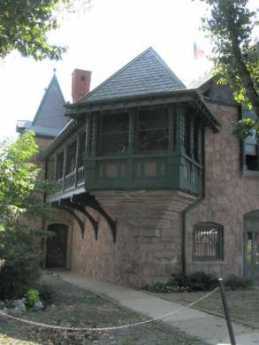
|
| The Undine Barge Club Boathouse #13 of the Schuylkill Navy |
There are two famous stories of the exploits of Frank Furness, first as a second Lieutenant and later as a Captain at Cold Harbor two years later. In the first episode, a wounded Confederate soldier lay on the no man's land of forces only a hundred yards apart. His screams were so heart-rending that Furness ran out to him and put a handkerchief tourniquet around his bleeding thigh. Because the fallen man was a Confederate soldier, the Confederates held their fire and later cheered the Union cavalryman for his kindness. The wounded man called out "
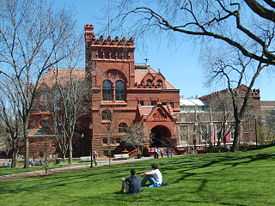
|
| The Fisher Building of the University of Pennsylvania |
In the second episode, the cavalry had spread out too much, leaving some isolated parties trapped and out of ammunition. Furness lifted a hundred-pound box of ammunition to his head and ran through the gunfire with it to the trapped men. For this, he later received the Congressional Medal of Honor. Somehow all of the public attention he received in the war transformed Furness from a younger brother who was good at drawing into a dynamo of energy, much in the model of what law firms call a "rainmaker". He traveled to the Yellowstone area of Wyoming at least six times, bringing back various trophies. He was known to get people's attention by using his service revolver to take pot shots at a stuffed moose head in his office.
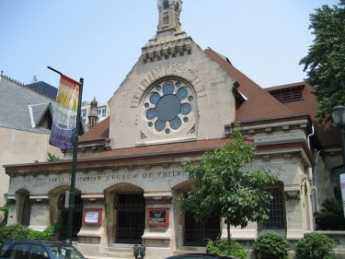
|
| First Unitarian Church 22nd Chestnut Philadelphia |
His final publicity venture was to advertise, forty years later, in Southern newspapers for the whereabouts of the Confederate soldier whose life he had saved. Eventually, a man named Hodge who had later been a sheriff in Virginia, stepped forward to renew his blessings and thanks. Hodge was brought to Philadelphia for a celebrated 6th Cavalry reunion, and a picture of the two former enemies was spread in the newspapers. It was a little embarrassing that Furness and Hodge found they had very little to say to each other for a five-day visit, but Hodge eventually proved able to be one-up in the situation. He outlived Furness by five years.
Although the style of Furness confections seemed and seems a little strange to everyone except Victorian Philadelphians, he did leave a major stamp on American architecture. His most noted student was Louis B. Sullivan, who put an entirely different sort of stamp on Chicago. And Sullivan's best-known student was Frank Lloyd Wright who created a modernist image of architecture for the West. The buildings of these three don't look at all alike, but their rainmaker personalities are all essentially the same.
Franklin Bets His Wad on General Braddock
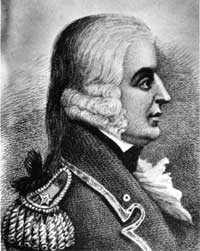
|
| General Edward Braddock |
The defeat of General Braddock at Fort Duquesne (Pittsburgh) in 1755 was not a turning point of the French and Indian War, because although the French won the battle, they lost that War, they also lost Canada in the Seven Years War that followed, and eventually had to sell what remained of their American dream in 1804 as the Louisiana Purchase. The French dream was an empire stretching in an arc from the St. Lawrence River to New Orleans, leaving the British only the thirteen Eastern seaboard colonies.
Nevertheless, the disastrous defeat of the Redcoats was a real turning point in the attitudes of two direct participants, Lieutenant Colonel George Washington of Virginia, and Pennsylvania's political leader, Benjamin Franklin. Both men greeted the arrival of Braddock's troops in America with great relief because it was increasingly evident to them that the Colonies themselves were too indecisive to survive. Both of them were in a unique personal position to see that the French and their Indian Allies were serious about conquering the backcountry, even likely to do so. These two staunch British patriots, therefore, threw themselves into the crisis, with Washington eventually having two horses shot from under him, taking charge of the retreat after Braddock's death. And Franklin pledged his considerable personal fortune on Braddock's behalf, almost losing it and spending the rest of his life in debtor's prison as Robert Morris would later actually do. These two men knowingly laid their lives on the line for the British Empire and came very close to losing everything else for their King and country.
Franklin had retired seven years earlier, a rich man at the age of 42. We now know that he lived like a gentleman for another 42 eventful years. Puttering with science and public works, he joined the Assembly in 1750. It was not long before he was the political leader of the Colony, in a peculiar struggle with the dominant Quaker party who not only opposed war for their own self-defense but were enraged that the Penn family had turned away from Quakerism and refused to be taxed for the defense of its colony. The Governor was appointed by the Penns, with an express contract not to agree to any taxation of the Penn holdings. Since it began to look to Franklin as though everybody was trying to commit suicide rather than spend a farthing, he greeted the arrival of General Edward Braddock's redcoats with great relief. But then Braddock himself turned out to be a brave but exasperating ninny.
Braddock's plan was to take the old Indian trail from the Potomac River to the Monongahela (now Route 40), fording the Monongahela just below its junction with Ohio at Fort Duquesne, then blowing up the French fort with artillery. He had brought plenty of troops and cannons on his ocean transports, but he needed horses and wagons from the colonies. When he was warned of the dangers of Indian ambush in the wilderness, he made a much-quoted response, "These savages may be a formidable enemy to your raw American militia, but upon the king's regular and disciplined troops, sir, it is impossible they would make an impression." The other thing he said was if he didn't get wagons and horses pretty damned quick, he was going back home to England.
Within two weeks, Franklin and his son William collected 259 horses and 150 wagons for him. But to do so, they had to overcome the Pennsylvania farmer suspicion that the swaggering English General wouldn't pay for the goods. To persuade them, Franklin made a public pledge to stand behind the debts with his own money, and his word was known to be good.
The other thing wrong with Braddock's plan was that the trail wasn't wide enough for the wagons and gun carriages, so he had so sent a body of axeman ahead of the troops to widen the road. Progress was at times as slow as two miles a day, plenty of time for word to be taken to Fort Duquesne that the British were coming with cannon. Since it was clear that the Fort could not withstand a siege army, the French commander ordered his troops to attack Braddock as he was crossing the Monongahela. It was meant to be an ambush, but the two armies blundered into each other on the trail, and the Indians simply fought the way they knew best, from behind trees. Two-thirds of the British were killed and most of those captured were burned at the stake. The death toll would have been even higher, and probably would have included Washington, except the Indians, ignored French orders and delayed pursuit to collect scalps. And by the way, all of Franklin's wagons were burned.
Franklin spent an anxious two months since his later reflection was that the loss of 20,000 pounds sterling would surely have ruined him. However, he was lucky that Governor Shirley of Massachusetts, an old friend of his, was appointed at Braddock's successor, and Shirley ordered the debt to be repaid out of Army funds.
The American Revolution would not come for another twenty years, but you can be sure the Braddock episode had an important impact on the minds of both Franklin and Washington. The British Army was not invincible. It was not even very smart.
Franklin: Upstart Hero of King George's War (1747)
In 1747, Benjamin Franklin had a life-transforming experience, acting quite unlike his character before, or later. At that time, Old Europe was engaged in some distant tribal skirmishing which has come to be known as King George's War. King George II, that is, under whose rule Franklin in 1751 inscribed on the cornerstone of the Pennsylvania Hospital that Pennsylvania was flourishing, "for he sought the happiness of his people."
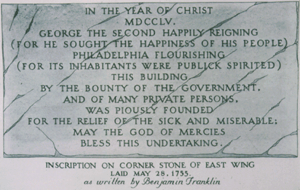
|
|
The cornerstone of the Pennsylvania Hospital inscribed by Franklin. |
Those distant commotions suddenly developed a harsh reality for the little pacifist sanctuaries on the Delaware River, when French and Spanish privateers suddenly raided and destroyed settlements on Delaware Bay. The Quaker Assemblies and their absentee Proprietor merely dithered and huddled in the face of what impended as a totally unexpected threat of annihilation of the pacifist colonies. It probably only seemed natural for the owner of the largest newspaper in the colony to publish a pamphlet called "Plain Truth," urging the inhabitants to rally to their own defense, and pressure their government to lead them. The Quaker leaders were in fact unable to readjust a lifetime of pacifist belief in a few days of an emergency, and the English Proprietor, then Thomas Penn, was far too remote to take active charge of matters. So, Franklin gave speeches, also an unfamiliar role for him, and finally brought out a detailed proposal for the creation of a Pennsylvania Militia. Ten thousand volunteers promptly signed up, elected Franklin as their Colonel; but he declined, and served as a common soldier.
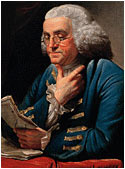
|
| Benjamin Franklin in 1767. |
Against naval attack, the Militia needed cannon, which did not exist in the colony. So Franklin organized a lottery, raised three thousand pounds, and tried to buy cannon from Governor Clinton of New York. New York declined to sell, and so Franklin led a delegation to New York to negotiate. The negotiations largely consisted of getting Governor Clinton drunk and convivial, but they were successful, the artillery was shipped off to Philadelphia. Although they were undoubtedly grateful to Franklin for saving the day, this entirely extra-legal recruitment of an army badly rattled the Quakers and their Proprietor, since it demonstrated the ineffectiveness of their governance at a time of obvious crisis, and might ultimately have led to their overthrow. Franklin's heroic behavior seemed so threatening to Thomas Penn that he described him as "a dangerous man," acting like "the Tribune of the People."
When the underlying commotion in Old Europe subsided, the threat to the colonies disappeared, so the Militia disbanded in a year. Franklin seemed to be just as uncomfortable with his unaccustomed role as the governing leaders were, and he hardly ever mentioned it again. However, this is the sort of reflex leadership which makes political careers, and it surely influenced his decision to retire from business in 1748, run for election to the Assembly, and live like a gentleman. Seven years later, during the French and Indian War, he had become the chosen leader of the Pennsylvania Assembly, had much longer to think through what he was doing, and had learned how to organize a war. By that time, as the saying goes, he knew who he was. He was a man whose silent memories could flashback to that time when a bald fat printer stepped out of the crowd, saying "Follow me," and ten thousand men with muskets did so.
George Washington's View of the British Army
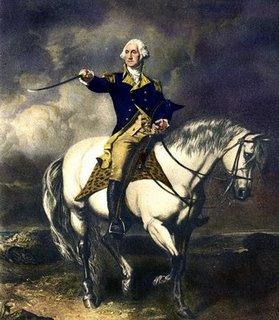
|
| George Washington |
TWO things about George Washington continue to puzzle us. Why would the rich, aristocratic Virginia gentleman become a revolutionary? And, how could he or his backwoodsmen soldiers even imagine they could defeat the British, the greatest military force in the world? The following letter, written to his mother after the defeat of Braddock's army, shows his viewpoint at the age of 23, putting the British regular army in a very bad light, indeed.
"HONORED MADAM: As I doubt not but you have heard of our defeat, and, perhaps, had it represented in a worse light, if possible, than it deserves, I have taken this earliest opportunity to give you some account of the engagement as it happened, within ten miles of the French fort, on Wednesday the 9th instant.
"We marched to that place, without any considerable loss, having only now and then a straggler picked up by the French and scouting Indians. When we came there, we were attacked by a party of French and Indians, whose number, I am persuaded, did not exceed three hundred men; while ours consisted of about one thousand three hundred well-armed troops, chiefly regular soldiers, who were struck with such a panic that they behaved with more cowardice than it is possible to conceive. The officers behaved gallantly, in order to encourage their men, for which they suffered greatly, there being near sixty killed and wounded; a large proportion of the number we had.
"The Virginia troops showed a good deal of bravery and were nearly all killed; for I believe, out of three companies that were there, scarcely thirty men are left alive. Captain Peyrouny and all his officers down to a corporal were killed. Captain Polson had nearly as hard a fate, for only one of his was left. In short, the dastardly behavior of those they call regulars exposed all others, that were inclined to do their duty, to almost certain death; and, at last, in spite of all the efforts of the officers to the contrary, they ran, as sheep pursued by dogs, and it was impossible to rally them.
"The General was wounded, of which he died three days after. Sir Peter Halket was killed in the field, where died many other brave officers. I luckily escaped without a wound, though I had four bullets through my coat, and two horses shot under me. Captains Orme and Morris, two of the aids-de-camp, were wounded early in the engagement, which rendered the duty harder upon me, as I was the only person then left to distribute the General's orders, which I was scarcely able to do, as I was not half recovered from a violent illness, that had confined me to my bed and a wagon for above ten days. I am still in a weak and feeble condition, which induces me to halt here two or three days in the hope of recovering a little strength, to enable me to proceed homewards; from whence, I fear, I shall not be able to stir till toward September; so that I shall not have the pleasure of seeing you till then, unless it be in Fairfax... I am, honored Madam, your most dutiful son."
Gettysburg
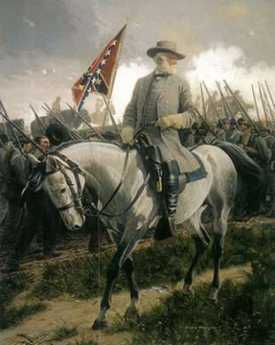
|
| General Robert E. Lee |
It's quite a long drive from Philadelphia to Gettysburg, but General Lee was attempting to disrupt supplies to the "Arsenal of the North" by capturing the railroad center at Harrisburg. Furthermore, Philadelphia reacted as if Lee's advance was aimed straight at us, creating hysterical preparations for an invasion which had to be stopped before it got here. And finally, George Gordon Meade, the Union commander, was a Philadelphia home town boy. So, regard the Battle of Gettysburg as part of Philadelphia history, please.
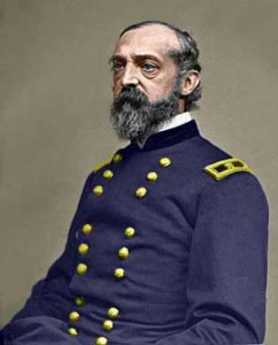
|
| General George Gordon Meade |
Major (ret.) Lawrence Swesey is a West Point graduate and currently Administrator of the 1st City Troop; because of his enthusiasm for the subject, he runs a tour agency which specializes in battlefields, especially Gettysburg. From him, the Right Angle Club recently learned much that made the whole episode comprehensible. Such as Lee's purpose in going there, which appears to have been based on the growing recognition that the South was likely to lose the war, and desperately needed some major victory in Northern territory, both to take the pressure off the Southern homeland and to improve whatever terms might be extracted at a peace negotiation. To fight successive battles against a larger enemy, with larger economic resources, was to doom the South eventually as resources and men were depleted with no hope of replacing them. Sooner or later, some Union General like Grant would settle down to a grinding unrelenting assault, with the willingness to trade one death for another, until only the larger side was left standing. That's quite different from guerilla warfare of the type Washington fought, where the way to win was simply to avoid losing until the stronger side lost its civilian support. Lee could feel the South beginning to lose its nerve to fight on indefinitely, without any visible route to victory. Although Grant eventually did defeat him by attrition, Grant's own opinion appears to have been more personalized. In every war, he was later to say, there comes a time when both sides want to quit. The side that wins is the one with a general who keeps fighting for no particular reason until the other side finally quits and he wins the war.
Major Swesey emphasizes that rifles were available, but they cost four times as much as smooth-bore muskets which were only effective for twenty or thirty yards. Rifles were reserved for sharpshooters, and the enemy at a distance was bombarded by artillery as the two sides approached. So, in Pickett's famous charge, most of the casualties took place in the last fifty yards. Pickett's men had to contend with trudging stoically through an exploding field of cannon fire, unable to fire effectively at the Union men behind a stone wall, who were also supposed to lie passively on the ground while the Confederate artillery pounded at a stationary target. Somehow, most of the Southern artillery fire went over the Union heads and landed beyond the crouching line; in many ways, this was the main factor in the Union victory.
As the waves of attackers got within musket shot of the wall, they formed into three ranks. Since it took about a minute to reload the musket, a more or less continuous fire could be maintained by rotating three successive volleys rank by rank, at more or less point blank range. Then, fix bayonets, and the real slaughter became a hand to hand, in the blazing heat of summer.
www.Philadelphia-Reflections.com/blog/1436.htm
Home of the U.S. Naval Academy
Gray's Ferry, the first non-swamp ground as you come up the Schuylkill, is the oldest part of Philadelphia, and one of the saddest. This was the place where Washington and the other Southern delegates came to the Continental Congress along the main North-South route of the Colonies. John Bartram's gardens are nearby, and Andrew Hamilton's mansion. But things are in a sorry state nowadays, and neighborhood residents believe it is unsafe even to drive through there. Of all the areas in the city, this one cries out most for rehabilitation.
Well, Toll Brothers, the mass builders, are doing something there. Almost any construction, or any demolition, would seem like an improvement. But you have to hold your breath when you see bulldozers in the old Naval Home, a large and stately building along the river, hidden behind a long wall. Some pretty old and historic buildings are in danger of being torn down.
This was, for example, the original home for six years, of the United States Naval Academy. You know, the one that is now at Annapolis. Doesn't anyone care?
John Dickinson, Quaker Hamlet
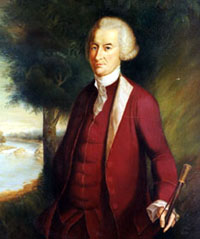
|
| John Dickinson |
John Dickinson (1732-1808) would probably be better known if his abilities were less complex and numerous. It would have been particularly helpful if he had consistently remained on only one side of the important issues of his day. Born in a Quaker family and buried in a Quaker graveyard, he was for years a notable Episcopalian and soldier. He outwitted John Penn, the Pennsylvania Proprietor who was trying to keep Pennsylvania from sending representatives to the Continental Congress, by having the Pennsylvania representatives hold a meeting in the same small room of Carpenters Hall at the same time as the Congress. But he ultimately refused to sign the Declaration of Independence. Although he was the main author of the Articles of Confederation, the Constitution which replaced it would not have been ratified without his idea of a bicameral Congress. Although he was Governor of Pennsylvania, he was also Governor of Delaware, has been the central figure in the separation of the two states. In fact, for fifteen years he was a member of the Legislature of both states. Dickinson seems in retrospect to have been on every side of every argument, but he was immensely respected in his time.
Two events seem to have been central in the organization of his life. The first was his education as a lawyer. At that time and for a century afterward, lawyers were trained by apprenticeship. Dickinson, however, studied in London at the Inns of Court for four years and was by far the most distinguished lawyer in North America for the rest of his life. Furthermore, he absorbed the principles of the Magna Carta and the approaches of Francis Bacon so thoroughly that he never quite got over his pride in his English heritage. Throughout his leadership of the colonial rebellion, he acted as a better Englishman than the English themselves. His demand was for American representation in the British Parliament, not independence from England. It would not be hard to imagine Dickinson standing before a firing squad, gritting the words of St. Paul, Civis Romani Sum.
His other pivotal experience was the Battle of Brandywine. Dickinson had been the organizer or chairman of the two main Pennsylvania military organizations, the Pennsylvania Committee of Safety and Defense, and the so-called Associators (today's 111th Infantry, the first battalion of troops in Philadelphia). Both of these particular names were a characteristic gesture to conciliating pacifist Quaker feelings. Nevertheless, when Dickinson refused to sign the Declaration, he did temporarily become so unpopular he resigned his military commands. A few months later, when General Howe landed at Elkton at the narrow neck of the Delmarva peninsula, Dickinson enlisted as a common soldier to defend the southern perimeter of the defense line Washington had hastily thrown up to defend Philadelphia. Shortly afterward, Dickinson's friend and neighbor Caesar Rodney made him a Brigadier General in charge of the garrison around Elizabeth New Jersey, but the Battle of Brandywine taught an important lesson. Little states like Delaware and Maryland could not possibly defend themselves witho
Laurel Hill
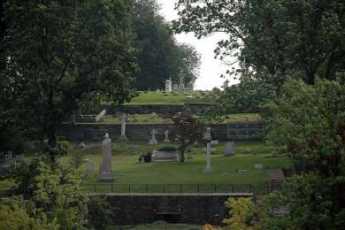
|
| Laurel Hill Cemeteries |
There are two Laurel Hill Cemeteries in Philadelphia, sort of. Although both are described as garden cemeteries, the older part in East Fairmount Park is more of a statuary cemetery or even a mausoleum cemetery. When its 74 acres filled up, the owners bought expansion land in Bala Cynwyd, which could come closer to present ideas of a memorial garden. Particularly so, when the older cemetery area started to fill in every available corner and patch and began to look overcrowded. The name was used by the Sims family for their estate on the original area. Since June-blooming mountain laurel is the Pennsylvania state flower and a vigorous grower, it seems likely the bluff overlooking the Schuylkill was once covered with it. Somehow the May-blooming azalea has become more popular throughout the region, particularly in the gardens at the foot of the Art Museum. If extended a little, merged with laurel on the bluff, and possibly with July-blooming wild rhododendron, there might someday arise quite a notable display of acid-loving flowering bushes from the Art Museum to the Wissahickon, continuously for two or three months each spring.
There are interesting transformations in the evolving history of cemeteries, best illustrated in our city by the traditions of the early Quakers when they dominated Philadelphia.
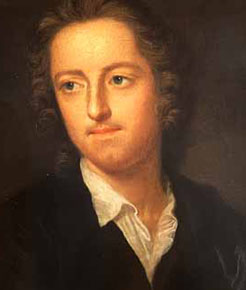
|
| Thomas Grey |
Objecting to the ornate monuments which Popes and Emperors erected for their military glory, and probably to the aristocratic custom of burying important people inside churches where they could be worshiped along with the stained-glass saints, early Quakers were reluctant to mark their own graves with headstones, or even to have their names engraved on such "markers". By contrast with the splendor accorded aristocrats, the common people in Europe were largely dumped and forgotten, providing an unfortunate contrast. During the early part of what we call the romantic period, Thomas Gray popularized these attitudes in Elegy in a Country Churchyard. To be fair about it, the early Christian Church had a strong tradition of collecting the dead of all classes into catacombs. The Romans were quite reasonably upset by the potential for spreading epidemics through people living within such arrangements, although feeding the Christians to the lions seems like an overreaction.
At any rate, and to whatever degree the French Revolution was what shattered previous traditions, the Victorian or romantic period produced a new vision: garden cemeteries in Paris.
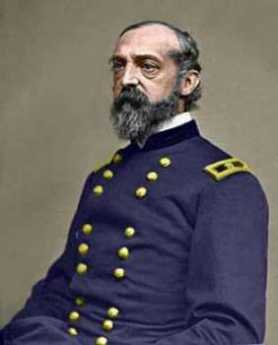
|
| George Mead |
The concept soon spread to Laurel Hill, and thence to the rest of America. Acting with what probably had some commercial motivation, cemeteries then moved away from churches to suburban parks, promoted as places of great beauty in which to stroll and hold picnics, perhaps to meditate. The private expense was not spared in statues and mausoleums, which often became display competitions between dry goods merchants and locomotive builders. Revolutionary heroes were dug up from their original graves and transported here to be more properly honored, as were some private persons whose descendants wished for more suitable recognition than conservative church rectors had offered. The Civil War created the staggering number of 632,000 war dead; based on the proportion of the population, that would be equivalent to six million in today's terms. Since they were almost all male, there must have been at least a half-million surplus women as a consequence. The nation and this almost unbelievably large cohort of single women had an impact on society for thirty or forty years after The War. Eventually, this would lead to colleges for women, suffrage and other forms of feminism, but the initial manifestations of what we now call Victorianism took the form of formalized grief, particularly the 75 National Cemeteries of crosses row on row. But private initiatives also took a variety of forms, including Laurel Hill's statuary to honor the valor of the fallen, ranked by the number of generals buried there and visits by sitting Presidents of the United States. Laurel Hill, East, holds 42 Civil War Generals. It will be recalled that Lincoln's Gettysburg Address was delivered at a much larger final resting place for fallen soldiers, but Laurel Hill had the generals, including George Gordon Meade, himself. It is probably significant that Laurel Hill West, three times as large, was opened in 1867. At the headstone of each Civil War veteran is found a metal flag-holder, put there by the Grand Army of the Republic and marked with GAR surrounding the number 1. This is the home of Post Number One, the Meade Post, the original home of this organization responsible for many patriotic movements like the Pledge of Allegiance and commemorative reunion encampments and reenactments. The main purpose of the war was to preserve the unification of a continental nation, and the GAR sought to raise patriotic consciousness to a point where fragmentation would never again be conceivable.
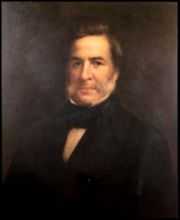
|
| John Notman |
Two names stand out in the history of these cemeteries, Notman and Bringhurst. John Notman was one of the early architects who fashioned the look and feel of Philadelphia. His identifying feature is brownstone, as seen cladding the Athenaeum building on Washington Square, and St. Marks Episcopal Church at 15th and Locust. At Laurel Hill, the main entrance confronts a brownstone sculpture by Notman of "Old Melancholy", depicting a typical Victorian romantic vision; just about all other monuments in the cemetery are either of acid rain-eroded marble or indelible granite. Brownstone from Hummelstown PA provided the characteristic look of New York residential architecture during this era. Philadelphia brownstone probably came from the same place. The other name is Bringhurst, dating back to 17th Century Germantown, long associated with the underlying sanitary purposes of the cemetery. The family finally and gladly sold the undertaking business a few decades ago.
Somehow, the image of cemeteries has now transformed from public places of meditation and reverence to places that are "spooky". Their greatest surge of visitors, these days, occurs at Halloween.
Lewis Harlow van Dusen, Jr. (1910-2004)
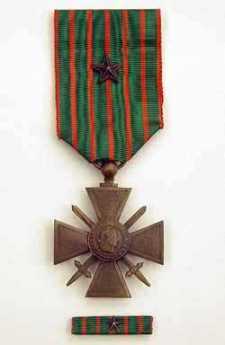
|
| Croix de Guerre |
Lew van Dusen was one of the great story-tellers of a story-telling city. In one continuous lunch conversation he could string together personal anecdotes about Lloyd George, Lawrence of Arabia, William Bingham, the making of the hydrogen bomb, the Croix de Guerre (which he had been awarded), Nicholas Murray Butler, several Supreme Court Justices, Harvard Law School (where he led the class), and on and on until the waitress would just go ahead and clear the table. He even told of his own great suffering as a boy sitting at proper Philadelphia dinners, where it was a firm rule that acceptable topics of conversation were limited to the Wimbledon lawn tennis matches and the sinking of the Titanic.
When the landmark U.S. Supreme Court case of State Oil v. Kahn came up for arguments, he and I rode together on the Metroliner down to Washington, stayed at a club there, and after the hearing took the train back to Philadelphia. During the entire time, Lew never stopped talking, and his voice was very loud. There was the time in Macao when a retired British diplomat came up to him and said he knew the history of every gravestone in the cemetery for foreigners, except five, and two of those names were on the letterhead of Lew's firm (Drinker, Biddle and Reath). Drinker, it turns out, was American consul and discovered that all of his guests were poisoned by the cook. He traveled all night, getting stomachs pumped out, but not his own, and died the next morning from the poison. Biddle, on the other hand, was also a physician interested in Yellow Fever and died of it when he contracted the disease from one of the subjects.
There was the time when he was the young guest of Nicholas Murray Butler at a luncheon with British Prime Minister Lloyd George. "Tell Mr. Roosevelt," said George, "That Social Security is nothing but a dole."
And the time when King George gave everybody the day off on his 25th Anniversary as King, so they played cricket. His teammate was Lawrence of Arabia, and after the game, Lawrence hopped on his motorcycle and rode off down the road to be killed. Lew was the last person to see Lawrence alive.
Well, when you get to the Supreme Court, the public stands in line on the steps, out in the rain. But the lawyers go around to the back door, where there are a lounge and a lunchroom. Inside two minutes, Lew was surrounded by lawyers as he told more stories. One of them tugged my sleeve and asked, "Is that who I think it is?" I said I supposed so, although who he had in mind is still a mystery to me.
State Oil turns out to have been as important to antitrust law as we supposed it would be; the fine points of vertical integration were afterward explained to me. And finally, I was told how, when he was chairman of the Ethics committee of the American Bar Association, Lew's committee caused the ABA to reverse its long-standing opposition to cameras and audio equipment in courtrooms. The effect of this has been slow, but gradually courts are permitting the televising of trials, and eventually they probably all will permit it. But not yet the U.S. Supreme Court. Non-lawyers still stand in the rain outside, and if there are no seats left inside, too bad.
Madame Butterfly (2)
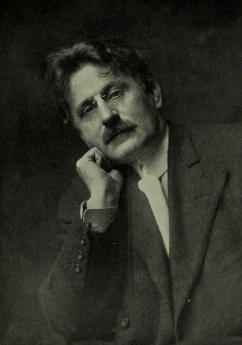
|
| John Luther Long |
There are two ways of looking at the love affair of Pinkerton, the dashing Philadelphia naval officer, and Madame Butterfly, the beautiful Japanese geisha. John Luther Long wrote about it one way, while Puccini somehow portrays it differently, even though Long collaborated on the Libretto of the opera. Puccini, of course, was himself a famous libertine, tending to follow the typical belief of such men that women somehow enjoy being victimized. Long in real life was a Philadelphia lawyer, trained to keep a straight face when people relate what messes they have got into. If you know the story, you can see Long in the person of Sharpless, the consul. Sharpless is definitely meant to be a Philadelphia name.
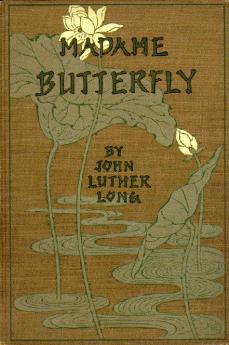
|
| Madame Butterfly |
Long was one of the early members of the Franklin Inn, and it is related he wrote much of his successful play at the tables of the club on Camac Street. David Belasco was the "play doctor" who knew how to make a good story fill theater seats. Even after Belasco's polishing, the play came through as a portrayal of the well-born gentleman who had been trained to regard foreign girls as just what you do when you are away from home. His real girlfriend, the beautiful Philadelphia aristocratic woman in a spotless white dress, was the sort you expected to marry. In just a few sentences of Long's play, this woman comes through as just about as distastefully aloof to foreign women as it is possible to be while remaining rigidly polite about it. Butterfly sees this at a glance, knows it for what it is, and knows it is her death. Her duty immediately is "To die honorably, when one can no longer live with honor".
It is Puccini's genius to take this story of how two nasty Americans destroy an honorable Japanese girl and using that same story with the same words, make it into a romantic woman being destroyed by a hopeless, helpless love affair. The power of the music overwhelms the story and sweeps you along to the ending. Even if you feel like Long/Sharpless, dismayed and disheartened by watching some close acquaintances doing things you know they shouldn't.
When Puccini's opera comes to Philadelphia every year or so, the Franklin Inn has a party for the cast, one of the great events of the Philadelphia intellectual scene. Somehow, the full intent of Luther Long's work never seems to come out.
In the middle of the pacifist Quaker farm region, in fact in the middle of William Penn's Quaker Welsh Barony, sits Valley Forge Military Academy. Its location seems even stranger when you consider the nearest town, within easy walking distance, is Wayne, PA described by David Brooks in Bobos in Paradise as the East-Coast epicenter for yuppie education-based elitism, with all its air of entitlement. In fact, Brooks does not mention the Academy once in his three hundred page book about the town. What is VFMA and why is it located where it is? Three names, Baker, Mellon, and Annenberg pretty much explain it. Lieutenant General Milton Baker, a great friend of the Eisenhower family, was passionate about Valley Forge, its history, its parks, its military hospital, its renovation, and its preservation. If Baker founded a school (in 1928), it was going to be here. The money was Mellon and Annenberg money, but Baker was their man.
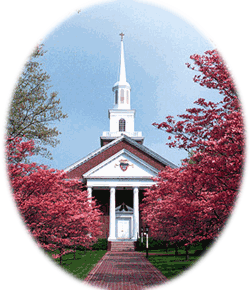
|
| Military school |
Military schools are now in a period of decline. A flurry of a building after the Civil War created about 600 of them, in recognition that the North nearly lost the Civil War to the Confederate States who had a much stronger military tradition, especially in Virginia. It's therefore not surprising that Valley Forge wanders from Southern traditions, and is consciously modeled after Sandhurst, the British Royal Military College. Valley Forge competes with Canada, Australia and Great Britain for foreign students, while the Southern schools are more provincial. There seem to be two main reasons to send your son to a military boarding school.
The first is the tradition of military aristocracy, traceable in a sense to feudalism and the Knights of the Round Table. There's little patience with a politically correct speech in the military, who readily tell you that many rich families encourage their daughters to marry career military officers, as a way of strengthening loyalties between these two power groups. During the formative years of the American republic, the resounding emphasis was placed on having no standing army. That was a cloaked way of restraining a military aristocracy and seems to have provided the main reasoning behind the constitutional Second Amendment, which projects a general right of all citizens to bear arms. It follows the model of Switzerland where military service is universal, as contrasted with limiting firearms to specialists, whether police or military. If that was the goal, it seems to have been effective; military elites now seem most appealing to foreign cultures, like Latin America, Korea, Saudi Arabia. Tony DeGeorge, the current president of Valley Forge, tells of an astounding phone call from one Saudi prince, who responded to an alumni fund-raising appeal by offering to buy the whole school. The Saudi noticed one supposes, that "Storming' Norman" Schwarzkopf, the hero of the First Gulf War, was an alumnus of Valley Forge.
The other main reason to send your son to military boarding school, is because he's too unruly to handle at home. Here is another seemingly delicate matter the school makes no bones about. All new entrants must spend six weeks as "plebes", enduring a ferocious hazing discipline that weeds 'em out. The solution to cell phones and Internet games is to forbid them. Valley Forge confronts the matter of recreational drugs head-on. All students are subject to random drug testing, and a positive test means get off the school grounds -- permanently -- within four hours. The exercises program is not only mandatory, but it is also rigorous beyond description. The result is that fifteen alumni are currently playing professional football in the NFL, the polo team is regularly the national champion. Somewhere General Baker got the idea that playing music helps your mathematical ability, so every single 9th grader plays the violin. The marching band is internationally famous, and by gad, it better stay that way. Only about a third of the graduates go on to a lifetime military career, but another third of the alumni are CEOs of companies. Even what happens to the remaining third bears some thought.
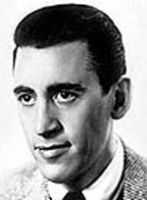
|
| J.D. Salinger |
J.D. Salinger and Edward Albee were both alumni of Valley Forge Military Academy. True, General Baker told Salinger that The Catcher in The Rye was rubbish, and one need not speculate much on how he would have reviewed Who's Afraid of Virginia Woolf? Nevertheless, it cannot be denied that the collision between these two social misfits and the plebe hazing experience contributed significantly to the depth and power of the serious literature they produced. It is not easy to name two alumni of Andover, Exeter or Lawrenceville who have contributed as much to 20th Century American fiction. Salinger and Albee hated the place, but it made them what they became. "Whatever that was," you can almost hear the other two-thirds of the alumni mutter.
In a day that echoes No Child Left Behind, it is a little hard and it is certainly politically incorrect, to give this devil its due. But all Armies live by the slogan, that if you must take an objective, you must take some casualties.
Philadelphia in 1976: Legionaire's Disease
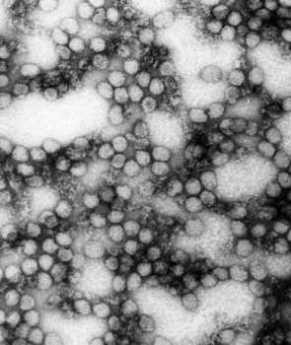
|
| The Yellow Fever |
No other city in America is remembered for an epidemic; Philadelphia is remembered for two of them. The Yellow Fever epidemic, for one, that finished any Philadelphia's hopes for a re-run as the nation's capital. And Legionnaire's Disease, that ruined the 1976 bicentennial celebration. One is a virus disease spread by mosquitoes, the other a bacterial disease spread by water-cooled air conditioners. Neither epidemic was the worst in the world of its kind, neither disease is particularly characteristic of Philadelphia. Both of them particularly affected groups of people who were guests of the city at the time; French refugees from Haiti and attendees at an American Legion convention.
In 1976, dozens of conventions and national celebrations were scheduled to take place in Philadelphia as part of a hoped-for repeat of the hugely successful centennial of a century earlier. Suddenly, an epidemic of respiratory disease of unknown cause struck 231 people within a short time, and 34 of them died. Every known antibiotic was tried, mostly unsuccessfully, although erythromycin seemed to help somewhat. The victims were predominantly male, members of the American Legion of a certain age, somewhat inclined to drink excessively, and staying in the Bellevue Stratford Hotel, one of the last of the grand hotels. Within weeks, it was identified that a new bacterium was evidently the source of the disease, and it was named Legionella pneumophila. Pneumophila means "love of the lungs" just as Philadelphia means "city of brotherly love", but still that foreign name seemed to imply that someone was trying to hang it on us. Eventually, the epidemic went away, but so did all of those out-of-town visitors. The bicentennial was an entertainment flop and a financial disaster.
Since that time, we have learned a little. A blood test was devised, which detected signs of previous Legionella infection. One-third of the residents of Australia who were systematically tested were found to have evidence of previous Legionella infection. A far worse epidemic apparently occurred in the Netherlands, at the flower exhibition. Lots of smaller outbreaks in other cities were eventually recognized and reported. It becomes clear that Legionnaire's disease has been around for a very long time, but because the bacteria are "fastidious", growing poorly on the usual culture media, had been unrecognized. And, although the bacteria were fastidious, they were found in great abundance in the water-cooled air conditioning pipes of the Bellevue Stratford Hotel. Even though the air conditioning was promptly replaced, everybody avoided the hotel and it went bankrupt. When it reopened, 560 rooms had shrunk to 170, and it still struggled. Although there is little question that lots of other water-cooled air conditioning systems were quietly ripped out and replaced, all over the world, the image remains that it was the Bellevue, not its type of plumbing, that was a haunted house. There is even a website devoted to its hauntedness.
Politics of the French and Indian War
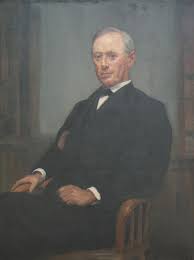
|
| Isaac Sharpless |
In the European view, the French and Indian War was a mere skirmish in the many-year conflict between France and England. But the Atlantic is a wide ocean. The local Pennsylvania politics of that war concern the land-hungry settlers striving for Indian lands, the Quaker Assembly doing its best to maintain William Penn's formula for peace ("No settlements without first buying the land from the Indians."), and William Penn's far-from-idealistic Anglican sons, focused on profit from a land rush. Western Pennsylvania belonged to the Delaware tribe, but the Delawares were subject to the Iroquois nation. The year is 1754. The following pro-Quaker description is given by Isaac Sharpless, president of the Quaker Haverford College between 1887 and 1917 (Political Leaders of Colonial Pennsylvania,
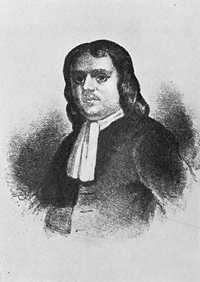
|
| Isaac Norris |
Isaac Norris was appointed to another Albany treaty with the Indians in 1754. The commission consisted of John Penn and Richard Peters representing the Proprietors, and Benjamin Franklin and himself, the Assembly. Indian relations were becoming difficult. The Five Nations still claimed the right to the ownership of Pennsylvania and insisted that no sale of land by the Delawares was permissible. In an evil hour, the government of Pennsylvania recognized this claim and this Albany meeting was for the purpose of effecting a purchase. By methods that were more or less unfair, taking advantage of the Indian ignorance of geography, they bought for 400 pounds all of southwestern Pennsylvania. When the Delawares found their land had been sold without their consent, they threw off the Iroquois yoke, joined the French, defeated Braddock's army a year later and for the first time in the history of the Colony the horrors of Indian warfare were known on the frontiers.
Although Sharpless goes directly to the unvarnished truth of the situation, he reveals the depth of his bitterness by openly discarding Franklin's cover story about being in Albany to propose political unity among the British colonies.
It was on this expedition that Franklin presented to his fellow delegates his plan for a union of the Colonies, of course in subordination to the British Crown which was a precursor of the final union in Revolutionary days. Sixty years earlier William Penn had proposed a somewhat similar scheme.
The war came, French intrigue and the unwisdom of the Executive branch of the government of the Province (the Penns) drove the Indians, who for seventy-three years had been friendly, into the warpath. Cries came in from the frontiers of homesteads burnt, men shot at their plows, women, and children scalped or carried into horrible captivity, and a growing sentiment among the red men that the French were the stronger and that the English were to be driven into the sea.
Principles of the Command of War
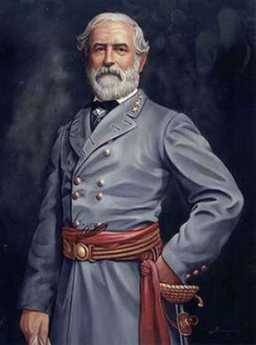
|
| General Robert E. Lee |
COMPUTER war games now consume a great deal of time which teenaged boys ought to be spending on homework, but study of the underlying principles of commanding an army is a major part of the serious curriculum at West Point. To be good in this course means promotion in the officer corps, and putting principles into successful action creates a few famous heroes for the history books. Lawrence E. Swesey, the founder and president of American Military Heritage Experiences, recently fascinated the Right Angle Club with an analysis of Generals Lee and Grant, both West Point graduates, putting the principles to work in the Civil War. Conclusion: Grant was the better general. It was Henry Adams, the manic-depressive historian, who diverted attention away from the principles of war, to such issues as Grant's short stature, taste for whiskey, and poor performance as an Ohio farmer. To be snide about it, a case can be made that Grant was a better writer of history than Adams, as well as a better general than Lee. However, probably neither Ulysses Grant nor Julius Caesar would be considered great historians if either had lost the wars they so famously described.
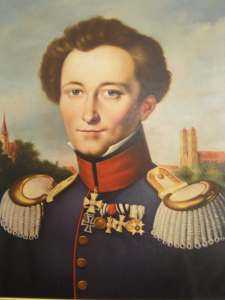
|
| Carl von Clausewitz |
The nine principles of war used by the American military derive from the Prussian officer Carl von Clausewitz, and are also used by the British, who add Flexibility as a tenth. The Chinese and Russians go on to add Annihilation to their list, a thought worth pondering. French military schools base their training on 115 principles laid out by Napoleon, which are presumably ten times more difficult to remember in the heat of battle if indeed anyone can remember anything when the enemy starts taking aim. In any event, the first universally agreed principle is to have an objective that is both effective and achievable. The second is deciding to take offensive or defensive action, the third is to apply sufficient combat mass at one critical time and place. Maneuver is the last of the four main principles. The economy of force, Unity of command, Surprise, Security, and Simplicity are five lesser principles, used to achieve the four main ones. Using these lines on the scorecard, how did Robert E. Lee and Ulysses S. Grant score on the fifteen major battles of the Civil War?
To compare the two generals, there is the difficulty that they only opposed each other in five battles, and each was the clear winner in two of them. In the battles where they faced other generals, both Lee and Grant won some, mainly because the opposing general did the wrong thing and lost the battle. The score comes out roughly even and gets complicated when giving more weight to winning bigger battles, less weight to smaller ones. Lee gets more glamor, because his style was to attack, even attacking just after he seemed to be losing. Lee won one battle when he was outnumbered, two to one.
But Grant won the war, and that should count for something. Both Lee and Grant knew the superior resources of the North would ultimately overcome the South unless the North made some mistakes, or just got tired and quit. Apparently Lincoln also understood this, and immediately offered the top job to Grant after an interview in which Grant came right out and said so.
Apparently, there is one more principle of war that isn't on the list. You play the hand you are dealt, after counting your cards carefully. In contract bridge, the game is always played with fifty-two cards. It isn't that simple in a war, where you stack the deck if you possibly can.
Quakers Turn Their Backs on Power
There have been a number of excellent books about Ben Franklin lately, but all take his side in the dispute with Quakers. These authors relate Franklin struggled with the Quakers, fought with that political party, heroically overcame them with wisdom and guile. Good thing, too, or we all might still be subjects of the British crown.
Well, within the Quaker community these events are viewed differently. Around the year 1755, the Quakers who owned and ran Pennsylvania abruptly turned away from politics and left the government to their political enemies, rather than compromise religious principles. It is difficult to think of any other instance in history when a ruling party decided to become humble subjects of the opposing party, simply because they refused to do what obviously had to be done.
The background of this perplexing issue goes back to the founding of the Quaker colonies, which had lived in a real Utopia for seventy-five years. Repeatedly it had been true that if they just followed the highest principle, things worked out well for everybody. For example, they didn't need to buy the land a second time from the Indians, but they did, with the gratifying result of peaceful co-existence while other colonies experienced constant Indian wars. Penn negotiated the borders of his states with the neighbors, and although it took decades, brought peace and prosperous trade in return. Strict honesty in mercantile matters led to a reputation for trustworthiness, and that in turn led to prosperous commerce. Using a fixed price rather than haggling over price speeded up transactions, gained respect for fair dealing, led to more prosperity. Just you do the right thing, and all will be well. That includes extending freedom of religion, welcoming strangers to the colony to worship together in peace.
Toward the end of this Utopian period, some questions began to arise. More and more non-Quakers came to the colony, making the colony progressively less Quaker. That was a silent disappointment to William Penn. The founder had been a charismatic evangelist for his religion as a youth but came to grave disappointment about peaceful persuasion by the end of his life. Convincing the adherents of other religions of reasonable Quaker principles had often proved to be as intractably difficult as arguing religion with Henry VIII. The Quakers, a religion without a clergy, were appalled that so many adherents of other religions did not concern themselves with earnest reasoning, preferring to do strictly what their ministers told them to do.
Another disconcerting thought was growing within the Quaker community that success itself might be corrupting them. Worldliness seemed to grow inevitably out of wealth and prominence; all power does tend to corrupt. If you are rich, people always seem to steal from you, and that leads to violent punishments, something regrettable in itself. These were not new arguments, but by 1750 nearly a century of success in paradise had begun to stir Pennsylvania Quakers to wonder why more of their neighbors did not ask to become Members. These were troubling concerns of the day which would probably have worked themselves out, except that far-away France and England declared war on each other. The French responded by stirring up the Indians along the Western frontier. Pennsylvania settlers were soon scalped, kidnapped and burned at the stake. Something had to be done about it since protection was a duty of government, and effective protection now had to be non-peaceful. The Quakers dithered. More Scotch-Irish settlers around Pittsburgh were slaughtered. The Quaker meetings sent minutes to the Quakers in the legislature that they must not compromise their peaceful principles, and the Scotch-Irish exploded with rage. The Meetings told their representatives to resign from office, their members to retreat from politics altogether.
So Ben Franklin rose to the occasion, and General Forbes led an army to Fort Duquesne at the forks of Ohio, and Colonel George Washington was the hero of that day. The French were driven off the frontier, the English were victorious at Quebec. North America became a British continent.
Meanwhile, the Quakers retreated into tight-lipped solitude. And self-doubt, because the episode seemed to demonstrate that rigidly peaceful principles cannot govern a state or a nation if that nation contains others unwilling to be sacrificed for peaceful principles. An unthinkable logic emerged; freedom of religion led to conflict with the duty of a non-violent government to protect its citizens. It began to be clear it was the duty of government to enforce its laws, by force if necessary. Underneath the pile of documents, was a gun.
So, the Quakers proudly walked away from power and dominance, for all time. Sadly, too, because the significance was clear. Peaceful utopia may be not possible, within a dangerous world.
Robert Adams, Jr.
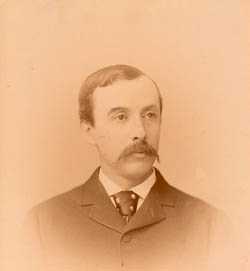
|
| Robert Adams Jr. |
The duel between J. William White, M.D and Robert Adams, Jr. stands as the last-known (April 10, 1880) duel in Philadelphia. The duel was actually fought in the "wedge" of 800 acres of disputed land that had resulted from faulty calculation of the original borders of Maryland, Delaware and Pennsylvania, thus establishing a convenient patch of lawlessness suitable for prizefighting, duels, and whatnot during the long period while lawsuits failed to resolve the geographical matters. Doctor White was much the more flamboyant of the two, so this duel is mostly attached to his name, but Adams seems to have been a person of some consequence, as well.
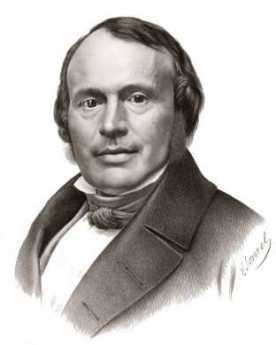
|
| Louis Agassiz |
The sketchy information available about Adams (which readers of this website are urged to supplement) states that he was a member of expeditions exploring Yellowstone Park at roughly the time when young White was a member of a famous expedition on the ship Hassler exploring the coast of South America with Louis Agassiz. Adams seems to have become a serious politician, acting as a Pennsylvania state legislator for a while, then Ambassador to Brazil for a couple of years, then a United States Congressman representing Pennsylvania's 2nd District. While a sitting congressman, he is said to have committed suicide because of financial losses due to speculation. Just what it was that made Adams and White such bitter enemies has long been unclearly wrapped in fanciful speculation.
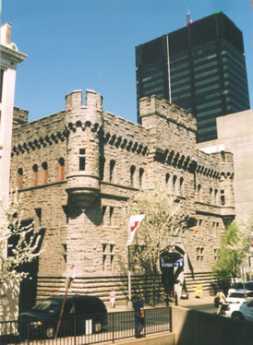
|
| Armory on 23rd Street |
A few years ago, the City Troop was off to Kosovo, leaving the Armory on 23rd Stree quiet enough for Captain Dennis Boylan to poke around in the archives. Here he discovered a pamphlet entitled Frock Coat, Pistols and Champagne which described the events with satiric cartoons, quotations from unsympathetic newspapers, and very likely a certain amount of disinformation. The suggestion is implied that the Troop had indeed declined at that time into a drinking club for useless aristocrats, but the reaction to this public uproar created a determination to restore the Troop to its former serious military and patriotic place, which it has enjoyed ever since. Although it may have been true for a period after the Civil War that the Troop was in decline, its performance before and during the Revolutionary War, and since the 1880 duel, has been one of a serious concern about the duties of privileged families, to lead the way in the sacrifices expected of public leadership.
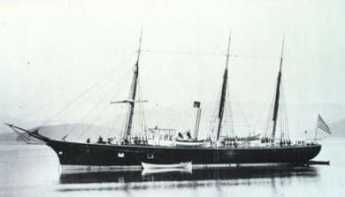
|
| ship Hassler |
As told by Captain Boylan, the lore of the subject suggests that Adams and White had disliked each other for a long time. There was friction about participating in the dedication of the Bunker Hill Monument in Boston, having something to do with who was to be on the right side of the governor of Massachusetts. There was further friction, not well defined, when the Troop was sent to Altoona to bring order to a labor dispute. And there is the question of a doctor wearing the Blue uniform of the Troop. The troop physician had always worn civilian clothes, but White was "ordered" to wear the uniform and it rankled Adams. Since White had been taught boxing by a prison inmate patient at Philadelphia General Hospital and is famous for his involvement in football and other contact sports, it seems likely there were some associated provocations left unrecorded. In any event, when Bill White died, his will left $5000 to the Troop to promote annual remembrance that he was the first troop physician to be ordered to wear the uniform. He left a similar amount to the Franklin Inn for an annual dinner in his name, so you kind of get the idea that he thought a lot of himself. Both men remained members of the troop for some years after the duel, so probably there was a reason to express continuing unworthy opinions of a comrade, in code.
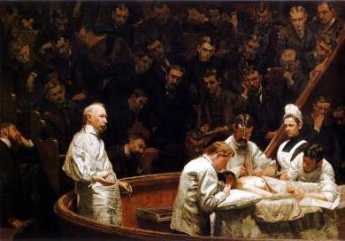
|
| The Agnew Clinic |
There's general agreement that White shot his pistol into the air, while Adams took careful aim -- and missed. In the view of soldiers, therefore, it is clearly true that White comes off looking the better of the two, and for two different reasons. White is the surgeon actually doing the cutting in Thomas Eakins" famous painting of The Agnew Clinic, was a friend of Henry James and Theodore Roosevelt, and became a Trustee of the University of Pennsylvania. But Adams was obviously a person of parts with a contingent of loyal supporters, and probably had an interesting story in his later years. If there is a moral to all this, it is likely to be that fame consists of a large degree of working hard to achieve it. Pick the right painter to do your picture, ingratiate yourself with famous people, and leave some money to institutions with a vigorous development office.
The unknown author of Frock Coat, Pistols, and Champaigne reaches a different conclusion. "Philadelphia, like old Rome, was not without its flock of geese."
South Amboy Explodes
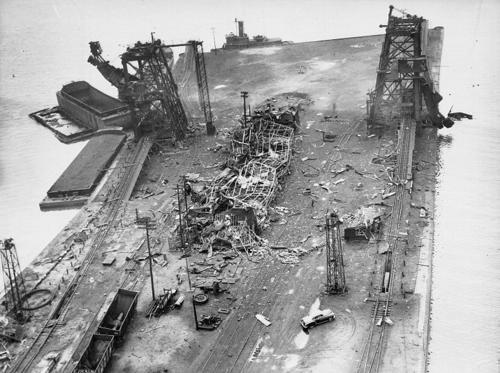
|
| Explosion |
South Amboy, New Jersey, is a waterfront industrial town on a remote promontory behind Staten Island, jutting into lower New York Bay. It's across the Raritan River from historically important Perth Amboy, but it's fair to say that few people ever heard of South Amboy until sunset on May 18, 1950, when they suddenly heard a lot. An entire freight train, five lighters, and a railroad pier suddenly exploded and disappeared. About twenty-five people were never seen again; the largest piece of metal from the explosion was only about a foot in length. A significant part of the town was leveled, steeples were knocked off churches, and windows were broken in five surrounding counties. Considering what caused it, it seems remarkable that so few people were killed. The explanation usually given is that the explosion blew straight up and straight down; the distant windows were smashed by pressure implosion.
When Pakistan split off from the rest of India, there were bloody migrations in which millions of people died. So Pakistan bought the rights to the design of certain land mines to protect its new borders and contracted with a firm in Newark, Ohio to manufacture the mines. Two trainloads of these explosives were shipped from Ohio to a railroad pier owned by the Pennsylvania Railroad in South Amboy, to be lightered out to a waiting cargo ship and sent to Pakistan. The first of these two shiploads sailed off uneventfully, and on May 1, 1950, the second shipment had already left Ohio and was underway, when the Coast Guard suddenly declared the South Amboy pier to be closed and forbidden. As the train chugged slowly eastward, frenzied negotiations took place with Admirals in Washington. There was plenty of time, because the train moved very, very slowly and it was detoured over six different railroads to Wilmington Delaware, where the Hercules Powder Company had packed two freight cars with dynamite, which were to be hooked onto the end of the train as it inched its convoluted way to South Amboy.
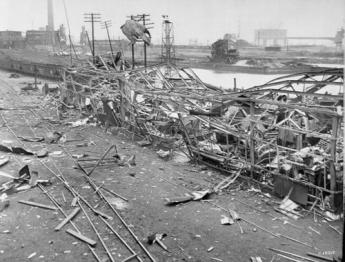
|
| South Amboy Explodes |
The method of packing the land mines was of some importance during the huge litigation which inevitably followed. Land mines were packed in cardboard boxes about six feet long, divided into six compartments. Our own Army regulations about such things state that never, never should fuse be packed in the same carton with the mines. However, this particular shipment had five mines to a carton, with the fuses in the sixth. It was later argued that this particular arrangement proved harmless in the first of the two Pakistan shipments, but there was the testimony that defective fuses were removed from those boxes and passed back up the line, where those deemed satisfactory were re-packed in the cartons which were in this, the second shipment. A fuse, by the way, does not quite describe these objects, which were screwed into a hole provided on the bomb part. They contained a spring and a steel ball in a tube; when the gadget was cocked it was held by a hare-trigger. The idea was that the pressure of stepping on the mine shot the steel ball into the ball of explosives, and boom.
The railroad ammunition pier, for some reason called The Artificial Island, consisted of two rail lines extending a quarter mile from land, but no structures. Stevedores transferred the boxes from the train to the lighters, and then five lighters took the partial shipments out to the anchorage where the ocean freighter was waiting. The deck of the lighters was lower than the train tracks, so a wooden ramp was laid from the freight car to the lighter, resting on several mattresses on deck. It all worked on the first shipment, didn't it?
Well, it didn't work this time, and we have no way of knowing who stumbled or dropped something; we only know it all went sky-high. For this, the ship-owners were delighted because it is a well-established principle of Admiralty law that unless the ship was in contact with the owners, their liability is limited to the value of the damaged vessel. Under conditions of total disintegration, that means the lighters had a liability of zero. But there were six railroads, the Pakistani government, the Coast Guard and the two manufacturers of the explosives available to sue. Everybody had insurance, so a dozen insurance companies were involved. All of the victims and hundreds of people with property damage, all had lawyers; everyone agrees that many lasting friendships were established among lawyers who were milling around. Finally, the judge declared this case just had to be settled, or else it would continue for the rest of everybody's lifetime. The total amount of the claims submitted came to $55 million. Obviously, the settlement would be for less than that, but settlements are kept secret and you are not supposed to know how it turned out.
So, the question that remained was this. If everybody was insured, why not let the insurance companies haggle about who owed what to whom. Why did all of those railroads have lawyers hanging around? Well, the answer is a lesson for all of us. You need a lawyer to watch your insurance company's lawyer, because once a claim action begins, you and your insurance company develop a conflict of interest.
www.Philadelphia-Reflections.com/blog/1482.htm
Stephen Girard 1750-1831
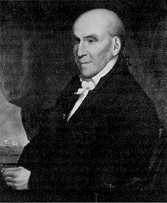
|
| Stephen Girard |
Girard was born in Bordeaux, France and never went to school. By the age of 23, he had become a sea captain, like his father and grandfather. By the age of 27, he owned his own ship and was thus launched on a successful career in a very dangerous occupation. Depending on the destination and weather during that era, up to forty percent of sailors were lost at sea on long voyages. From the point of view of the passengers and shippers, when you were selecting a captain you wanted one who had returned unharmed from many voyages. It was irrelevant whether he had been lucky, or diligent, or had learned a lot from his relatives in the trade.
Stephen Girard did start with a handicap, being born blind in one eye. It may have been a personality disorder which drove him to precise, minute instructions to his subordinates in excruciating detail; he might now be called a "control freak" and be disliked for it. For example, he kept a handwritten copy of all letters he wrote, and at his death, there were 14,000 of them, sorted and filed. His wife went insane, and after spending years at the Pennsylvania Hospital, was buried on the grounds. If this is the price of being rich, some might consider remaining poor. During his working years in Philadelphia, he would normally get to the counting-house at 5 AM, go to his bank at noon, and go to work on his 600-acre farm in South Philadelphia after 5 PM. He said he liked farm work the best. The image left behind by this role model, then, was workaholic. Nevertheless, if you wanted to become the richest man in America, here was the pattern to follow.
Girard probably came as close as any rich man in history, to "taking it with him" when he died. His innately compulsive personality, combined with the sure knowledge that his relatives and others would probably try to break his will for their own benefit, led to the construction of a last will and testament that withstood a century of court challenges. It launched remarkable philanthropy for thousands of orphans and organized the whole Delaware Valley into an industrial machine unlike anything else in the country. Although he left the largest estate in the nation's history, that estate continued to accumulate money from his minute instructions to executors, eventually enlarging his vast fortune fifty-fold, a century after his death. In retrospect, Philadelphia might well have slowly declined into obscurity after the nation's capital moved to Washington in 1800. Instead, the coal, canal, railroad and industrial empire of the Philadelphia region became the "arsenal of the North" during the Civil War, and the main wealth generator of the Gilded Age which followed.
Girard's business career can be somewhat oversimplified as consisting of shipping at the base of his early good fortune, followed by banking during the era when banking was poorly understood and usually ineptly managed. He ended his career with an eager and successful embrace of the emerging Industrial Revolution. Throughout all of this, he characteristically took great risks for great profits, through recognizing what others were too timid to accept fully. On many occasions, his risky ventures resulted in very large losses, made acceptable by other risky ventures proving unexpectedly successful. An example would be Girard's Bank. When the Federal Government first started and then abandoned the First National Bank Girard bought up the remnants and made a great private success of banking, where he had little previous experience. He saw the potential of the canals, and later the railroads when others were content to be farmers or country gentlemen. When he was 79 years old, he purchased vast tracts of wilderness containing some outcroppings of coal, because he could foresee a great industrial future for the region. No pain, no gain.
Another way of looking at Girard was as the most prominent French-American citizen of his time. He arrived in Philadelphia at about the same time Benjamin Franklin stepped off another boat, returning from abusive treatment by British officials which finally flipped him for American independence. Franklin recognized that independence from England meant an alliance with France, or else it meant defeat. It is possible to view the American Revolution as an episode of France searching for an American foothold after its expulsion fifteen years earlier in the French and Indian War; trouble between Britain and its colonies might re-open opportunities for France. Girard was extremely friendly with Thomas Jefferson, the most Francophile of founders and early American presidents. When the War of 1812 with Great Britain threatened disaster for the new American state, Girard staked $8 million dollars, his whole fortune, on financing that war. During the entire period from 1776 to the Louisiana Purchase, America was wavering between its gratitude to France and underlying loyalty to the English-speaking community. During that long formative period, Girard the very rich Frenchman was hovering in the background, probably influencing American foreign policy more than is known, even today. But the France that Girard stood for was neither aristocratic of the LaFayette variety nor intellectual of the Robespierre sort. It was France of the French peasant, crabbed, acquisitive, and morose, forever responding to a "hidden hand" of his own self-interest in a way that paradoxically benefited his whole community, and thus would have hugely amused the Scotsman Adam Smith.
Sullivan's March
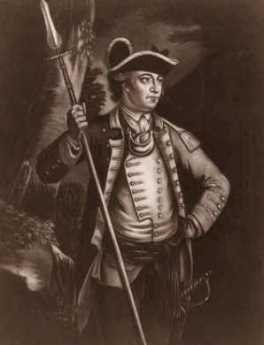
|
| Sullivan |
George Washington had plenty of other problems to contend with in 1778, but an Indian uprising led by Loyalists was too much. He singled out General John Sullivan, a celebrated Indian fighter from New Hampshire, gave him four thousand troops, and told him to eliminate this Indian threat to the Continental Army's rear, remove the safe haven for Loyalists, and assist the new Indian allies which LaFayette had befriended in the Albany area before the battle of Saratoga.
From long experience, Sullivan knew what to do, and did it without remorse. Ignoring skirmishes and ambushed sentries, he marched his troops from the scene of the massacre straight into the heart of Iroquois homeland, destroying every source of food or Indian settlement he could find. He was not interested in winning battles, he was determined to starve the Indians into extinction, once and for all. After these two slaughters, a white one in the Wyoming Valley (the Connecticut squatters in Wilkes-Barre), and now a red one in upstate New York, the entire frontier north of Pennsylvania has left a scene of devastation. Not much was heard of Indian fighting on this frontier for the rest of the Revolutionary War. Indeed, only the novels of James Fennimore Cooper make much subsequent mention of the Iroquois in American history.
Swashbuckler
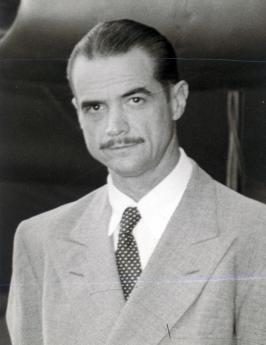
|
| Howard Hughes |
In 1947, Howard Hughes was summoned to Washington to testify at a Senate hearing. Claude Pepper, Democrat of Florida, was in the chair, clearly angry about Hughes' conduct of munitions contracts, including flagrant non-performance. Three wooden flying boats had been commissioned for $18 million but not produced, people had been killed in crashes of test planes, and the newspapers were full of obscure allusions to unspecified wrong-doing in high places. Although the Hughes hearings were front page news for weeks, in those days it was only necessary to walk in and sit down if you wanted to watch them.
Under the circumstances, it would have been understandable if Hughes had been reduced to a trembling mumbler, probably advised to "take" the Fifth Amendment with every question. Congressional chairmen, particularly Claude Pepper,
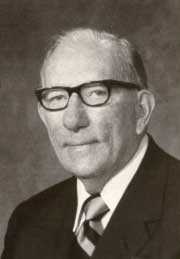
|
| Claude Pepper |
quite regularly grandstand and bully the helpless witness at hearings like this, since it portrays them to the voters as heroic defenders of the public interest, and could even forward their chances of becoming a Presidential candidate. Hughes the scapegoat seemed to be in for a public flogging. The first step was to haul him before the committee and then keep him waiting for an hour or so, while the members attended to important public business, maybe even had to go for a roll-call vote or something. You could tell that things were not going according to the usual script when Hughes himself arrived quite late, accompanied by quite a large staff or retainers. When Pepper still delayed the hearing, Hughes called for a newspaper and elaborately read the comic pages.
The Texas swashbuckler didn't look the part. His accent and tailoring reflected a New England boarding school, and while his mustache resembled that of his friend Errol Flynn, he had a voice like a lion and lightning retorts that would do credit to Bill Buckley. Reminding the Chairman that he had been deafened in the crash of a racing plane, he asked him to repeat the question. Sorry, please repeat it again. And again, and again. Pepper was beside himself.

|
| The Spruce Goose |
Flustered, Pepper tried to reverse the treatment. Senator, I have already answered that question. Well, answer it again. No, I stand on my previous testimony. I forget what you said. Have the stenographer read it to you. Her transcript is not complete. Very well, my own secretary will read it back to you.
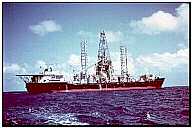
|
| Glomar Explorer |
As if to demonstrate that he hadn't defrauded the government, Hughes, who always test-piloted his own planes, flew the H-4 about a mile in less than a minute during what was supposed to be a taxiing test on November 2, two months after his congressional testimony.
In another strange and unexplained footnote, the Glomar Explorer was a ship built in Philadelphia and used in Project Jennifer in an attempt to salvage a sunken Russian nuclear submarine and discover any secret technology it might contain. This was long past the time when Hughes was supposed to be disgraced and banished from Government contracts. The Senate hearings obviously had no effect on his status, and indeed might even have been entirely staged to mislead the Russians and others. Like so many things in his life, this episode has no readily obvious explanation.
Only in retrospect is it possible to see that Hughes was involved in lots of top-secret matters, and the bravado of his defiance -- not to say contempt of Congress -- might have had roots in some sure knowledge Pepper would not dare touch him. The CIA commissioned him to build the Glomar Explorer to find a sunken Russian submarine, using a phony story of manganese recovery. The supposed political victim of the much later Watergate break-in, Larry O'Brien, is said to have once been a Hughes employee; on the other hand, Hughes was very close to the Nixon Administration. There were inevitably many ties between his Las Vegas gambling empire and Cuban underworld figures, as well as Hollywood figures. Hughes was an owner of the Dallas movie theater where John Kennedy's murderer Lee Oswald tried to hide and was captured. It is not possible to judge Howard Hughes by the usual standards; this eccentric billionaire was capable of doing unimaginable things and it will be remarkable if spectacular news about him ends with his death.
Taking Care of Our Veterans
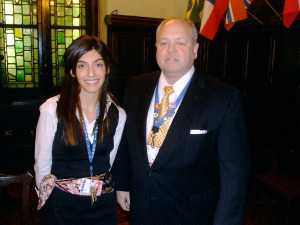
|
| Alexandra Esposito and Stephen Bennett |
The Civil War was barely over before Abraham Lincoln instituted programs designed to aid those wounded soldiers returning home from battle. Over the years such aid was expanded as both the needs and treatment expertise increased and in 1930 the Department of Veteran's Affairs was officially established. President Clinton elevated the department to cabinet level in 1996 and today there is virtually nothing that cannot be handled. Stephen Bennett and Alex Esposito described what is being done for our vets here in Philadelphia and throughout the country.
It's not too difficult to imagine how the horrors of war can affect our soldiers in both body and mind in ways that could not be imagined back in the 1860s when Lincoln first recognized our duty to those who put their lives on the line for us. Today, with such sophisticated ways of destroying life, the challenges call for specialized programs and the department seems to be doing a reasonable job at keeping up with destructive devices. Nothing bad ever seems to go away, we just find new types of injuries all the time to add to the list. For instance, we're seeing many cases of head injury caused by percussive types of weapons which cause severe brain damage while affecting only slightly the outer layers, like the skull and scalp. Special groups and operations have been formed within the department all along the way, the latest dealing with the special needs of the Iraq and Afghanistan troops.
The Philadelphia main office of the Veteran's Administration for Health is located at 39th and Woodland, right next to the University of Pennsylvania which it works closely with. Satellite offices such as those in Fort Dix, Coatesville and Gloucester, NJ, provide convenient locations for treatment of those not close to town. With a staff of over 2000 doctors, nurses and social workers and a budget of $330 million the area handles well-over 400,000 client visits each year. The Philadelphia unit is at the forefront of using the latest in electronic storage and retrieval systems to access records wherever they might be and has received awards for their expertise. The hospitalization facilities have improved steadily and the open bay wards are a thing of the past as are the archaic and makeshift diagnostic and operating facilities - everything is becoming as state-of-the-art as the civilian facilities.
The psychiatric clinic is especially busy as its services are recognized as being every bit as important nowadays as an actual trauma treatment. Substance abuse, post-traumatic stress disorders, suicide prevention, and severe depression are being treated aggressively by teams of doctors and social workers using both medication and therapy. If only we could treat those people who take us to the brink of war and beyond, maybe we could put the need for such departments as this out of business. Maybe someday...
Second Amendment: The 28th Infantry Division
SINCE the nation was only formed in 1776, and the only memorable war before that was the French and Indian War of 1754, the origin in 1747 of the Pennsylvania 28th Division of Infantry needs a little explaining. The 28th is a National Guard reserve unit, taking its present organizational form 138 years ago. Even counting from that moment makes it the oldest (and third largest) division in the Army, but another 123 years of history stretch back before that.
 AMENDMENT II A well-regulated militia, being necessary to the security of a free state, the right of the people to keep and bear arms, shall not be infringed. 
|
| Second Amendment |
A few people remember that Ben Franklin made his first step into politics during King George's War (1744-48), when French and Spanish privateers were suddenly roaming Delaware Bay . The pacifist Quaker government hesitated in confusion, so Franklin stepped forward to call for a volunteer militia. It was paid for with a lottery because the Quaker legislature resisted; there seemingly was no end to Franklin's ingenuity. The unit remained a permanent one, and since then served with distinction in the various conflicts through the Civil War, when it was organized into the National Guard. The volunteer movement it inspired was part of the impetus for the Second Amendment to the Constitution which the National Rifle Association will be glad to explain to you, although historians commonly trace the civilian soldier tradition back to King James and the English Civil War. Franklin was unfailingly patriotic, and never hesitated about military measures when they seemed necessary. He lived long enough so his military sympathies were still a dominant force at the Constitutional Convention, more than forty years later.
Major General Wesley E. Craig Jr., former commander of the Division, was kind enough to address the Right Angle Club about the 28th Division recently. Since the citizen soldiers of the National Guard all have other careers, his daytime job was as an executive for Strawbridge and Clothier. A moment of reflection about the Scottish origin of his own name, connected with a strongly Quaker firm, evokes the two strongest social and ethnic tensions of early Pennsylvania history.
The audience was treated to a description of the military history of the unit, whose largest battle was the Battle of the Bulge in World War II. But they are in Iraq today, with almost every soldier having served one tour of duty, many of them two or even more. They were the unit stationed in El Ambar province during the period before the Sheiks finally decided that America was going to win this war, and changed sides. General Craig had returned to America only a month before this famous turning-point. Before that, units of the 28th were in Bosnia and Kosovo, and are proud to have been chosen for the introduction of many innovative technologies. They are the only reserve division with Stryker vehicles, and before that employed unmanned drone aircraft for reconnaissance. Observer drones fly at 2000 feet and carry no weapons, unlike the Predator drones which carry rockets and fly at 10,000 feet.
Not everything is a story of combat action; the 28th Division is very proud of its activities in the Katrina rescue missions and other domestic emergencies. The Go Ahead Division is proud of its reputation for being on time, every time.
And it is mindful of the sad side. In Iraq, it is 31 KIA, with 167 WIA. If you're uncertain what that means, try a little harder.
The Battle of Germantown: Oct. 3, 1777
After its brief commotion from the unwelcome French and Indian War, Germantown settled down to a 22-year period of colonial inter-war prosperity and quite vigorous growth. Most of the surviving hundred historical houses of the area date from this period, and it might even be contended that the starting of the Union School had been a beneficial stimulus.
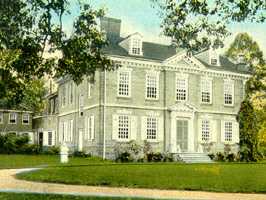
|
| Cliveden |
Two decades passed. What we now call the American Revolution started rumbling in far-off Lexington and Concord, soon moved to New York and New Jersey. General William Howe, the illegitimate uncle of King George III, then decided to occupy the largest city in the colonies, tried to get his brother's Navy up Delaware but hesitated to persist in a naval attack on the chain barrier blocking the river. He considered but abandoned trying to outflank the New Jersey fort at Red Bank, the land-based artillery at Fort Muffling, and heaven knows what else along the twisting shaggy Delaware river. Giving up on that approach, Howe sent the navy down to Norfolk and back up the Chesapeake, landing the troops at the head of the Elk River. Washington was outflanked at the Battle of the Brandywine Creek trying to head him off, although he suffered far fewer casualties than the British. A rainstorm, presumably a fall hurricane, disrupted his planned counterattack near Paoli. So Howe invested Philadelphia, organizing his main defensive position in the center of Germantown. His headquarters were in Stenton and Morris House, General James Agnew was at Grumblethorpe The Center of British defense was at set up at Market Square where Germantown Avenue crosses Schoolhouse Lane. With Washington retreating to Valley Forge, that should take care of that. Raggedy rebels were unlikely to attack a prepared hilltop position with a river on either side, defended by a large number of British regulars.
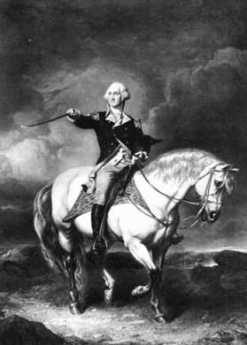
|
| George Washington |
Washington did not look at things that way, at all. Cut off from their fleet, the British situation would be precarious until Delaware could be re-opened. He had watched General Braddock conduct with bravado an arrogant suicide mission in the woods near Ft. Duquesne, and also knew the British always based as much strategy as possible on their navy. Washington's plan was to attack frontally down the Skippack Pike with the troops under his direct command, while Armstrong would come down Ridge Avenue and up from the side. General Greene would attack along Limekiln Road, while General Smallwood and Foreman would come down Old York Road. In the foggy morning of October 3, the main body of American troops reached Benjamin Chew's massive stone house, now occupied by determined British troops, and General Knox decided this was too strong a pocket to leave behind in his rear. Precious time was lost with an artillery bombardment, and unfortunately, the flanking troops down the lateral roads were late or did not arrive at all. The forward movement stopped, then the British counter-attacked. Washington was therefore forced to retreat, but he did so in good order. The battle was over, the British had won again.
But maybe not. Washington hadn't routed the British Army or forced them to leave Philadelphia. They did leave the following year, however, and there was meanwhile no great desertion from the Colonial cause. Washington's troops suffered terrible privation and discouragement at Valley Forge, but the crowned heads of Europe didn't know that. For reasons of their own, the French and German monarchs were pondering whether the American rebellion was worth supporting, or whether it would soon collapse in a round of public hangings. From their perspective, the Americans didn't have to win, in fact, it might be useful if they didn't. But if they were spirited and determined, led by a man who was courageous and resolute, their damage to the British interests might be worth what it would cost to support them. The Battle of Germantown can thus be reasonably argued to have been an advancement of colonial goals, even if it could not be called a victory. However, when the news of Burgoyne's defeat at Saratoga soon reached them, the European enemies of England decided the colonists would be useful allies.
In Germantown itself, the process of turning a military defeat into a strategic victory soon began, with severe alienation of the German inhabitants against the destructive experiences of British military occupation. After a winter of near starvation, Germantown would never again see itself as the capital city of a large German hinterland. It was on its way to becoming part of the city of Philadelphia.
The Pennamite Wars: Who Had The Last Word?
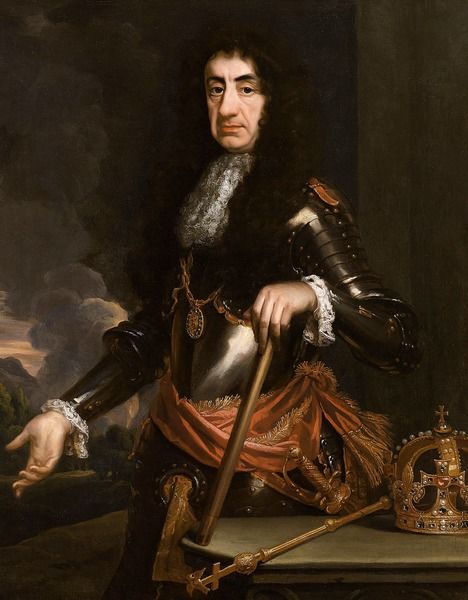
|
| King Charles II |
Pennsylvania once fought three wars with Connecticut, but nowadays most people in both Connecticut and Pennsylvania have never heard of it. Those who do know, call them the Pennamite Wars. As you might expect, accounts by Connecticut patriots portray the matter as just taking possession of what they owned. Pennsylvania accounts of the wars, on the other hand, describe them as a stout defense against invasion. The matter boils down to the undisputed fact that King Charles II gave what is now the northern third of Pennsylvania to Connecticut in 1662, and in 1681 the same king gave it to William Penn. Eighty years after that, in 1769, Connecticut moved in, and Pennsylvania threw them out. It all happened twice more, and the Continental Congress became distressed that two of the thirteen colonial allies were fighting each other instead of the British. So it had to be resolved in court, and therefore we all have to get a little education in the fine points of real estate law in order to understand why Pennsylvania won the case. In short, Connecticut claimed that Charles II had cruelly and unjustly reversed himself, while the Penn Proprietorship simply maintained they were nonetheless legally entitled to the property.
Let's look at this dumb situation from the lawyers' point of view. If you own some land, but someone says you don't, your first response would be to show that the last owner turned it over to you without strings attached. And then you show that the title passed person-to-person backward in a clear chain of unclouded ownership. As long as this is provable, the critical deciding factor rests on what right the "original" owner had to it, from the Indians, or a King, or government charter. No one can be found to claim ownership earlier than that, so it must be yours.
The critical point is that "the original owner" is, therefore, the first private (non-governmental) owner. We are so used to this legal convention that it can be upsetting to discover that things were exactly opposite when we had a king -- and that our courts still uphold the monarch's decrees. Kings had a right to do absolutely anything, and that divine right, therefore, included the ability to revoke private ownership and take the property back or give it to someone else. Establishing a clear title is now a process of tracing back to the last moment when someone still had an absolute right to do anything he pleased with it. If what he did was cruel and unjust, too bad.
As soon as you trace your title back to a king or other absolute tyrant, the courtroom situation effectively reverses. At that critical turning point, the important issue stops being what a still-earlier owner intended and becomes what the final owner said. The last word of the last monarch extinguishes anything intended by anybody earlier. Even after all this ponderous logic is thoroughly explained, perhaps even repeated, the loser of a case goes away dissatisfied and angry. It ain't right.
It is right, of course, since you can't be an absolute monarch if you can't do what you please. If someone was an absolute monarch in the past, whatever he said was his right, and it would be disruptive to overturn in retrospect what seemed perfectly orderly at the time. The whole progress from Magna Carta to American Revolution was to accept old confiscations as final, as the necessary price of putting an end to having any new ones. After the cutoff point, the right to transfer property became the sole discretion of the current owner. The transfer of sovereignty from governmental to individual ownership was a serious main issue in the Revolutionary War.
Pennsylvania thus fought three Pennamite wars with Connecticut over conflicting land grants by kings, and also got into hot but non-military quarrels with Virginia and Maryland over much the same issues. If Pennsylvania had lost these disputes, the Commonwealth would now be little more than an eighth its present size. Pittsburgh would be in Virginia, Scranton would be in Connecticut, and Philadelphia would be a city in Maryland. Perhaps that wouldn't be so bad -- after all, maybe they don't have a city wage tax in Maryland.
What would be very bad, and therefore is the heart of the matter, is that we probably would have undergone two hundred years of contested titles and maybe even shooting wars, as a result of having property ownership in constant dispute. After a couple of generations, it matters less who was right and who was wrong. What begins to matter more is that things get fairly and finally settled so everyone can get on with his life.
The Richest Men in America
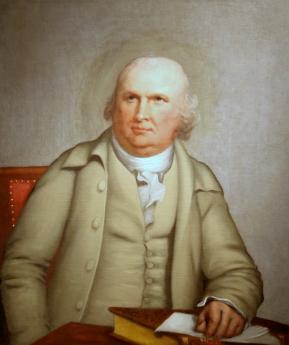
|
| Robert Morris |
Charles Peterson developed the idea but was unsuccessful in popularizing it, that Spruce Street in central Philadelphia could be regarded as an architectural museum. It stretches from river to river but has no bridge or ferry landing at either end, so traffic is less. The earliest house still standing near the Delaware River was built in 1702, with successive houses just a little younger, or at least less old, as you progress toward Broad (14th) Street whose houses were built around 1880. And then onward into the early Twentieth Century, crossing Broad Street and going westward toward the Schuylkill. For a century or more West Spruce Street was where eminent specialists had offices, much like Harley Street in London, which it somewhat resembles. The medical flowering of this area was promoted by the surgical advancements of the nearby Civil War, as well as the contributions of Andrew Carnegie to moving the College of Physicians from 13th street to 21st Street, attracted toward the 7000-bed Civil War hospital which turned into Philadelphia General Hospital in West Philadelphia. A number of these houses are just plain too big to be manageable as single family houses today, and Spruce Street West has lagged Society Hill and other Easterly sections in restoring its buildings. Perhaps in a few decades, that will happen, and perhaps in the meantime, the present relics will be preserved enough to revive someday the idea of a house design museum. Meanwhile, West Philadelphia around Spruce Street has obstructed progression by plonking the University of Pennsylvania, Drexel University and the Science Center as obstacles to residential housing development.
So let's take a simpler idea. For roughly a century, the then-richest men in America lived in one of several houses located within seven blocks of each other, easy walking distance for a tour. The first to attract notice as a self-made rich man was Robert Morris. Morris made his money in shipping, maybe even a little privateering, and then went into banking to keep his money at work. It is said that his personal fortune, adjusted for changes in the currency and economy, was once considerably larger than Bill Gates' would be today, adjusted for inflation. As most people know, Morris financed the American Revolution personally, went broke, ending up in debtor's prison. The first real mansion he lived in was opposite Independence Hall on Market Street, now celebrated as George Washington's while he was the first president. It was earlier the place where British Admiral Gates lived while he was in charge of the 1788 British occupation, and although it was also where Washington lived during most of his presidency, the house burned down in 1832. This house is not to be confused with either the house built for Washington at 9th and Market but never occupied by him or Morris's later mansions which he also never occupied because of financial difficulties. One house in the midst of Jeweler's Row was so ornate some think it contributed heavily to his later bankruptcy. A second Morris house still stands on Eighth Street at St. James Street, but it belonged to the Quaker Morris family, no relation. Other owners named Morris bought and occupied this place for a number of years, so its history is a little mixed up, presently as a fancy restaurant. A DuPont heiress once bought and fixed it up, but her husband commented no one could sleep in that house because a subway built underneath it badly rattled its timbers. Next door to the Quaker Morris house rises a fifty story apartment house, whereas a precaution against rattles, the first nine stories contain nothing but parking spaces. Since the apartment building is owned by Arabs, it is likely they are pretty rich but not necessarily richer than Bill Gates. Aside from the Market Street partial restoration, the main Robert Morris remnant is on Lemon Hill, northwardly opposite the Art Museum, whereas the main Quaker Morris house is in the Morris Arboretum in Chestnut Hill. There are sixty or so Morris's listed in the Social Directory, so keeping the two families distinct remains a difficulty in some circles.
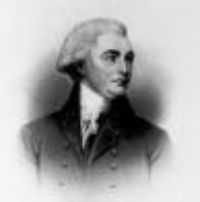
|
| William Bingham |
On the Northeast corner of Third and Spruce Street, once lived William Bingham, a former partner of Morris and later himself the richest man in America. Although sadly the house burned down, it is displayed in one of the famous prints by William Birch in his notable Eighteenth Century collection , widely available in bookstores. The striking thing about Bingham was that he was only twenty-eight years old when he achieved richest-man status and built the house, patterned after one owned by a British Duke. He made his pile three times over. First, running a privateer operation in the Caribbean for his partner Robert Morris. On returning home, he bought up any worthless Continental currency he could stuff into barrels, and then either persuaded his friend Alexander Hamilton to redeem the currency at par or heard his plan to do so. And then, as if he didn't have enough money already, he invested enough gold bars to finance the Louisiana Purchase for Jefferson, since Napoleon wanted gold, please, no paper money. Among the various things he bought as an investment was the area in upstate New York, now called Binghamton. He lost a pile of money buying the land we now call the State of Maine since post-revolutionary Westward migration turned toward Ohio rather than into his Maine holdings once the British prohibition on colonizing past the Allegheny mountains was lifted. Bingham's sister-in-law wanted to become engaged to the heir of the Crown of France, who was living in temporary exile around the corner on Walnut Street. In a famous, possibly fictional, response, the Dauphin was told, No. If you do not become the King of France, you will be no match for her "The Golden Voyage". Quite a good read, and of particular interest to Philadelphia lawyers who learn Bingham died in 1804, but his estate was not settled until 1960. The lawyer who closed the case reported his partners were less than pleased to see it go.
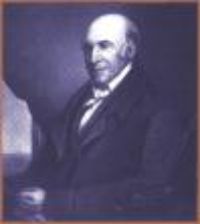
|
| Stephen Girard |
Stephen Girard built several houses a few steps west of Bingham on Spruce Street, identifiable by having marble facing on their lower few feet; Charles Peterson lived in one of them as the first pioneer resident of the Society Hill revival. Girard made his money in the China trade, as a ship's factor. Like Morris, he recognized America's crying need for banking in a story too complicated to repeat here and moved the Girard Bank into the First Bank of America, now a museum (Peale portraits, architectural fragments) of the Park Service on Third Street. His wife was insane, and spent most of her life at the Pennsylvania Hospital at Eight and Spruce, and was eventually buried there. Girard left thirty million dollars to found the Girard College for "poor, white, orphan boys". His 1830 will withstood all legal attacks until the mid-Twentieth Century but was eventually broken. The school now has many black girls, is bankrupt, and the definition of orphan has expanded to include any child whose parents are separated. The definition of "poor" is several times greater than the national definition of the poverty level. In his will, Girard specified that the estate should purchase what is now Schuylkill County and hold it for a century. Shortly thereafter (or just possibly very shortly before that), coal was discovered in the region and Girard College became far richer. His correspondence includes many letters to Lafitte the Pirate, so more may be heard of them.
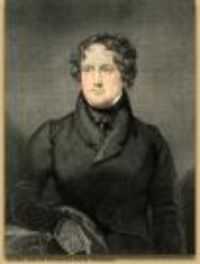
|
| Nichlos Biddle |
Nicholas Biddle had "old money", which he made in the traditional way of buying real estate, particularly in Ohio. He thus made a better guess than Bingham about the likely path of westward migration. But like Morris and Girard, he needed a bank to finance the real estate. Biddle also acted as the reserve bank for the myriads of currencies then issued by individual rural banks and charged a transaction fee to translate Kentucky money into something useful in Philadelphia or abroad. Martin Van Buren, who was the political manipulator behind Andrew Jackson and who became Andrew Jackson's eventual successor, stirred up trouble about this reserve role, and Jackson "broke" Biddle's bank by withdrawing federal deposits. Jackson's complaint was that holding federal "paper" eventually resulted in a government guarantee the bank could never fail, in an echo of the present accusation of some banks being "too big to fail". Ultimately, investment banking began to take its modern formwhen in 1838, the richest man, Anthony J. Drexel, moved over the Schuylkill River on Walnut Street, amidst what is now the University of Pennsylvania, but not far from Drexel University. He walked to work each day, however, at 4th and Chestnut Streets. Drexel was the first big banker to make his fortune in banking, and when he died it was said Philadelphia banking died with him. The earlier big bankers started out with money they had made in shipping or land speculation, but Drexel somehow saw that banking was a different way to get rich, deftly filling in the gap created by Andrew Jackson shuttering Nicholas Biddle's Second Bank. Part of the idea in Van Buren's mind was to shift the focus of American banking from Philadelphia's Chestnut Street to New York's Wall Street, and he was quickly quite successful. J.P. Morgan was invited by Drexel to start a Wall Street partnership with him in correspondence with his father, Junius Morgan, who ran an international bank in London. In the era just after the Civil War, there was a great deal of money in Europe anxious to be invested in the railroads and other booming American industries. The Morgans provided a vehicle for transferring such investment capital between continents, but the Morgans were viewed as having excessively sharp practices. As it happened, Junius Morgan had been trained in this transoceanic concept by George Peabody, a former Baltimore resident who had moved to London, then, the banking capital of the world.
George Peabody earlier had also been involved with Anthony J. Drexel, and Drexel was the more successful of the two international bankers. The whole issue with European investors was whether you could trust those wild and wooly Americans, and Drexel consistently demonstrated he was entitled to be called a straight arrow. As related by a good book by Dan Rottenberg Drexel decided he needed the vigor of the Morgans and invited them to join him in a New York-Philadelphia partnership. From that point forward, JP Morgan was the shining star of honesty and straight dealing, a lesson he evidently learned from Drexel. Indeed, he and his biographers repeatedly stress this feature of him -- "I will never do business with a man I don't trust". He didn't mention women, but his behavior seems to show he probably didn't include them in the concept. Drexel, on the other hand, led a quiet sober life in West Philadelphia, reading books, starting his university, and helping his niece, who was later made a Saint in the Catholic Church, start numerous charities. Although the Drexel children more or less drifted out of sight, Drexel's business successor Stotesbury led a wild and extravagant lifestyle that is the subject of many songs and stories. His wife, for example, never washed the sheets; she always had brand new ones put on the bed. Morgan, of course, spent lots of money in a conspicuous way. The term Metropolitan identifies most of his projects, The Metropolitan Art Museum, The Metropolitan Opera, The Metropolitan Club on Fifth Avenue, with membership originally limited to his partners. The name Corsair also was a trademark, the name of his yachts, and a firm statement about his approach to things. Another difference between the Morgans and the Drexels was similarly in the New York-Philadelphia character. When Jack Morgan, the son of JP, died in the 1930's he left an estate of "only" three million dollars. It would be hard to say what the Drexel fortune was worth at that time, but it is safe to say it would dwarf that, considerably. Most of the Drexel family moved to London, but among other things, financed the restoration of the Benjamin Franklin House on Craven Street, a hundred feet from Trafalgar Square. When the House of Drexel was much blamed for the 1987 stock market crash, legions of Drexel defenders rose to protect the family name. Cabrini College, Eastern University, Valley Forge Military College, St. David's golf course and much of Radnor are only pieces of the Drexel holdings, today.
The Third Pennamite War (1778-1784)
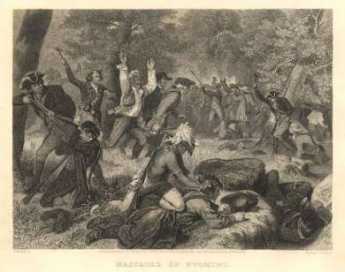
|
| Wyoming massacre |
And so, after the Revolution was finally over, there was a third war between Pennsylvanians and the Connecticut born settlers of the Wyoming Valley. This time, the disputes were focused on, not the land grants of King Charles but the 1771 land sales by Penn family, most of which conflicted with land sales to the Connecticut settlers by the Susquehanna Company. The Connecticut settlers felt they had paid for the land in good faith and had certainly suffered to defend it against the common enemy. The Pennsylvanians were composed of speculators (mostly in Philadelphia) and settlers (mostly Scotch-Irish from Lancaster County). Between them, these two groups easily controlled the votes in the Pennsylvania Assembly, leading to some outrageous political behavior which conferred legal justification on disgraceful vigilante behavior. For example, once the American Revolution was finally over (1783) the Decision of Trenton had given clear control to Pennsylvania, so its Assembly appointed two ruffians named Patterson and Armstrong to be commissioners in the Wyoming Valley. These two promptly gave the settlers six months to leave the land, and using a slight show of resistance as sufficient pretext, burned the buildings and scattered the inhabitants, killing a number of them. One of the weaknesses of the Articles of Confederation was thus promptly demonstrated, as well as the ensuing importance of a little-understood provision of the new (1787) Constitution . No state may now interfere in the provisions of private contracts. Those with nostalgia for states rights must overcome a heavy burden of history about what state legislatures were capable of doing in this and similar matters, in the days before the federal government was empowered to stop it.
A flood soon wiped out most of the landmarks in the Wyoming Valley, and it had to be resurveyed. Patterson, whose official letters to the Assembly denounced the Connecticut settlers as bandits, perjurers, ruffians, and a despicable herd, boasted that he had restored, to what he called his constituents, "the chief part of all the lands". The scattered settlers nevertheless began to trickle back to the Valley, and Patterson had several of them whipped with ramrods. As the settlers became more numerous, Armstrong marched a small army up from Lancaster. He pledged to the settlers on his honor as a gentleman that if both sides disarmed, he would restore order. As soon as the Connecticut group had surrendered their weapons, they were imprisoned; Patterson's soldiers were not disarmed at all and assisted the process of marching the Connecticut settlers, chained together, to prison in Easton and Sunbury. To its everlasting credit, the decent element of Pennsylvania was incensed by this disgraceful behavior; the prisoners somehow mysteriously were allowed to escape, and the Assembly was cowed by the general outrage into recalling Patterson and Armstrong. Finally, the indignation spread to New York and Massachusetts, where a strong movement developed to carve out a new state in Pennsylvania's Northeast, to put a stop to dissension which threatened the unity of the whole nation. That was a credible threat, and the Pennsylvania Assembly appeared to back down, giving titles to the settlers in what was called the "Confirming Act of 1787". Unfortunately, in what has since become almost a tradition in the Pennsylvania legislature, the law was intentionally unconstitutional. Among other things, it gave some settlers land in compensation that belonged to other settlers, violating the provision in the new Constitution against "private takings", once again displaying the superiority of the Constitution over the Articles of Confederation. It is quite clear that the legislators knew very well that after a protracted period of litigation, the courts would eventually strike this provision down, so it was safe to offer it as a compromise and take credit for being reasonable.
It is useful to remember that the Pennsylvania legislature and the Founding Fathers were meeting in the same building at 6th and Chestnut Streets, sometimes at the same moment. Books really need to be written to dramatize the contrast between the motivations and behavior of the sly, duplicitous Assembly, and the other group of men living in nearby rooming houses who had pledged their lives and sacred honor to establish and preserve democracy. To remember this curious contrast is to help understand Benjamin Franklin's disdainful remarks about parliaments and legislatures in general, not merely this one of which he had once been Majority Leader. The deliberations of the Constitutional Convention were kept a secret, allowing Franklin the latitude to point out the serious weaknesses of real-life parliamentary process, and supplying hideous examples, just next door, of what he was talking about.
The Wyoming Massacre of July 3, 1778
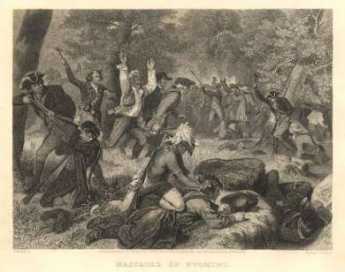
|
| The Wyoming Massacre |
The six nations of Iroquois dominated Northeastern America by the same means the Incas dominated Peru -- commanding the headwaters of several rivers, the Hudson, the Delaware, and the Susquehanna, as well as the long finger lakes of New York, leading like rivers toward Lakes Ontario and Erie. They were thus able to strike quickly by canoe over a large territory. Iroquois were quite loyal to the British because of the efforts of Sir William Johnson, who settled among them and helped them advance to quite a sophisticated civilization. It even seems likely that another fifty years of peace would have brought them to an approximately western level of culture. Aside from Johnson, who was treated as almost a God, their leader was a Dartmouth graduate named Brant.
Brant, The Noble Savage
The mixed nature of the Iroquois is illustrated by the fact, on the one hand, that Sachem Brant translated the Bible into Mohawk and traveled in England raising money for his church. On the other hand, his biographers trouble to praise him for never killing women and children with his own hands. British loyalty to these fierce but promising pupils was one of the main reasons for the 1768 proclamation forbidding colonist settlement to the West of what we now call the Appalachian Trail, which on the other hand was itself one of the main grievances of the rebellious land-speculating colonists. The Indians, for their part, saw the proclamation line as their last hope for survival. After Burgoyne's defeat at Saratoga, the Indian allies were free to, and probably urged to, attack Wyoming Valley.
It is now politically incorrect to dwell on Indian massacres, but this one was both exceptionally savage, and very close to home. The Iroquois set about systematically exterminating the rather large Connecticut sub-colony and came pretty close to doing so. Children were thrown into bonfires, women were systematically scalped and butchered. The common soldiers who survived were forced to lie on a flat rock while Queen Esther, "a squaw of political prominence, passed around the circle singing a war-song and dashing out their brains." That was for common soldiers. The officers were singled out and shot in the thigh bone so they would be available to be tortured to death after the battle. The Wyoming Massacre was a hideous event, by any standard, and it went on for days afterward, as fugitives were hunted down and outlying settlements burned to the ground.
It's pretty hard to defend a massacre of this degree of savagery, but the Indians did have a point. They quite rightly saw that white settler penetration of the Proclamation Line would inevitably lead to more penetration, and eventually to the total loss of their homeland. The defeat of a whole British Army under Burgoyne showed them that they were all alone. It was do or die, now or never. Countless other civilizations have been extinguished by provoking a remorseless revenge in preference to a meek surrender.
Thieves of Baghdad
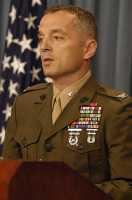
|
| Col. Matthew Bogdanos |
Col. Matthew Bogdanos, of the U.S. Marines, gave an interesting insight into what the Baghdad Museum really was, how it was captured, and how the treasures were recovered, at the University of Pennsylvania Museum the other night. Our own museum is said to be the second largest archeology museum in the world, after the British Museum. After discovering what was really in the Baghdad museum, that ranking may have to be revised; but the chief Philadelphia interest traces back to the discovery of the ancient city of Ur by Philadelphia archeologists during the last century, an event which essentially created the University Museum. This was where civilization began, and we discovered it.
The reserve Colonel happens to be a prosecutor for the New York District Attorney, was trained extensively in classical antiquities; and so was the perfect point man to lead the capture of the Museum during the Iraq war, very well suited to follow the looted treasures into the international antiques market -- and recover substantially all of it. Something like 62,000 pieces were recovered, and all of Nimrud's Treasure, the prize possession of the museum.
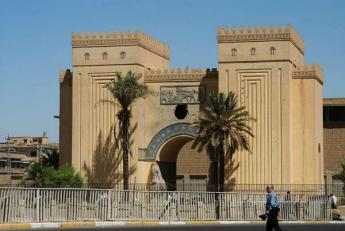
|
| The Baghdad Museum |
There has been criticism of our troops -- some of it right out of this evening's Philadelphia audience -- for allowing the place to be looted in the first place. But that sort of assumes the place was lying vacant and undefended while our troops were out shooting innocent civilians. That's a misapprehension quickly dispelled by videotaped scenes of real live shooting and rockets coming out of the place at the time, which the Colonel was happy to display. Questioners were invited to claim they would have been willing to go into that hornet's nest in order to save alabaster statues, but others in the audience inclined to giving the Marines some benefit of doubt.
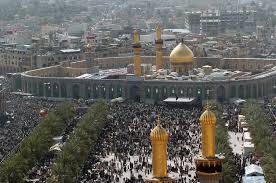
|
| Hussein Millions |
That place was vandalized when the troops got into it; to say it was thoroughly vandalized is only true in a sense. There was indeed a lot of looting, but the bigger surprise was to find there were hidden storage rooms behind steel bank doors, filled with the really best antiques, as well as vast boxes of American hundred-dollar bills. By weighing the hundred dollar bills (22 pounds for every million dollars) it was estimated that Saddam Hussein had about $800 million in U.S. currency stored in that one place. Gold as a raw commodity has since gone up considerably in value, but many of the best antique gold pieces on display in the museum were only copies, the originals were kept in the secret vaults. The international market appraises quite a few of these pieces at over $10 million apiece. Apparently, the thieves knew exactly which pieces were valuable, and went straight to them without even pausing to notice other rooms full of objects of lesser value. The museum had been closed to the public for the previous twenty years; it seems rather obvious that Saddam was storing these objects in order to buy weapons for continuing guerilla activities underground, or in exile. The museum itself consisted of nearly twenty separate buildings in the center of Baghdad, and the custodians obviously must have known where things of serious value were kept, in order to get to them so precisely.
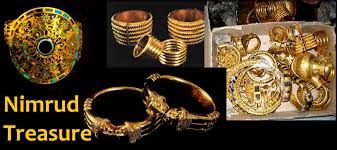
|
| Nimrud's Treasure, |
Offering an amnesty, no questions asked, brought in thousands of recoveries from the local public. Getting other pieces back from art galleries in London, Geneva and Berlin required methods that were not described in detail. Some of us who remember the German and Japanese mementos which were "liberated" during World War II have an immediate appreciation of the improved American troop discipline which must have been imposed in the Iraq War. That's something to think about, too. Our troops had been given extensive training to respect the cultural heritage of the enemy, and they evidently did so to a remarkable degree. One certainly has to doubt that Saddam was locking that material in vaults for twenty years in order to preserve the culture of any sort. If it had any other purpose than to serve as a way of transforming oil wealth into munitions, it's a little hard to imagine what it was.
Veterans Hospital
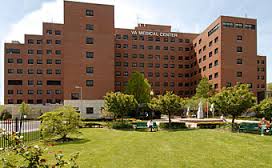
|
| Philadelphia VA Medical Center Home |
At a recent meeting of the Right Angle Club, Stephen C. Bennett an administrator, and Alix Esposito a social worker, kindly addressed the club about the Veterans Hospital where they work. The federal government pushes its mass produced products into every city, but gradually a local flavor starts to creep in; how this process works is illustrated by the fact that Steve's grandfather Claude was once the manager of the Bellevue Stratford Hotel. The VA hospital may be a piece of Washington D.C. planted on Philadelphia soil, but Philadelphia will surely absorb it with the passage of enough time. The VA was once a part of the Veterans Administration, but now it is a part of Department of Veterans Affairs, run by a Cabinet Secretary, no less. It's the second largest department of the federal government, and since the only bigger department is the Department of Defense, the combination of the two shows you how far we have come from the nation's original opposition to "standing armies". The fact that these two components of our war machine are separate, on the other hand, surely symbolizes some hidden tensions between our regular armed forces and the American Legion, or the hidden frictions between two congressional committees, or else some other mystery of bureaucratic politics.
The Veterans Administration was founded in 1930, the Philadelphia VA Hospital was built in 1950. Originally, it was designated as a Deans Hospital, signifying the intention to confer prestige and lessen friction with the medical schools. Originally, Philadelphia's VA was affiliated with several medical schools, but in time its proximity to the University of Pennsylvania led to the elimination of ties with other schools. Although the bed capacity is growing in reaction to America's successive wars, its open wards converted after 1960 to more semi-private style, and its focus of medical activity shifting with changes in medical science, the VA remains isolated from the rest of the city and the rest of Philadelphia medicine. Part of this is physical; the hospital is confined by the University of Pennsylvania, the parking complex next to the Amtrak line, and the Woodland Cemetery, so there is little room to grow. And comparatively little commonality with the neighbors. There are 2000 employees and a $30 million budget, marooned in a sea of automobile traffic going elsewhere in a big hurry, too big to ignore but too small to influence the local culture.

|
| Vietnam War |
The patients are distinctly different from those you find in other hospitals. There is a great deal of chronic mental disorder a heavy influence of alcohol and substance abuse and rehabilitation, and even some residential apartments for patients. On a national level, between a third and a half of homeless people are veterans, but for some reason in Philadelphia, only a tenth of the homeless are veterans. During the Vietnam War, the system of draft avoidance through educational exemptions resulted in that generation of veterans coming from an unusual concentration of low income and low educational subgroups. The system of government pensions and promotions tend to retain employees in the system for a lifetime. It's true that informal transfer arrangements allow a certain amount of migration to Florida (in the winter), or Maine (in the summer), or California (to see what LaLa land is all about), but those who do this stay within the VA system. Consequently, the interchange of ideas and techniques that professionals carry with them between hospitals is curtailed, confined somewhat to variations within the VA system, conforming to its social norms. An archipelago, although not exactly a gulag archipelago.
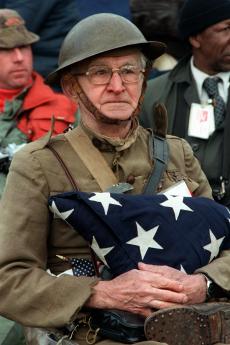
|
| Veteran |
But by far the greatest source of distinctiveness in the VA hospitals comes from the byzantine eligibility standards for the patients. The reimbursement systems of Medicare, private insurance -- which more or less copy each other -- changed around 1988 in a way that more or less eliminated psychiatric inpatient care in the community, especially if it lasts more than a month. The VA, on the other hand, was forced by circumstances to increase its attention to this area. Consequently, all social workers everywhere inquire immediately whether an addict or a schizophrenic might be a veteran. A differential sorting process quickly gets underway, with the VA as the preferred place to send such patients if at all possible. Non-veteran victims of the same conditions tend to have a worsened time of it, because the pressure on state and local governments to make some provision, has been relieved.
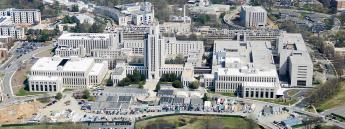
|
| Walter Reed Hospital |
At the other extreme, the social elite of the armed forces are not admitted, either. President Eisenhower was unquestionably a veteran, but he had his famous hospitalizations at >Walter Reed Hospital. There's an income limit for VA admission, which automatically cuts off 20-year veterans above a certain rank, possibly major. And there are overlapping disability classifications for military hospitals and veterans facilities, with considerable latitude available to uniformed boards of three serving officers, only one of whom is a physician. The result is a general perception that if you have any influence at all, you can generally avoid the VA and be treated in a military hospital, probably in a VIP unit. Good for them; I'd take advantage of it if I had a chance, too. But by siphoning off the top brass, a lot of pressure to improve quality is removed as well. If a VA hospital had eight or ten Admirals and Generals as patients, with academy classmates coming to visit, it's safe to assume that courtesy, orderliness, and cleanliness would instantly improve. And take it from me, the quality of care would improve, as well.
War Dance
History Footnote: Before the white man came, the Iroquois "nation"devised rules still characteristic of our modern political parties. At various times, there were five, six, or seven tribes in the Iroquois confederacy headquartered in upstate New York, allied to each other with fluctuating loyalty. Philadelphia's tribe were Delawares or Leni Lenape, but the most warlike and dominant tribe were the Mohawks. Confederations work best when allied against a common foe. The rest of the time, member tribes mostly beat and cheat each other.
The Philadelphia Democratic Party appeals to a number of minority groups and recent immigrants, but it is more meaningful to think in terms of players. For example, university professors are mostly Democrats, but the teachers union is an active political player. Minorities generally vote Democratic, but the Black Ministers are players. Lawyers are rather evenly divided between Republicans and Democrats, but Plaintiff Trial Lawyers, the ones who sue people for a share of the award, are players.
Some people are players but keep it quiet. Certain rich donors are players but don't want to be known as such. The chiropractors and optometrists claim to be players but would rather not have the truth known. The news media and utility companies come close to denying they are players in spite of abundant evidence otherwise.
Well, the local players had a war dance just before the November 2005 elections; the timing was no accident, and it was publicly described as a SEPTA contract negotiation. The issues had mostly been settled in advance, but the real deal-breaker was health benefits, Blue Cross health insurance paid by the employer to escape income tax and to make the pay packet appear smaller to the taxpayers. Step by step for twenty-five years, employers in the form of the Republican politicians had been keeping up a steady drumbeat, trying to reduce the incentive to overspend health insurance because it seemed free, with resulting increase in employer costs. Slowly, business management convinced a majority of the public that "first-dollar coverage" was a villain, since the person covered by the insurance has no skin in the game. Even party loyalists had to admit that it looked as though the tax exemption of health insurance was injuring the image of labor. That concept carried the slogan of "sending jobs to China", or killing the goose that lays golden eggs in the Rust Belt. Five million Health Savings Accounts were sold in 2005 in spite of state laws hampering this form of health insurance, and from experience it seemed certain that five times that many would be sold if early-adopters reported satisfaction. The surrogate was deductibles and employee contribution to health insurance; just about everybody recognizes the need to make some token contribution to health insurance in order to have skin in the game and keep costs down. But not the SEPTA workers. In 2005, the brotherhood of Septa workers would go on strike for fifty days rather than pay one penny of "give-back" for health insurance. Their energy level was high, they were waving their arms, they were ready to overturn ashcans.

|
| Bellevue |
When union contract negotiations go on for days, all day, the public gets an idea the negotiating table is a shouting match the whole time, with "negotiators" carrying on with tom-toms and tomahawks in an even more physical and extreme model for their supporters on the street corners. For about ten minutes a day, that's true. But then the television people can turn off their lights and the war hawks fan out to talk with their supporters outside the room, which in this case happened to be in the Bellevue Stratford Hotel. Perhaps you didn't know the Pennsylvania Governor has quite a nice set of offices there. Perhaps you haven't noticed that all the parking spaces on the side alleys near the Bellevue "belong" to various politicians. Just try parking there yourself to learn a few facts of Philadelphia life.
In negotiating classes, they teach you never to make the first concession. By that reasoning, no negotiation would ever end. The more practical advice is to forget about any serious bargains until the last day of the contract, or even a couple of days after that. The hard reality is that no one will make a concession while there is time for some invisible player to back out; no one wants to give his constituents time to realize he has sold out their trust or violated their loud, insistent, wholly unrealistic demands. And so in 2005, after the shouting had gone on for some time, and even a real strike began, the Governor finally sauntered into his nice Philadelphia office. Time to get to work.
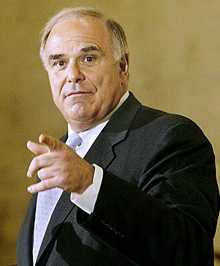
|
| Ed Rendell |
Those who didn't know him made the comment they could almost believe he was a victim of Attention Deficit Disorder. He talked all the time, moved all the time, and apparently showered all the time. That is, he was in and out of sight all night, but invariably reappeared with fresh shirts, clean shaves, and sharp creases. His aides confided he wasn't very good at "detail work", which is to say he conducted the whole affair on a primeval level of dominance, bluster, charm and implied threat. Don't bother me with facts. Mayor Street, on the other hand, would come in and mumble something incoherent, and then had to leave for an important engagement. Word came in that the school teachers felt they really had to pay a small health insurance deductible, and it wasn't so bad. Foo, no guts.
Somewhere along the line, the newspapers started to echo that deductibles had their merits. Foo, bunch of Communists. The black ministers were reported to feel that if their people all had to pay deductibles, why couldn't the transit workers. Bah, bunch of muddleheads. In the hubbub, someone asked what Andy Stern thought. The trial lawyers didn't have as much to say as they once did; SEPTA had reduced liability costs by $87 million through adamantly refusing to settle any case without going to court. Paper tigers. What about chiropractic benefits, we demand the inclusion of chiropractic benefits. No, said SEPTA, we aren't going to agree to any of that sort of thing. Well, what about twenty visits a year to chiropractors?
One by one, the other players deserted the SEPTA workers. The message from the other tribes in the confederation seemed to be, get what you can for SEPTA, but stop the strike by election day. The Governor produced the razzle-dazzle, a loan to the city to pre-pay the Blue Cross premium, in return for which Blue Cross would reduce the premium. The effect of that was to produce enough cash to appear to add ten cents an hour to the pay packet. We'll have to wait a year to see how this money gets restored to Blue Cross, but that's the general idea.
The strike was over, hurray. The next day, the Democrat party elected Democratic governors in New Jersey and Virginia, defeated some California amendments which would have hurt the trial lawyers and teachers unions. Surely, someone in the Democrat party nationally was telling himself that caving on the Philadelphia transit strike was a small price to pay for that.
Washington Square
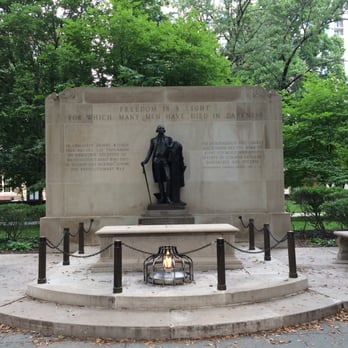
|
| Washington Square |
Although he spent a lot of time in Rittenhouse Square in Philadelphia, Henry James wrote about Washington Square in New York. It was Christopher Morley who wrote about Washington Square in Philadelphia. The best short essay about Philadelphia's Square is found in this link.
The subject of Washington Square includes an interesting variety of topics, including the Walnut Street Prison, famous balloon rides, the Athenaeum, Penn Mutual Life Insurance, Curtis Publishing Company, N. W. Ayer, Harry Batten, Lea and Febiger, Lippincott Publishing, Saunders, Orange Street, the St. James Apartment House, Richardson Dilworth, the Farm Journal the old PSFS building, and the Maxfield Parrish mosaic.
REFERENCES
| Philadelphia Washington Square: Images of America, Bill Double, ISBN-10: 0738565504 | Amazon |
What Happened in Philadelphia on July 4, 1776?
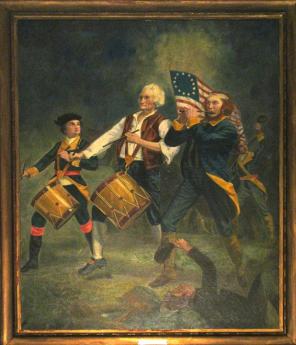
|
| Spirit of 76' |
The American colonies were growing too big, too fast, and the British Empire had too many international distractions, to have smooth relationships across three thousand miles of ocean, using uncertain communications available in the late Eighteenth century. Friction and misunderstanding were inevitable without far more statesmanship than either side thought was necessary. So, when the Continental Congress dispatched George Washington to Boston with troops to defend rebellious Massachusetts at Lexington, Concord, and Bunker Hill, it was hard for the British to believe the colonists were merely helping out one of their distressed neighbors. It seemed in London that the thirteen colonies had united, formed not only an army but a government, and gone to war. In December 1775 England passed the Prohibitory Act, essentially declaring war, and organized a huge invasion fleet to put down the rebellion. It now seems hard to understand the first notice the Americans had of this huge over-reaction was a private letter to Robert Morris from one of his agents in March 1776; no warnings, no negotiations, no attempt to investigate problems and correct them. The British just sent a fleet to settle this problem, whatever it was. It's all very well to say the Americans should have known they were playing with fire. They didn't see it that way; they were being self-reliant, responding to attack. In June 1776 British patrol frigates were skirmishing in the Delaware River; late in the month, British troops landed on Staten Island. The American reaction to all this was a muddle of confusion. A few were delighted, most of the rest were amazed or appalled.
Although the deeper strategic origins of the American Revolution are subtle, complex, and controversial, there is far less muddle about what happened on July 2, 1776, publicly proclaimed two days later. Adopting a resolution written by Richard Henry Lee of Virginia, the Thirteen Colonies stated they had now clarified their goals in the controversy with the British monarchy. For a year before that, the Continental Congress had been corresponding with each other and meeting in Carpenters Hall with the goal of achieving representation in the British parliament -- "No taxation without representation". The model for most of them was based on the Whig agitation for Ireland -- for a local parliament within a larger commonwealth. But the passing of the British Navy in Halifax, Nova Scotia, and then the actual appearance of seven hundred British warships in American waters showed that not only was Parliamentary representation out of the question, but King George III was going to play rough with upstarts. The new goal was no longer just representation, it was independence. If we were going to resist a military occupation at the risk of being hanged as traitors, we might as well do it for something substantial. The meeting had a number of Scotch-Irish Princeton graduates, whose basic loyalty to England had long been divided. Pacifist Pennsylvania, chief among the wavering hold-outs, was mostly won over by its own Benjamin Franklin, who was optimistic the French would help us. Even so, both Robert Morris and John Dickinson refused to sign the Declaration; Franklin persuaded both to abstain by absence, which created a majority of the Pennsylvania delegation in favor. That's a pretty slim majority for a crucial decision. Franklin was soon dispatched back to Paris to make an alliance; Washington was dispatched to hold off that British army in the meantime. Jefferson was designated to write a proclamation, which even after editing is still pretty unreadable beyond the first couple of sentences. Meeting adjourned. This brief account may not qualify as a serious examination of the causes of the American Revolution, but it comes close to the way it seemed to the colonist in the street.
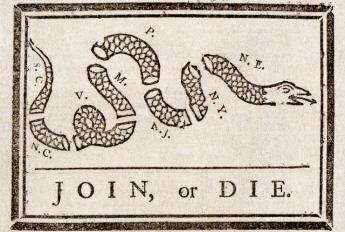
|
| Colonist's Complaint |
The rebels then spent eight years convincing the British they were serious and have been independent ever since. But, just a minute, here. Reflect on the fact that fighting had been going on for a year in Massachusetts, and that Lord Howe's fleet had set sail a month before the Declaration, actually landing on Staten Island at just about the same time as the Fourth of July. Add the fact that only John Hancock actually signed the document on July 4th, and some of the signers even waited until September. You can sort of see why John Adams never got over the idea that Thomas Jefferson had a big nerve implying the whole Revolution was his idea. What's more, there's a viewpoint that New England subsequently had to endure a President from Virginia for thirty-two of the first thirty-six years of the new nation because loud talk from New England still made the rest of the country nervous. Philadelphia may have been the cradle of Independence, but that was not because it was a colony hot for war, dragging others along with it. Rather, it was the largest city in the colonies, centrally located. It had a strong pacifist tradition, and it had the most to lose from a pillaging enemy war machine. When Independence was finally declared the goal, many of Philadelphia's leading citizens moved to Canada.
New England had started hostilities and was about to be subdued by overwhelming force. The Canadians were not going to come to their aid, because they were French, and Catholic, and enough said. What New England and the Scotch-Irish needed were WASP allies, stretching for two thousand miles to the South. By far the largest colony was Virginia, which included what is now Kentucky and West Virginia; it even had some legal claims for vastly larger territory. Virginia was incensed about its powerlessness against British mercantilism, especially the tobacco trade. The rest of the English colonies had plenty of assorted grievances against George III, and almost all of them could see that America was rapidly outgrowing dependency on the British homeland, without a sign that Parliament was ever going to surrender home rule to them. It was perhaps unfortunate New Englanders were so impulsive, but it looked as though a military confrontation with the Crown was inevitably coming. Without support, New England was likely to be torched, as Rome once subdued Carthage.
And the last hope for an alternative of flattery and diplomacy, for guile and subtlety, had stepped off the boat a year earlier. Benjamin Franklin, our fabulous man in London, arrived with the news he had finally had it "up to here" with the British ministry. He was a man who quietly made things happen, carefully selecting his arguments from amongst many he had in mind. In retrospect, we can see that he held the idea of Anglo-Saxon world domination as far back as the Albany Conference of 1745, and could even look forward to America outgrowing England in the 19th Century. His behavior at the Constitutional Convention of 1787 strongly suggests he never completely gave up that long-term dream. Just as Edmund Burke never gave up the idea of Reconciliation with the Colonies, Benjamin Franklin never quite gave up the idea of Reconciliation with England. While John Dickinson and Robert Morris resisted the idea of Independence down to the last moment, Franklin took a much longer view. For the time being, it was necessary to defeat the British, and for that, we needed the help of the French. In 1750, America joined with the British to toss out the French. And then in 1776, we joined the French to toss out the British. Franklin didn't always get his way. But Franklin was always steering the ship.
Fort Washington, PA
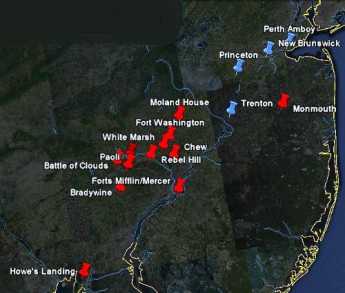
|
| British Campaigns |
The Revolutionary War lasted eight years, so there are a half dozen Fort Washingtons, in several states. Pennsylvania's Fort Washington gets free advertising from being a stop on the Pennsylvania Turnpike at the intersection of the East-West branch and the North-South branch, near some very large shopping malls. Nevertheless, the suburbs haven't reached it yet, and it is on a series of wooded mountain ridges discouraging housing development. Another way of describing its location is that it is several miles north of Chestnut Hill along the Bethlehem Pike, a road which begins in the center of Chestnut Hill at Germantown Avenue. The Pike is quite old, with many surviving colonial-era houses and inns to liven up the trip.
A third way to describe Fort Washington is that the headquarters were at the point where Bethlehem Pike crosses the Wissahickon Creek. How's that again? How does the western Wissahickon Creek then flow uphill to Chestnut Hill? Of course, it doesn't, but the appearance takes some explaining. The northwestern end of Philadelphia is reached by two ancient roads running on ridges quite close together like the split tail of a fish. Germantown Avenue runs up one ridge, and Ridge Avenue runs up the second ridge closer to the Schuylkill. The Wissahickon runs in the gully between these two ridges and tumbles down the hill at Wissahickon Avenue, or Rittenhousetown if that is more understandable. The ridge of Ridge Avenue is essentially cut off by the creek, but engineers have put Ridge Avenue on a high arching bridge as it crosses the creek far below, and by this magic Ridge Avenue and Germantown Avenue are at about the same height most of the way. The Wissahickon Creek is really running downhill the whole way, but sort of disappears from sight and reappears as it twists through the gorges, misleading the casual visitor (or commuter). As happened so often during the Revolutionary War, Washington showed his understanding here of geography in the service of guerrilla warfare.
Since the British were headquartered in Germantown, and the Americans have camped a few miles away on the same creek, it was inevitable there would be some sort of battle in the region. Washington launched a three-pronged attack on the British soon after arriving at Fort Washington, but his troops fired at each other in the fog, and apparently, two prongs more or less got lost in the gorges. The Americans retreated, and the British consolidated their conquest of Philadelphia. They did launch one surprise attack on the American encampment (the Battle of Whitemarsh), but that was mainly a reconnoiter, given up after a few days when it became clear Washington's troops held the high ground. It really is high ground (hawk-watching platforms and all) for reasons already stated. Chestnut Hill is a pinnacle sticking up on the west side of the Creek, with the Wissahickon snaking around its base.
This really was a perfect place for Washington to aim for after the Brandywine Battle, close enough to threaten the British, located in a bowl-like valley for camping, but terminating at the top of a mountain ridge in case the British counter-attacked. And with plenty of running water from the Wissahickon. However, it was a little too close for comfort, and he withdrew across the Schuylkill into Valley Forge as a more substantial natural fortress. Valley Forge is also on a hilltop, but one sitting in the middle of the Great Valley (Route 202 to Wilmington), as the center of an angel food cake tin. No doubt, the advantages of this new location became evident to him at the earlier skirmishes of the Battle of the Clouds, and the Paoli Massacre, which occurred nearby.
In retrospect, these maneuvers and skirmishes were of little military significance, except for the major Battle of Brandywine. The lost opportunity was the chance to catch the British Army without supplies or access to the Navy, aborted by what was probably a hurricane, the so-called Battle of the Clouds. Philadelphia was lost, and the opportunity to win the war early by smashing a third British army was gone for good. The defeat of the Hessians at Trenton, the loss of Burgoyne's army at Saratoga, and a victory on the outskirts of Philadelphia might together just have finished the War. But things didn't work out, the British similarly missed some opportunities, and the war was to last another five years. Once the French allied themselves, their wealth and naval strength tended to make French priorities dominate strategy.
Nevertheless, a perfectly splendid tourist trip awaits the history buff who travels from Elkton, Maryland, where the British landed, to the Battle of Brandywine battlefield, up the Great Valley to Immaculata University where the Battle of the Clouds took place, over to the Battlefield of the Paoli Massacre, crossing the Schuylkill and going to Whitemarsh, then to Fort Washington, and back up Bethlehem Pike to Germantown Avenue, and down to the Chew Mansion. The campaign for the conquest of Philadelphia ended with the fall of Ft. Mifflin when the British fleet was finally able to re-supply Howe's army. This direct auto tour is a little out of chronological sequence, but it can be done in one day if you don't dawdle. If you slow down and spend an extra day, you can include the Moland House where Washington waited to see where General Howe was going. At the right season, there's hawk watching on the ridge at Fort Washington Park, and maybe on to Trenton, or even up the New Jersey waist to Perth Amboy on lower New York Bay, where the Howe brothers began and ended their Philadelphia adventure. That would take you past Princeton and New Brunswick, or even include a trip to the Monmouth Battleground. With this extension, you have traveled much of the extent of the Revolutionary War in the Mid-Atlantic states.
Not a Single Red Knot
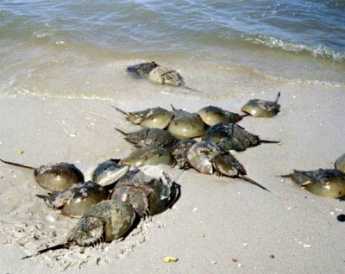
|
| Horseshoe Crabs |
A full moon brings high tide, which for centuries has brought vast numbers of horseshoe crabs to the banks of the Delaware River, toward the end of May. Marine biologists tell us these ugly-looking beasts have evolved very little for thousands of years.
Horseshoe crabs transport oxygen through their blood as a blue copper compound instead of that iron-containing hemoglobin the rest of us use. That's red, of course. Somewhere in the evolutionary path, these ancient animals also neglected to develop an immune system, but defend themselves against bacteria by precipitating sediment when they encounter endotoxin. By luck, this reaction takes place even though the bacteria are dead, so it is routinely employed as a way of detecting and eliminating endotoxin in intravenous fluids, which would otherwise go undetected by failing to grow the original bacteria in conventional culture media. Unfortunately, those of us who have never experienced a temperature spike to 106 degrees from an intravenous infusion of "sterile" water is more or less indifferent to the contribution of the Delaware crabs to our well-being. As well as being sadly indifferent to the unique nature of their nerve cells, in long single neurons, which make a number of important experiments possible.
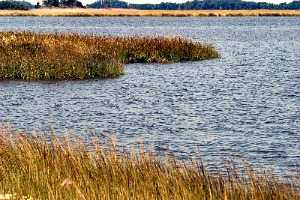
|
| Bombay Hook |
The horseshoe crab offers still other attractions. When they come ashore to lay eggs (at a full moon, or high tide, in May), they lay incredibly large quantities of them, attracting astonishing swarms of birds, which can be seen gliding a few feet above the water surface in groups of hundreds or even thousands. The Red Knot sandpiper is certainly not the only egg-eater at Bombay Hook, but there are some unique features of that bird to be mentioned in a minute. A lot of people object to being attacked by monster swarms of mosquitoes in the summer, but screens and air-conditioning have encouraged a large number of rather prosperous houses to be built along the shore, particularly where there are sandy beaches. In fact, it is so crowded the Fish and Wild Life Service has placed street lights at such public places, with a narrow driveway to lead you to the beach. If you don't know how to recognize such amenities, well, too bad for outsiders.
Although there are plenty of naturalists and bird-watchers who come in the early spring, most of the houses along "Slaughter Beach" seem to belong to fishermen and duck hunters, the two outdoor sports with most popularity. Different migrations of different food-producers bring different prey for the sportsmen, but somehow the most up-scale members of this fraternity tend to go there in May, looking for Red Knots. A Red Knot is a form of sandpiper, with a red head and breast. The birds are born in the Arctic tundra, eating vast amounts of mosquito eggs and larvae, migrating south in the fall. They winter over in Tierra del Fuego at the opposite end of the earth and then migrate north to Bombay Hook on Delaware. For these long migrations, they must eat voraciously when they do eat and somehow have learned to look for the horseshoe crab eggs at just the right time, presumably following cycles of the moon for timing. Residents of the area for centuries have remarked on the timing of the birds and the tides and the crabs. Unfortunately, the two-continent migration was only recognized fairly recently, and when the supply seemed endless, the crabs were scooped up and used for fertilizer until their supply began to dwindle; both Delaware and New Jersey now have protective legislation, and Virginia is being verbally excoriated by bird watchers, to do the same. The crabs have started to come back, but the Red Knots are slower to respond, and now the threat is Sushi. Another ecological damage has reduced the supply of crabs in the Pacific, so the crab fishermen have migrated to the Atlantic to catch the crabs as bait for conch and other ingredients of Sushi. Once again, the abundance of crabs has declined, although to a much smaller degree than the Red Knots. This year, on the very best day of the year for this sort of thing, with dozens of out-of-state license plates wandering aimlessly up and down thirty miles of shoreline, the shouted greetings among serious bird watchers returned the sad news, "No Red Knots today. Try the beach." It was generally agreed there was a bit too much wind for good Red Knot sighting, and that oil spills in the Gulf of Mexico were to be suspected, and that perhaps tomorrow would be a better day. But judging by the very expensive optical equipment these people were carrying around, these were serious birders, indeed. If they couldn't find Red Knots, the rest of us might as well give up.
The most plausible theory for the latest decline centers around the old-timer birds. When the first-timers start their northward migrations, they are guided by the old-timers who have made the trip at least once before. If something injures the flock, it may be a few years before the supply of old-timers revives enough to supply the first-timers with guides. That's just a theory, of course, but currently the most popular one. Just what it would take to eliminate the Red Knot migration completely, may now be close to being tested. Just on principle alone, it does seem a pity to eliminate a phenomenon which took thousands of years to develop.

|
| Benjamin Chew's Whitehall |
When you finally give up on Red Knots, you might as well wander around this enormous wildlife sanctuary. A few miles up the road is the former location of Whitehall, the plantation house of Benjamin Chew, lawyer for the family of William Penn, and owner of the stone fortress on Germantown Avenue in Philadelphia that thwarted George Washington's attempt to stall and starve the British before they could join up with their ships in the harbor below Fort Mifflin. The original buildings on the plantation have disappeared, but the spongy plantation trails have been replaced by elevated gravel roads. So it is possible to roll up the windows of your car in mosquito season, turn on the air conditioning, and cruise around the spectacularly beautiful ponds and inlets. Further south is the plantation of Caesar Rodney, who rode to Philadelphia in the rain to cast the deciding vote for the Declaration of Independence. And further south of that is the plantation of John Dickinson, who made Rodney's ride necessary by refusing to sign the Declaration, on the grounds that the colonies showed insufficient unity, in his eyes, to be able to win a war with England. And anyway, the argument was largely economic, hence more likely to be won by economic means than military ones.
To the west of these historic plantations are some pretty impressive farms, new style. The houses give them away since no farmer will spend a cent on his house if he can profitably expand his farm; these houses belong in glossy magazines. The silos are grouped in clusters of ten or twelve, the irrigation sprinklers are a quarter-mile long, attachable to what resembles a fire hydrant in the center of the field. There are over a hundred sheds on some farms, filled with chickens fattening up. And do you know what? You can drive for miles without seeing a single chicken.
Eventually, the road leads to the Dover Air Force Base, very large indeed. No planes are in evidence, as is true on most days. But one day in 1962 Mr. Kennedy was talking to Mr. Castro, and overhead at Dover you could see dozens, maybe hundreds, of eight-engine bombers. Just circling, circling, waiting for orders to go lay an egg on the Kremlin. It wasn't clear to onlookers at the time, just what this was all about. But the idea can now be entertained that perhaps Red Knots weren't the only species flirting with extinction.
Beaumarchais: A Playwright Brings France into the American Revolution
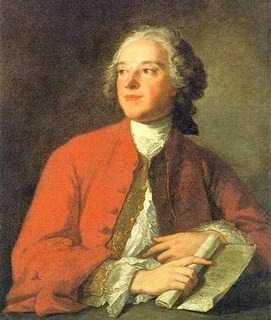
|
| Pierre Augustin Beaumarchais |
Pierre Augustin Beaumarchais, the son of an 18th Century French watchmaker, was born Protestant in a Catholic country. While possibly inclined by this circumstance to be a free thinker, his unusual artfulness was more likely inborn. After revolutionizing watchmaking before he reached the age of twenty, with an escapement mechanism for small portable watches, he rose to social attention when the Royal Watchmaker claimed the invention was his own, and Beaumarchais sued him. Thus gaining Louis XV's notice, Beaumarchais became Royal Watchmaker himself. He was soon giving harp lessons to the ladies of the court, writing plays like The Barber of Seville, and engaging in business schemes with wealthy investors. His career as a court favorite lasted sixteen years, first bringing him considerable wealth, but then sudden ruination by a lurid lawsuit which cost him his fortune. In brief, Beaumarchais had tried to bribe a French judge with less money than his opponent offered, and so spent a few months in prison. After concluding a long, public battle through the appeals courts, he sought a more political role with the new young King, Louis XVI. He was sent to London to pay off a former French Agent, Chevalier D'Eon, who was blackmailing the French government. D'Eon's social connection to John Wilkes, the outspoken critic of the British King, sparked Beaumarchais' initial interest in Whig politics and the American rebellion.
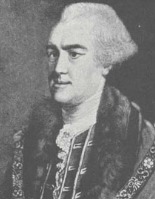
|
| John Wilkes |
When he arrived in England Beaumarchais found British politics in turmoil; John Wilkes headed a whiggish opposition movement denouncing Royal authority and hosting gatherings of the like-minded, some of which Beaumarchais attended. Fueling these domestic British flames of liberal reform was the recent and increasingly serious rebellion on the other side of the Atlantic. As Beaumarchais spent more time in England discussing the rebellion with Virginian Arthur Lee (who highly exaggerated its strength), he became increasingly convinced it would be a good strategy for France to help the colonists. For all the trouble Arthur Lee ended up causing, he can fairly claim credit for enlisting Beaumarchais to French support for the American cause.
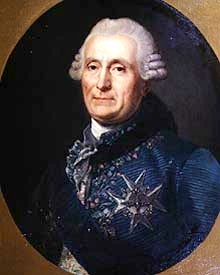
|
| Charles Gravier, Comte de Vergennes |
Beaumarchais reported his findings to Charles Gravier, Comte de Vergennes, the foreign minister of France. He urged the French government to support the American rebellion, consistently taking the line of French self-interest; after suffering a humiliating defeat in the Seven Year War, France might now undermine England's growing regional power by helping the colonists loosen their affiliation to the rising island empire.
When the young and hesitant Louis XVI finally agreed to take Beaumarchais' advice, it was still unclear whether the American rebellion was a serious movement. The French monarchy was not ready to unsettle its already shaky relationship with England by coming out in public support of untested rebels. To preserve the appearance of neutrality, the French Government loaned Beaumarchais one million lives in June 1776 to start a private trading firm, the Rodriguez Portales Company. This new firm would buy old French military supplies from the French government, then re-sell those supplies to the Americans with return payment of American products, primarily tobacco. Beaumarchais was therefore expected to run a completely self-sustaining operation, free from association with the French government. Rogue and adventurer that he was, Beaumarchais took on this risky challenge with enthusiasm, working tirelessly in France and around Europe to provide the Americans with ammunition, military supplies, and food. His efforts did not go undetected, however. England's ambassador to France, Lord Stormont, grew suspicious of Beaumarchais' frequent trips across the channel and notified the French government of his displeasure. But Beaumarchais simply ignored these protestations.
Matching Beaumarchais' work in establishing Rodrigez and Hortalez, the American Congress sent a covert representative to nurture French support. Silas Deane, sent to France under the disguise of a colonial merchant in July 1776, learned of Beaumarchais' plan to support the American army and at first, the two became fast friends. Unfortunately, this friendship sparked the jealousies of Colonists and Frenchmen alike. Arthur Lee became a particularly vicious opponent of the Beaumarchais/Deane pair, resenting Silas Deane for having been chosen over him as a diplomat to the French, and suspecting Beaumarchais of money laundering. Even when he was later sent in company with Benjamin Franklin to continue negotiations with France, Lee remained suspicious of Deane and Beaumarchais' collaboration. The American mission to France during this period remains famous for strife and factionalism, which was as much a free for all as two-sided animosity. Personal ambition and cultural differences complicated these relationships; no one eventually suffered more because of it than Beaumarchais and Deane.
While Deane negotiated with Beaumarchais, Arthur Lee corresponded with Congress to undermine both Beaumarchais and Silas Deane. Lee was highly suspicious of both men, accusing them of using the privateering scheme for their own profit. The result was a split in Congress between those who supported Lee and those who supported Deane's work with Beaumarchais. The first congress was full of alliances, tempers and faulty information that led to frequent, if not constant, conflict. The Lee brothers were particularly vocal opponents of an alliance with France, and this opposition by a prominent family within the Continental Congress kept French and American relations strained and hesitant.
The first shipment to the colonies by the Rodrigez and Hortalez Company carrying nearly 25,000 pounds of ammunition, was a shaky and often blind operation. Continental Congress never received news of Deane's plans (and request for ships) and remained busy working away at a proposed Declaration of Independence, the publication of which would, with luck, ensure France's official cooperation. Deane was forced to make crucial shipment decisions without the support or approval of Congress. Adding to this instability, the ships were discovered by Lord Stormont right before the first shipment left for the colonies, and the English Ambassador to France quickly protested their sailing to the French government. Vergennes, eager to keep smooth relations with England, particularly in view of the seeming failure of the American cause at that time, officially banned their sailing off the French coast. Fortunately for the Americans, Beaumarchais sent the supplies anyway, which were greeted warmly by colonists in Portsmouth, New Hampshire in early 1777. These supplies helped the colonists win the Battle of Saratoga, the success of which finally convinced the French to emerge in full support of the American Revolution. Beaumarchais continued to supply the Colonists despite England's protests, but privateering increased the threat of war between England and France.
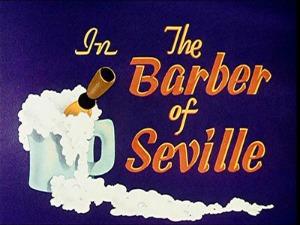
|
| Barber of Seville |
By September 1777, Beaumarchais had shipped 5 million lives worth of supplies to America without repayment. By 1778 his firm had accrued so much debt that by the end of the war it was in complete ruin. The French government was unwilling to acknowledge its support for Beaumarchais before or after the war, and Silas Deane's entreaties were, unfortunately, not enough to convince Congress that the American colonies owed Beaumarchais for his generous work. Beaumarchais continued his requests for compensation after the war, and Congress continually refused or ignored these requests. Thirty-six years after his death, his heirs were paid back a small fraction of the original debt. Forced to travel to Congress to fight their ancestor's case, his descendants were awarded 800,000 lives of the several million owed. In effect, Beaumarchais nearly single-handedly supplied the American Revolution with arms receiving very little in return except his financial ruin.
It is surprising that a man with so much talent and character should have died in near obscurity; yet Beaumarchais' plays, not his political maneuverings, are what have survived today as part of the standard repertory. When his wildly successful The Barber of Seville premiered in 1775, Beaumarchais was already a well-known playwright and champion of the down-trodden common man. Perhaps he was too great for his own time; The Barber proved more popular when adapted into a libretto by Lorenzo Da Ponte and then later into an opera by Gioachino Rossini in 1814. An independent mind and flamboyant character immortalized his art, but the same characteristics may have brought him, and France, to political and financial ruin.
Battle of Monmouth

|
| Battle of Monmouth |
A moving army tends to get strung out on roads through unfamiliar territory, and when boarding ships leaves a steadily diminishing rear guard to protect the fleet. Thus, General Clinton's retreating British army presented an opportunity for Washington to harass them, take advantage of unexpected delays, and to be wherever they were going. So Washington ordered the Continental Army out of Valley Forge, to pursue the retreating British as they moved over the Delaware River to Camden, joining the King's Highway at Haddonfield, heading for Sandy Hook and the waiting ships of the British Navy. As both armies approached Monmouth Court House, Washington caught up with Clinton and ordered his deputy, General Charles Lee, to attack with an advance force that would hold the British in place until Washington's main force could catch up. Both armies had about 13,000 soldiers in strength, but only 9,000 of Clinton's men were engaged because of their strung-out deployment.
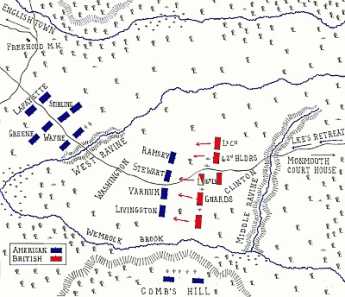
|
| Battle of Monmouth Map |
Washington's battle plan was therefore vindicated, and the next showed his characteristic ability to use terrain to his advantage. The New Jersey countryside breaks up into hills as it approaches New York harbor, and its valleys between hills tend to contain creeks at the bottom. Therefore, the retreating British were forced into narrowing valleys which exposed them to flanking maneuvers but reduced the room for Washington to be outflanked. Lee failed to take such effective advantage of the terrain and made only half-hearted attacks on the British. When Washington and the main body of troops caught up with him, Lee was promptly relieved of command and later court-marshaled. In his place, Washington sent Nathaniel Greene around the enemy's southern flank, setting up four artillery pieces on a high hill, protected from British attack by a flooded creek. He was thus able to "enfilade" the British line, aiming cannonballs at the near end where they would bounce up the British line if they fell short, or land in the far end of the British line when they overshot. The cannons now look fairly small and puny, but with a well-trained crew of a dozen artillerymen, each one could get off five to ten shots a minute. With four pieces of artillery, they could drop twenty to forty shots a minute onto the confused and compressed formation of enemy troops. The battle went on all day, the longest battle of the Revolution.
Under the cover of darkness, Clinton withdrew his troops toward Sandy Hook, leaving six hundred casualties on the ground, two-thirds of the British. The British could claim they achieved their objective of reaching the ships, but with greater casualties, and forced to withdraw in the face of discovering a much better-disciplined American army than they had ever faced. They acquired a new respect for Washington, who demonstrated boldness and outstanding tactics, with professionalism quite equal to their own.
REFERENCES
| New Jersey in the American Revolution: Barbara J. Mitnick: ISBN-13: 978-0813540955 | Amazon |
State in Schuylkill Fishing Club
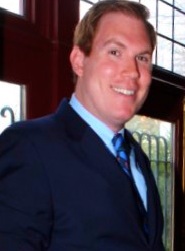
|
| Richard Romm |
Richard Romm, a rising historical scholar with a special interest in early Philadelphia, recently educated the Right Angle Club in the history of the Schuylkill Fishing Club in the State in Schuylkill, and was immediately accepted into membership. Of the Right Angle, that is, which is an old club by some standards, but scarcely a hundred years old in the eyes of the really old, old clubs.
The State in Schuylkill is an eating club, originally a fishing and eating club, apparently organized around the annual shad run up the river. The clubhouse, or Castle, was moved several times, in response to damming of the river, and is now located on the grounds of, or adjoining the edge of, Nicholas Biddle's estate on the Delaware River called Andalusia. One by one, the Atlantic Ocean rivers of America have been dammed and their annual shad migrations brought to an end, except through the city of Richmond, Va, so there was little point in moving The Castle to follow the fish. It remains, overlooking Delaware in spite of its name.
There seems to have been several name changes, the most important of which was to change the Colony of Schuylkill to the State of Schuylkill for obvious reasons. Originally, the Castle was roughly opposite the falls of Fairmount on the West Bank of the Schuylkill at about Girard Avenue; thus, from 1732 to 1822 located on Baron Warner's property called Eaglesfield. In 1822 it moved to Rambo's Rock (the Rambo family is said to be the oldest European settler family in Pennsylvania) opposite Bartram's Gardens, then finally in 1887 to Andalusia, Nicholas Biddle's country estate. The club was founded in 1732, and dates of movings are possibly hazy, possibly somewhat because of the reluctance of club officers to return the calls of inquiring historians. The State in Schuylkill claims to be the oldest organized men's club in the world, an honor contested by White's in London. The roots of this argument are found tangled in the vital issue of whether their age should be based on the formal organization of the clubs, or on the establishment of the coffee houses which housed the original clubs. Four books are said to have been written about club history, but we depend here on Mr. Romm.
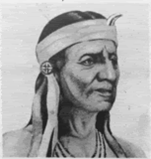
|
| Chief Tammenend |
There is also an unclear relationship with Chief Tammenend, possibly traceable to the shad run, but in any event to the Indian chief depicted with William Penn in the paintings by Benjamin West and Edward Hicks. May 1 is St. Tammany's day, growing into the fancy that he was the "Patron Saint of America", before a branch of the nation-wide Tammany association opened in New York and sort of tarnished up the name. Other traditions of the Fishing club have to do with wearing Mandarin hats, possibly having to do with the export of ginseng which was once abundant in our colonial suburbs, with a return cargo of Chinese dishware. All of the cooking is done by official citizens of the club. The quantities of food are remarkable; one 19th Century menu listed eleven pounds of meat per member. The club drink is a punch, the famous Fishhouse Punch, widely recognized to be rather strong. Its inventor is reputed to be Edward Shippen Willing, on the occasion of the first visit to the clubhouse by women guests. The quantity of alcoholic beverage at these events is especially remarkable in view of the Quaker origins of many original members of the club, but not necessarily of the guests. Among the various guests were Generals Grant, Meade, and McClellan. Dinner begins with two traditional toasts: to George Washington, and to Captain Sam Morris. Washington was appropriate enough, having a history of drinking a bottle of Madeira every day at lunch. But Sam? Captain Sam the Quaker?
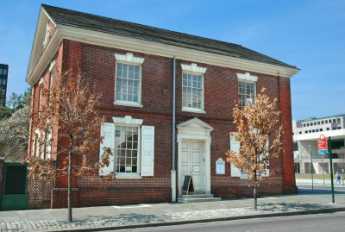
|
| Free Quaker Meetinghouse, Fifth and Arch Streets |
Somewhere in this tradition are allusions to the Free Quakers, Quakers who abandoned the peace testimony to fight the British. There is also the tradition of hostility to British rule which antedates the Revolution and may have some connection to the fanciful contention that their little state was not really part of Penn's colony. Captain (of the City Troop) Sam was a stalwart, possibly the sole founder, of the Gloucester (N.J.) Fox-hunting club. The history is passed down that 22 of the original 26 members of the First City Troop were members of the fox-hunting club, and many if not most were Quakers. The first "Governor" of the State in Schuylkill was Thomas Stretch, but the second Governor, from 1766 until his death, was Captain Sam. He was repeatedly referred to as the life of the club and held in the highest esteem by all. He was "read out" of the main Quaker Meeting, not so much for his drinking as for his flouting of Quaker belief in pacifism. He reputedly led a saber charge at the Battle of Trenton and was a leader of the City Troop in that revolution within a revolution at James Wilson's house, which rescued at least four future signers of the Constitution from a mob of militia which momentarily turned Jacobin.
Naturally, descendants of Quakers on both side of this uproar have been reluctant to say much about it. But somewhere within the history of Samuel Morris must be some important clues about the 18th Century splits within the Quaker Church, to say nothing of the revolt of the three Quaker colonies against British rule.
Espionage in the Revolution
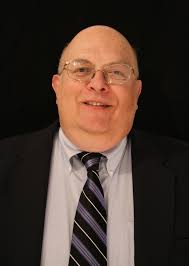
|
| John Nagy |
Both sides fighting the Revolutionary War predominantly spoke English as a native language, so it seemed deceptively simple to pick up a little cash for a tidbit of information or two. John Nagy, who has written several books on spies in the Revolution, recently addressed the Right Angle Club about this interesting topic. According to him, Quakers were favorites as spies because they were widely split in their sympathies, and as pacifists were abundant in the civilian societies of the time. Others have commented that the main difference between Conservatives and Free Quakers was that the Free Quakers were mostly of the artisan class and sympathetic to the Revolution, while the Conservatives were mainly of the merchant class, and Tories. But there were many exceptions, and the plain dress Quakers were hard to tell apart and passed freely through the military lines. No doubt many readers will be incensed by such comments, for which we take absolutely no responsibility.
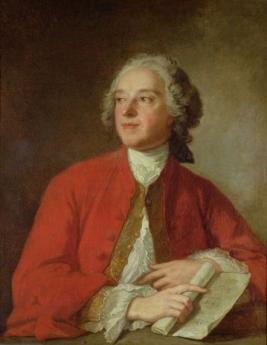
|
| Beaumarchais |
The one main exception to the English-language generalization were the French, who were still smarting from their defeat in the Seven-Years (French and Indian) War. The playwright Beaumarchais was quite active in the French movement to make trouble for the hated English and seems to have stirred up King Louis XVI to be interested in financing rebel trouble-makers, if not to become active combatants. In any event, a wary King thought it was best to send a spy to look over the situation. As detailed in a little pamphlet called The Spy in Carpenter's Hall the Americans were tipped off about the plot. Accordingly, the spy named Bonvoloir was hidden up on the second floor of Carpenter's Hall, while the colonists put on a belligerent falsified performance on the first floor. It is claimed their performance was a convincing one, having the desired effect of creating a report to the King that the colonists were belligerent, warlike, numerous and united. After the Battles of Trenton and Saratoga, the timing was good for using this sort of report to provoke the King into doing what he was mostly of a mind to do, anyway.
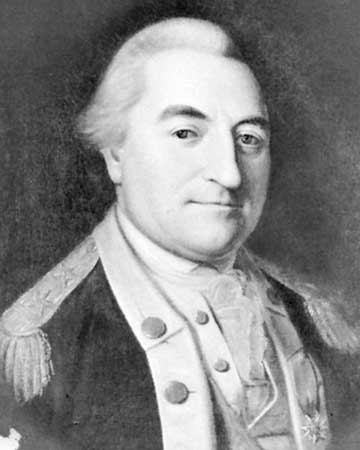
|
| Johann de Kalb |
The French were unusual in favoring aristocrats as spies and Johann de Kalb was anther who snooped around, returning later in the form of General de Kalb of military note. The names of British spies, aside from Major Andre, tended to have a Quaker sound to them, like Dunwoody, Cadwalader Jones and the like. It would take deep research to know whether these were Quaker stalwarts or merely black sheep of some family; there is little doubt that sympathies changed with the changing fortunes of battle. Another feature was the careless lying which took place for propaganda purposes. The famous story of Lydia Darragh, a Quaker who allegedly overheard the British officers plotting the surprise attack on Whitemarsh on December 5, 1777, and walked many miles in the snow to warn Washington -- is apparently a much dressed-up version of what happened. The whole Darragh family was engaged in regular spying, and the evidence is that Lydia's brother William was the one who was the messenger. He apparently carried messages under the cloth covering of the buttons on his coat.
.jpg)
|
| Joseph Galloway |
Two types of spying have a greater ring of authenticity. The British needed pilots to guide their ships up the Delaware past fortifications and obstacles. Maps were nice, but it seemed simpler to enlist the efforts of two ladies of easy virtue, Ms. O'Brien and Ms. McCoy, to hang out in taverns and entice local ship pilots to enlist to guide the British ships into Philadelphia. The British spymasters even had the ingenuity to entice a member of the Continental Congress, Joseph Galloway, to turn over the commentary records from which troop strength could be estimated from the food consumed. It is not recorded whether suitable adjustments were made for starving troops, stolen supplies, or fraudulent charges, however.
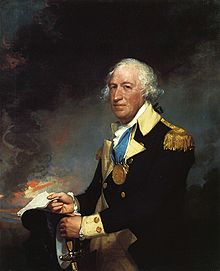
|
| Benedict Arnold |
Two prominent officials were accused of selling out the side, but an accusation of this sort is easily made, hard to prove. When the examples of Benedict Arnold and Peggy Chew can be verified, however, there is always doubt cast on everyone which some will believe. The system of double signatures was used, so there were two co-treasurers of the United States, Joseph Hellegas and George Clymer. Letters have been produced indicating that one or the other sold the commissary records. Hellegas' home is still today the residence outside Pottstown of a prominent Philadelphia surgeon, and his portrait appears on the ten-dollar bill. In so doing, he started a tradition of Secretaries of the Treasury on the ten-dollar bill, presently occupied by Alexander Hamilton. George Clymer, for his part, was a signer of the Constitution and a favorite of George Washington. Are these stories true? Who knows, but in an eight-year war, John Nagy has accumulated evidence that there were over five hundred documented spies. The essential question remains one of whether to believe the documents.
U.S. Army Corps of Engineers in the Delaware Valley
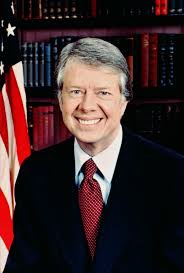
|
It seems unlikely a peanut farmer from Georgia would have much interest in Philadelphia, let alone the activities of its local Army Corps of Engineers. But it seems there is some sort of story, there. An acquaintance chairing a local meeting of Americans for Democratic Action at the time remembers an episode dating from the 1976 presidential nominating campaign. Morris Udall was the main opponent of Jimmy Carter for the Democrat nomination. You might suppose an out of town politician would have instincts tell him to be nice to the local mayor of his own party, but Jimmy Carter went out of his way to attack Frank Rizzo. Udall took the path of conventional wisdom and refrained from joining Carter in the attack. Since Pennsylvania votes were considered pivotal in that particular race, it was watched with considerable interest. But to the surprise of the insiders, Carter won the Pennsylvania votes, suggesting that hidden animosity to Rizzo was extensive. Furthermore, from that event, it would be possible to suppose either of two conclusions. Either Carter would be grateful to Pennsylvania for putting his nomination over the top, or else he had some sort of grievance against Rizzo.
Subsequent events suggest he had a grievance, but it would be very hard to imagine where the two would even have met each other in the past. More likely, he made some slighting remark to an aide, who took it on himself to curry favor when in fact Carter had forgotten all about it.
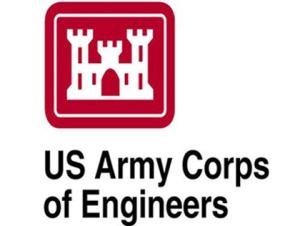
|
| U.S. Army Corps of Engineers |
In any event, the local division of the Army Corps of Engineers went into some sort of decline, dating from about that time, which might well have been over-reacting to the so-called Love Canal episode. The chief of the division was to have no higher rank than Lt. Colonel. The activities of the division had been centered on building dams and flood control projects but began to be mostly environmental protection, particularly repair of hurricane-damaged ocean beaches. The headquarters was moved from the Custom House to the Wanamaker Building because the personnel and budget had declined. There was the talk of merging the district with another district. The Delaware Division is the smallest district in the country, almost difficult to find on a map whereas some other districts enclose eight states. When you get more states you get more Senators, so you get more budget, and so on. It was sad that the Navy and Marines were founded here, the Revolution and the War of 1812 caused many fortifications to be centered here, the capital of the country. From that point to the present, there has been a long decline. It was particularly painful that West Point is primarily an engineering college, with a tradition that the top five percent of every class is offered a place in the Corps of Engineers. In Army politics, it is clear that a heavy proportion of the generals were West Point graduates, just as it is almost exclusively true that all admirals have Annapolis in their background. Jimmy Carter went to Annapolis, but so what?
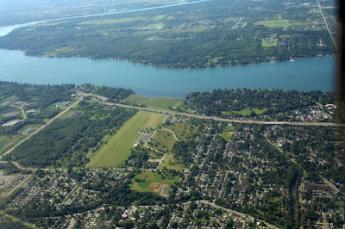
|
| Love Canal |
Rather than follow a line of thought which leaves many uncomfortable, perhaps it is more relevant to notice that all of our rivers seem to be drying up. Colorado and the Rio Grande are mere trickles, the Mississippi now has wide banks of mud. Delaware has long been recognized as having a wide mouth and a short length, reflecting its origin as a small river emptying (at Trenton) into a wide bay which is really the back bay of the huge barrier peninsula of Southern New Jersey. What might have been its extensive watershed runs instead into the Susquehanna, about a hundred miles north of Philadelphia, probably because of volcanic shifts? But what was once a thriving port has dwindled as a result of labor troubles and some unfortunate legislation. That's where the number of Senators in your district makes a difference.
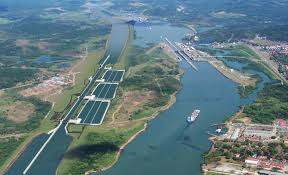
|
| Panama Canal |
Wilmington, Delaware has the largest port for bananas in the nation; Delaware points southward, toward all of Latin America. The Chinese are financing, and probably engineering, a widening of the Panama Canal to accommodate giant container ships that now can't get through. The first port on the Atlantic seaboard to deepen its harbor accordingly, will probably get first-mover advantage and hold it because it is expensive to play catch up. Philadelphia is about half-finished in the deepening of the channel to forty-five feet. But New York's deepening of the Hudson is almost complete. New Jersey politics involves both channels on its north and south borders, but New Jersey has long since thrown in its lot with New York. Now that it probably won't matter, the Pennsylvania dredging will probably be permitted to finish. If that happens, the only hope for Philadelphia in the race to be a big container port will depend on a recession in China slowing down their import traffic until we catch up. After all, Philadelphia is blessed with an almost world-unique combination of rail, highway, airport, and ocean shipping interchanges at a single point, on relatively undeveloped land close to a major city. Without wishing any evil on China, we do have to wish they would encounter some reason to slow down for us. Slow down, that is until our natural advantages can overcome the foibles of our politicians.
Army War College in Carlisle
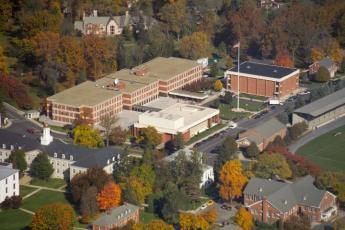
|
| U.S. Army War College |
Our program chairman, Carter Broach, once attended the Army War College, so he was in a position to invite Colonel Tom O'Steen to the Right Angle Club to tell us what the College was all about. Although there may have been times in the past when the Army welcomed secrecy surrounding its College, in recent years it has become concerned that the military may be isolating itself too much from the people it serves and defends. So Col. O'Steen was told he was welcome to talk to us. In fact, giving one speech to the public is a requirement for graduation. The history goes back to 1757, includes Ben Franklin, and also includes some interesting anecdotes which might not have been expected of a War College.
Like all land in Pennsylvania, this plot within what is now the town of Carlisle, PA, once belonged to William Penn. Nobody else owned it until 1757 when Ben Franklin was sent to negotiate its transfer from the Indians. William Penn had been careful to buy land from the Indians, even though he also formally owned it as part of a deed from Charles II of England. Other land proprietors had not been so scrupulous, often complaining of the Indian massacres which resulted, although seldom adopting Penn's rather inexpensive method of avoidance.
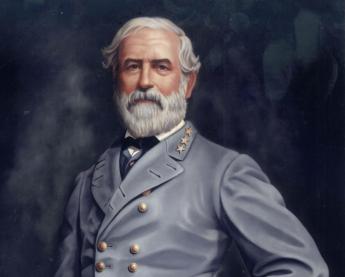
|
| Robert E. Lee |
During the Revolutionary War, Carlisle was a comfortable distance from the British Navy, and served as a backwoods artillery arsenal along the Appalachian Mountains, much as the Ho Chi Minh Trail served our enemy in the Vietnam conflict, along with an Asian mountain range. From 1790 to 1860, Carlisle served as a cavalry post, and then General Robert E. Lee invaded Pennsylvania up one side of a mountain ridge, with General Meade bringing up the Union forces from Washington DC on the other side of the ridge. The two valleys come together at Carlisle, so that spot had long been recognized as commanding both. Lee only got as far as Gettysburg before Meade caught up with him, but General Ewell's Corps took Carlisle as an advance guard. Confederate cavalry General JEB Stuart took Carlisle without sustaining a fight. Meanwhile, General Lee was fretting that Stuart was supposed to be his eyes and ears, keeping him informed of Union opposition, and it is possible that Stuart's Carlisle diversion thus had some influence on the outcome of the Battle of Gettysburg.
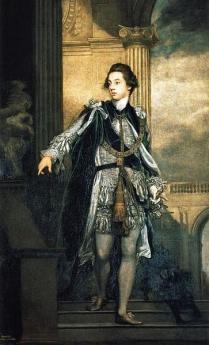
|
| Earl of Carlisle |
By 1879 there remained little purpose in a Carlisle military post, so it was turned into an Indian Industrial School, a couple of miles East of Dickinson College. After the Civil War, the nation lost its taste for exterminating Indians and turned to the idea of removing Indian boys from their families in order to assimilate them to white customs. Unfortunately, this did not work very well, and in fact, nothing worked very well. There are over 340 Indian languages from Eskimo to Aztec, but there is no record of any tribe allowing itself to be assimilated. The Spanish tried slavery, the French tried intermarriage, and the Americans tried persuasion and reasonableness. Eventually, we gave up and isolated them on reservations, but not before a wide-spread attempt was made to isolate Indian boys in boarding schools, hoping to remove them from tribal influences. That didn't work, either, but it was being attempted at Carlisle in the late 19th century. Interestingly, Carlisle is named after the family of the Earl of Carlisle, who was sent by Lord North after the disastrous British defeat at Saratoga, in order to see if the colonists might still be interested in Taxation with Representation. We weren't, so the Revolutionary War dragged on for another six years. Somehow, when war fever captures countries, small victories seems to close minds to what they had been originally fighting over. If the War College has time for another lesson, I suggest they add that one to their curriculum.
Before going back to the origins of the Army War College, we should salute the momentous football game of 1912, between the West Point cadets who included Dwight Eisenhower, and the Carlisle Indian School team which included Jim Thorpe. Thorpe was a member of an Oklahoma Indian tribe, but in many ways has been regarded as the best all-around American athlete in history. Eisenhower was pretty good, too, but Carlisle won the game.
 To raise and support Armies, but no Appropriation of Money to that Use shall be for a longer Term than two Years; To provide and maintain a Navy; 
|
| Constitution, Article 1, section 8 |
Several members of the Right Angle audience expressed the view that the Armed Services have more to fear from know-it-all university professors who feel they monopolize the field of strategic thinking than from Congress, which tends to have a goodly number of combat veterans in its ranks. It's all very well to repeat the mantra that the armed forces must respect civilian control, and then it's also just as well to remember that most coups are military coups in other countries. But whatever the future brings, these young Lt. Colonels will be the ones we must count on when the going gets really tough.
Honoring the Fallen
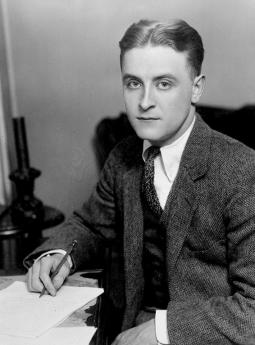
|
| F. Scott Fitzgerald |
The roarin' Twenties, just after the First World War, were a time when we seemed to change conventional attitudes about Society. But in many ways, the convulsive changes of the Twenties were merely a process of facing up to what we already knew. In retrospect, many of the deeply emotional conflicts of that time, now seem entirely bearable. Scott Fitzgerald's most ponderous statement, the one that says "The test of a first-rate intelligence is the ability to hold two opposing ideas in mind at the same time and still retain the ability to function," reduces itself to the trivial agonies of loving two girls at a time, or choosing to stop smoking when you always knew you shouldn't start. Just about the only instance, I can think of, where two deeply loved Philadelphia institutions are in seriously troubling conflict, are the First City Troop, and Quakerism. The matter came to mind at the Right Angle Club, when a Philadelphia Trooper who simply radiated the honorable dedications of upper-class Philadelphia gentlemen, meekly described his dedication to restoring the crumbling monuments of bravely fallen comrades. The monuments he finds and restores at great personal expense are not merely warring heroes, although one suspects that is the root of it. The gravestones and monuments crumbling in the dust are markers of heroes of our civilization generally. But we do forget what we owe them and neglect their monuments.
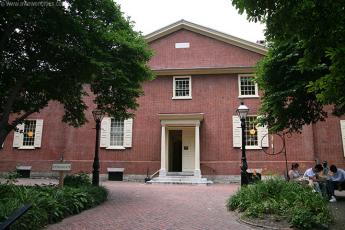
|
| Fourth Street Meetinghouse |
Although the dominant Quakers of Philadelphia's early days are now reduced to a handful of practicing believers, almost every educated Philadelphian knows those beliefs pretty well. The early Friends did not even sympathize with carving their names on their tombstones. If you visit the Fourth Street Meetinghouse, you will be told that forty thousand bodies have been buried on the grounds, but only two graves have tombstones. The worship of grave markers, you will softly be told, is idolatry. The goal of a funeral should not be to mourn death but to celebrate a life well-lived. And although the custom of gravestones has reasserted itself, it does not take long to be gently reminded that keeping alive the memories of one war's atrocities, can eventually lead to more wars. We recently have seen wars in Bosnia and Kosovo being fought over Thirteenth Century grievances which might better be forgotten. Some of this comes from immigration over three thousand miles of ocean, but the effect is the same. I have no idea even what nationality my own 13th Century ancestors might have fought for, and I doubt if the world would be improved if I found out and sought to wreak vengeance for the inevitable atrocities.
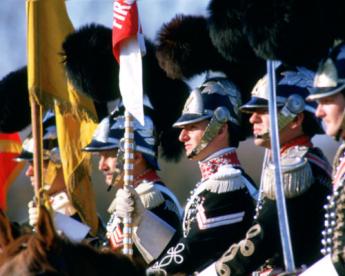
|
| Philadelphia First City Troop |
But unless one is determined to denounce anything at all admirable about everything our society does to defend itself -- and there are some who go that far -- it is necessary to make a sad concession to force in successful governance. The 18th Century Quakers perhaps seldom acknowledged the need for occasional force as a condition for leadership, but they watched their children drift away from the religion, once they absorbed the lesson. Even those who choose conscientious objection for themselves must occasionally acknowledge the debt they owe to those who do answer the call of force and knowingly fail to survive it.
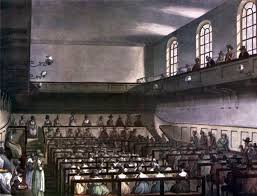
|
| Society of Friends |
There simply is no choice but to honor both sides of this issue, both permanently and side by side. There are some who can't, and in various ways fail to retain the ability to function. As in many of his more juvenile pronouncements, Fitzgerald does go much too far with assessing all the rest of Philadelphia as having less than first-rate intelligence. Philadelphians generally have at least a taste of the experience of holding these two opposing ideas-- the City Troop and the Society of Friends -- in mind at the same time, with approval for both. And generally seeming somewhat improved for having made the struggle.
52 Blogs
City Troop
 America.
America.
Mrs. Meade's House
 The grateful city fathers wanted to give General Meade a mansion out of gratitude for winning at Gettysburg. The General refused, but he hadn't asked his wife.
The grateful city fathers wanted to give General Meade a mansion out of gratitude for winning at Gettysburg. The General refused, but he hadn't asked his wife.
Tales of the Troop
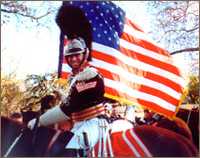 Dennis Boylan is collecting stories from the archives of Philadelphia's First City Troop. Someday, it should result in a great book.
Dennis Boylan is collecting stories from the archives of Philadelphia's First City Troop. Someday, it should result in a great book.
The Quaker Who Would Be King
Two Americans, Josiah Harlan, and George Bush conquered Afghanistan, and for centuries others who tried it got massacred. Harlan, a Chester County Quaker farm boy with more brazenness than Alexander the Great, died in San Francisco while impersonating a physician.
Killer Instinct
A former Marine and carrier pilot reflects  on the non-boastful risk-takers who drive themselves toward success, but not for riches, promotions, or power. Many other nations seem to exclude these people, and while many women go wild over them, feminists want to civilize them, at our peril.
on the non-boastful risk-takers who drive themselves toward success, but not for riches, promotions, or power. Many other nations seem to exclude these people, and while many women go wild over them, feminists want to civilize them, at our peril.
Battle of the Clouds: September, Remember
 Benjamin Franklin, it should be noted, was the first to observe that Atlantic Coast "Nor'easters" actually begin in the South and work North, even though the wind seems to be blowing the other way.
Benjamin Franklin, it should be noted, was the first to observe that Atlantic Coast "Nor'easters" actually begin in the South and work North, even though the wind seems to be blowing the other way.
Battleship New Jersey: Home is the Sailor
 The battleship New Jersey, mightiest dreadnought in our history, now rests in Camden. At one time, it could have blown up Valley Forge without moving from that position.
The battleship New Jersey, mightiest dreadnought in our history, now rests in Camden. At one time, it could have blown up Valley Forge without moving from that position.
Bergdoll the Rich Draft Dodger

Brandywine Museum
 The Wyeths, one of the great artistic families of America, display their work in the Brandywine Museum, which is itself a work of art.
The Wyeths, one of the great artistic families of America, display their work in the Brandywine Museum, which is itself a work of art.
Canaris and Lahousen
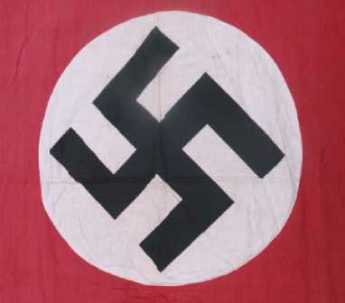 Comparatively few people are aware that the top command layers of the German Intelligence Service (Abwehr) were outraged by Hitler's behavior, and worked actively to undermine the Nazi effort.
Comparatively few people are aware that the top command layers of the German Intelligence Service (Abwehr) were outraged by Hitler's behavior, and worked actively to undermine the Nazi effort.
Field Marshal William Joseph Slim, 1st Viscount, Order of the Garter
 the rises of Bill Slim from humble beginnings to the highest honors Great Britain can bestow, may seem natural enough to Americans but raises reflections about the origins of British world rule.
the rises of Bill Slim from humble beginnings to the highest honors Great Britain can bestow, may seem natural enough to Americans but raises reflections about the origins of British world rule.
Frank Furness,(3) Rush's Lancer
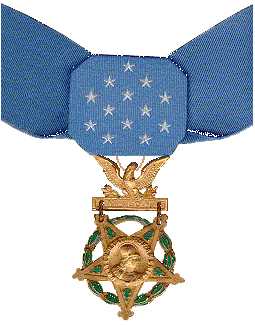 One of Philadelphia's most famous architects had two notable exploits as a Civil War cavalry officer, one of which won him the Congressional Medal of Honor.
One of Philadelphia's most famous architects had two notable exploits as a Civil War cavalry officer, one of which won him the Congressional Medal of Honor.
Franklin Bets His Wad on General Braddock
 Braddock came to rescue Fort Duquesne with soldiers but no horses or wagons, and the pacifist Quaker government couldn't or wouldn't raise money. So, Franklin, the loyal British subject gave his personal pledge to farmers for their wagons and would have been a pauper if the British government hadn't bailed him out.
Braddock came to rescue Fort Duquesne with soldiers but no horses or wagons, and the pacifist Quaker government couldn't or wouldn't raise money. So, Franklin, the loyal British subject gave his personal pledge to farmers for their wagons and would have been a pauper if the British government hadn't bailed him out.
Franklin: Upstart Hero of King George's War (1747)
 'King George's War' was two wars prior to the Revolution. Ben Franklin raised an army when the Quaker proprietors' wouldn't. The experience maybe gave him ideas.
'King George's War' was two wars prior to the Revolution. Ben Franklin raised an army when the Quaker proprietors' wouldn't. The experience maybe gave him ideas.
George Washington's View of the British Army
 Washington's escape from Braddock's defeat may help us understand his future low opinion of the British Army, and possibly suggests a reason for his hating them.
Washington's escape from Braddock's defeat may help us understand his future low opinion of the British Army, and possibly suggests a reason for his hating them.
Gettysburg
 The strategy of both sides in the Battle of Gettysburg was shaped by the type of weapons in use.
The strategy of both sides in the Battle of Gettysburg was shaped by the type of weapons in use.
Home of the U.S. Naval Academy
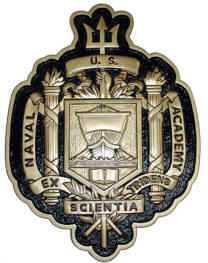 The Naval Acadamy now in Annapolis originally was on Gray's Ferry Avenue. It's still a handsome building, in some danger of destruction by real estate developers.
The Naval Acadamy now in Annapolis originally was on Gray's Ferry Avenue. It's still a handsome building, in some danger of destruction by real estate developers.
John Dickinson, Quaker Hamlet
 John Dickinson was the most respected lawyer and politician of his time. He had a lot to do with writing the Declaration of Independence but refused to sign it.
John Dickinson was the most respected lawyer and politician of his time. He had a lot to do with writing the Declaration of Independence but refused to sign it.
Laurel Hill
 Public attitudes about cemeteries continue to evolve.
Public attitudes about cemeteries continue to evolve.
Lewis Harlow van Dusen, Jr. (1910-2004)
 rode together on the Metroliner down to Washington, stayed at a club there, and after the hearing took the train back to Philadelphia.
rode together on the Metroliner down to Washington, stayed at a club there, and after the hearing took the train back to Philadelphia.
Madame Butterfly (2)
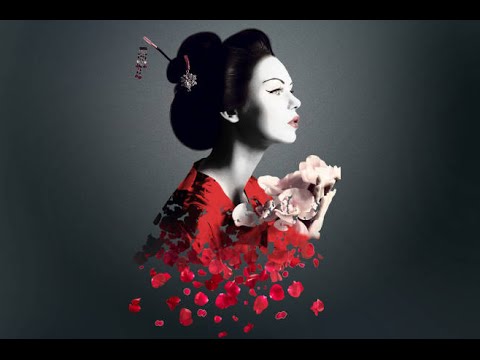 It is Puccini's genius to take this story of two nasty Americans destroying an honorable Japanese girl, and using the same story with the same words, make it into a romantic woman destroyed by a hopeless, helpless love affair. /br>
It is Puccini's genius to take this story of two nasty Americans destroying an honorable Japanese girl, and using the same story with the same words, make it into a romantic woman destroyed by a hopeless, helpless love affair. /br>
Military School
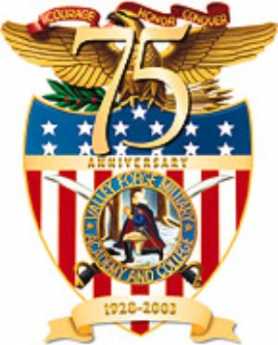 Valley Forge Military Academy takes rambunctious boys and makes them into leaders. Even some of the misfits and dropouts seem to benefit from the difficult experience.
Valley Forge Military Academy takes rambunctious boys and makes them into leaders. Even some of the misfits and dropouts seem to benefit from the difficult experience.
Philadelphia in 1976: Legionaire's Disease
 Philadelphia's ambitious Bicentennial celebration of the Declaration of Independence was ruined by an epidemic of a new disease that seemed to focus on tourists.
Philadelphia's ambitious Bicentennial celebration of the Declaration of Independence was ruined by an epidemic of a new disease that seemed to focus on tourists.
Politics of the French and Indian War

Principles of the Command of War
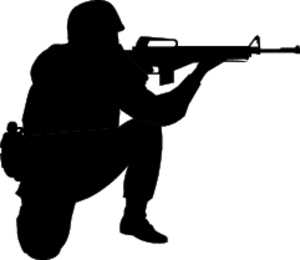 A soldier must know how to shoot a gun, but a general must know how to use an army.
A soldier must know how to shoot a gun, but a general must know how to use an army.
Quakers Turn Their Backs on Power
During the French and Indian War, the Quakers who ruled Pennsylvania were forced to choose between political power and peaceful principles. They withdrew from power.
Robert Adams, Jr.
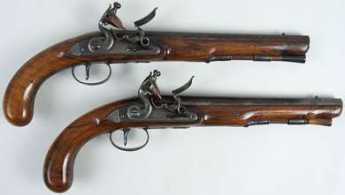 Robert Adams Jr fought what is thought to be the last duel in Philadelphia. His opponent was the dashing eccentric J. William White M.D., who is much better known. Adams, however, was later a State legislator, an Ambassador to Brazil, and a U. S. Congressman.
Robert Adams Jr fought what is thought to be the last duel in Philadelphia. His opponent was the dashing eccentric J. William White M.D., who is much better known. Adams, however, was later a State legislator, an Ambassador to Brazil, and a U. S. Congressman.
South Amboy Explodes
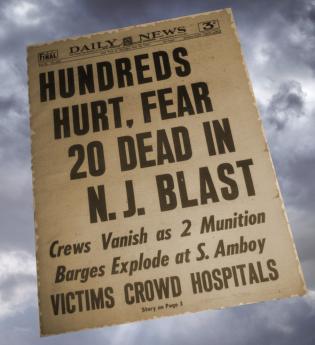 On May 18, 1950, South Amboy, New Jersey blew up, breaking windows of five counties in its neighborhood.
On May 18, 1950, South Amboy, New Jersey blew up, breaking windows of five counties in its neighborhood.
Stephen Girard 1750-1831
 Stephen Girard was blind in one eye and never went to school. But he was a successful sea captain, then a successful merchant, then a successful banker. In the last year of his life, he grasped the essence of the Industrial Revolution, made a successful plan for the next century, and wrote a truly remarkable will.
Stephen Girard was blind in one eye and never went to school. But he was a successful sea captain, then a successful merchant, then a successful banker. In the last year of his life, he grasped the essence of the Industrial Revolution, made a successful plan for the next century, and wrote a truly remarkable will.
Sullivan's March
 With Washington beleaguered at Valley Forge, an Indian massacre of the nearby Wyoming Valley was a serious threat from the rear. General Sullivan was sent to exterminate the Iroquois, and proved utterly ruthless.
With Washington beleaguered at Valley Forge, an Indian massacre of the nearby Wyoming Valley was a serious threat from the rear. General Sullivan was sent to exterminate the Iroquois, and proved utterly ruthless.
Swashbuckler
Your author is probably the only person still alive who attended the Senate hearing of Howard Hughes. There is probably a lot to this story yet to emerge.
Taking Care of Our Veterans
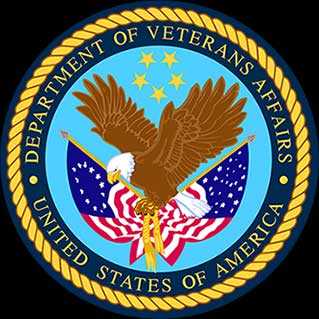 With programs to treat most any service-related affliction, the Philadelphia offices of the Department of Veteran's Affairs is a busy center for our freedom fighters.
With programs to treat most any service-related affliction, the Philadelphia offices of the Department of Veteran's Affairs is a busy center for our freedom fighters.
Second Amendment: The 28th Infantry Division
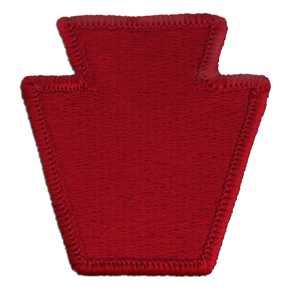 Seldom regarded as a warlike state, Pennsylvania has one of only eight reserve divisions of the U.S. Army and the oldest.
Seldom regarded as a warlike state, Pennsylvania has one of only eight reserve divisions of the U.S. Army and the oldest.
The Battle of Germantown: Oct. 3, 1777

The Pennamite Wars: Who Had The Last Word?
 When we shifted from a King to a Republic, we created novel problems reconciling the two theories of continuous ownership of land. The courts did their mystifying best, we suppose.
When we shifted from a King to a Republic, we created novel problems reconciling the two theories of continuous ownership of land. The courts did their mystifying best, we suppose.
The Richest Men in America
 In ten minutes, you can walk between the Society Hill homes of Robert Morris, William Bingham, Stephan Girard, and Nicholas Biddle.
In ten minutes, you can walk between the Society Hill homes of Robert Morris, William Bingham, Stephan Girard, and Nicholas Biddle.
The Third Pennamite War (1778-1784)
 Connecticut and Pennsylvania stopped fighting during the Revolution, but then promptly resumed hostilities. The Decision of Trenton gave the prize to Pennsylvania, whose legislature promptly abused the helpless remaining Connecticut settlers.
Connecticut and Pennsylvania stopped fighting during the Revolution, but then promptly resumed hostilities. The Decision of Trenton gave the prize to Pennsylvania, whose legislature promptly abused the helpless remaining Connecticut settlers.
The Wyoming Massacre of July 3, 1778
 As the dominant Indian Tribe in Eastern America, the Iroquois were ruthless in war. Whether egged on by the British or for their own reasons, in 1778 they remorselessly wiped out the Connecticut settlers around Wilkes-Barre.
As the dominant Indian Tribe in Eastern America, the Iroquois were ruthless in war. Whether egged on by the British or for their own reasons, in 1778 they remorselessly wiped out the Connecticut settlers around Wilkes-Barre.
Thieves of Baghdad
 American troops recovered most of the antiquities looted from the Baghdad Museum, tracing many of them through the international black market. The museum turns out to have been secretly a private treasury.
American troops recovered most of the antiquities looted from the Baghdad Museum, tracing many of them through the international black market. The museum turns out to have been secretly a private treasury.
Veterans Hospital
 In spite of much effort and expense, Veterans hospitals are not typical of American healthcare.
In spite of much effort and expense, Veterans hospitals are not typical of American healthcare.
War Dance
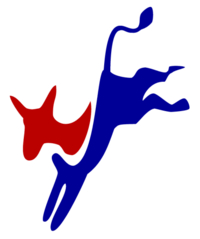 The Iroquois had politics figured out long before the White Man arrived
The Iroquois had politics figured out long before the White Man arrived
Washington Square
 All five of William Penn's city squares have proud and colorful histories . Washington Square, however, tops them all. It's had prisons, fish ponds, cemeteries, mansions, and skyscrapers.
All five of William Penn's city squares have proud and colorful histories . Washington Square, however, tops them all. It's had prisons, fish ponds, cemeteries, mansions, and skyscrapers.
What Happened in Philadelphia on July 4, 1776?
 There were about 30,000 residents, just a small town, but it was the second largest city in the English-speaking world. Aside from wagons, there were thirty wheeled vehicles. But this is the town where decisions were made.
There were about 30,000 residents, just a small town, but it was the second largest city in the English-speaking world. Aside from wagons, there were thirty wheeled vehicles. But this is the town where decisions were made.
Fort Washington, PA
 Fort Washington PA was never much of a fort, and nothing of it remains to be seen. Rather, it was mostly a large campground north of Philadelphia between the Battle of Brandywine and the Battle of Germantown. An interesting visit, nonetheless. A side-visit to Hope Mansion would add some local color.
Fort Washington PA was never much of a fort, and nothing of it remains to be seen. Rather, it was mostly a large campground north of Philadelphia between the Battle of Brandywine and the Battle of Germantown. An interesting visit, nonetheless. A side-visit to Hope Mansion would add some local color.
Not a Single Red Knot
 Between the Dover Air Force Base and the west bank of the Delaware River is a large area of wetland and fertile soil centered on what is called the Bombay Hook. Benjamin Chew, Caesar Rodney, and John Dickinson all had extensive plantations there. In some ways, remarkable wealth is all centered on the fertility deposited over the centuries by the eggs of horseshoe crabs along the bank
s of the river.
Between the Dover Air Force Base and the west bank of the Delaware River is a large area of wetland and fertile soil centered on what is called the Bombay Hook. Benjamin Chew, Caesar Rodney, and John Dickinson all had extensive plantations there. In some ways, remarkable wealth is all centered on the fertility deposited over the centuries by the eggs of horseshoe crabs along the bank
s of the river.
Beaumarchais: A Playwright Brings France into the American Revolution
 Pierre-Augustin Beaumarchais, the author of the classic opera, The Barber of Seville was also a crucial financial and ideological supporter of the Revolutionary War.
Pierre-Augustin Beaumarchais, the author of the classic opera, The Barber of Seville was also a crucial financial and ideological supporter of the Revolutionary War.
Battle of Monmouth
 The British Army evacuated Philadelphia in June 1778, retreated across the narrow waist of New Jersey for the safety of their Navy at Sandy Hook. Washington caught up with them at Monmouth and fought a very creditable battle.
The British Army evacuated Philadelphia in June 1778, retreated across the narrow waist of New Jersey for the safety of their Navy at Sandy Hook. Washington caught up with them at Monmouth and fought a very creditable battle.
State in Schuylkill Fishing Club
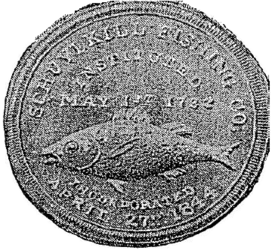 Unless you listen to some quibbles from White's in London, the Schuylkill Fishing Club of the State in Schuylkill is the oldest organized men's club in the world. And even if that exception is admitted, it's the oldest men's club in America. It's no secret, but it's very private.
Unless you listen to some quibbles from White's in London, the Schuylkill Fishing Club of the State in Schuylkill is the oldest organized men's club in the world. And even if that exception is admitted, it's the oldest men's club in America. It's no secret, but it's very private.
Espionage in the Revolution
 Almost everyone in the American Revolution could speak English, so it is not surprising to hear of many spies.
Almost everyone in the American Revolution could speak English, so it is not surprising to hear of many spies.
U.S. Army Corps of Engineers in the Delaware Valley
 The Delaware division of the Corps of Engineers is dwindling away. The engineers don't know nuttin', but they say on the street, Jimmy Carter did it.
The Delaware division of the Corps of Engineers is dwindling away. The engineers don't know nuttin', but they say on the street, Jimmy Carter did it.
Army War College in Carlisle
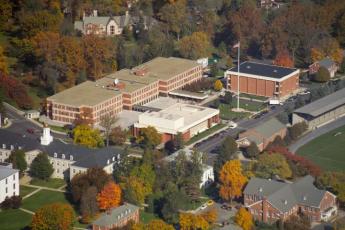 If you have been to Carlisle, PA, you have seen the Army War College, but you may not know much about it.
If you have been to Carlisle, PA, you have seen the Army War College, but you may not know much about it.
Honoring the Fallen
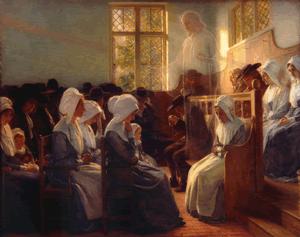 Two of Philadelphia's most honored institutions, Quakerism and the First City Troop, are in conflict.
Two of Philadelphia's most honored institutions, Quakerism and the First City Troop, are in conflict.